- SOUTH AFRICA
- CENTRAL AMERICA
- ESPIRITO SANTO
- MATO GROSSO DO SUL
- MINAS GERAIS
- RIO DE JANEIRO
- FALKLAND ISLANDS
- SUSTAINABLE TOURISM
- EXCHANGE PROGRAM
- GET INSPIRED
- HEALTH & WELLNESS
- NOMADIC LIVING
- PHOTOGRAPHY
- TRAVEL CLOTHING AND GEAR
- LIVE MORE, TRAVEL MORE
- ABOUT ELAINE
- SERVICES & CONTACT
- COUPONS & DISCOUNTS 💰
- Salvador, Brazil: A complete travel guide with the top things to do

Everything you have to know to plan your trip to Salvador, Bahia: How to get there, what to do, touristic points schedule and even how to practice sustainable tourism in the city.
Did you know that besides being Bahia’s capital, Salvador was the first Brazilian capital as well ? In this complete guide, you will find even more curiosities, tips about what to do in Salvador, touristic points information, museums and churches of the city.
Traveling to Salvador is an opportunity to learn about the history of Brazil. Understand the strength of these people, getting to know more about their religion, gastronomy, and musical resistance brought by the African people who were enslaved, or even learning about the story of Sister Dulce (Irmã Dulce), a saint that never give up on the poor and sick people, even in the most challenging moments.
I never thought that I’d love that city so much. We were there for about 1 month and it was not enough to know everything. That’s why I recommend staying there for at least a week, so you can get to know this charming and welcoming place well.
To some people, a trip to Salvador it’s an opportunity to have some fun in Carnaval or take a colorful photo in Largo do Pelourinho. But, I invite you to make this a transforming and learning journey.
Table of contents
Where is salvador, weather in salvador, how to get to salvador and know the city, general information, 1) get to know salvador’s main tourist attractions, 2) relax on the edge of salvador beaches, 3) strengthen your faith, 4) go for the bahian cuisine, 5) enjoy the sunset, 6) visit museums in salvador, 7) enjoy the benefits of salvador’s best neighborhoods, 8) volunteer in salvador – brazil, 9) immerse yourself in salvador’s culture, 10) get to know the region’s markets, 11) observe the artistic works of salvador, 12) experience salvador carnaval, what to do at night in salvador, what to do in salvador in the rain, what to do near salvador, what not to do in salvador, curiosities, what to bring to salvador.
Salvador is a Brazilian city in the northeast of the country, in Bahia state. This coastal city is just over 400 miles from Porto Seguro and almost 1.300 miles from São Paulo and more than 990 miles from Rio de Janeiro .
See where is Salvador on the map :
When to go to Salvador, Bahia
You can visit Salvador any time of the year, considering that the average temperature in the city varies between 75ºF and 80°F (or 24°C and 27°C as celcius is the unit of temperature we use in Brazil) and water is always warm. But, if you wanna escape from the rainy season it’s better to avoid traveling between April and July.
We were in Salvador between October and November 2021, it was the low season and it was perfect. At this time of the year and in the summer, it’s common that it rains a little, and then, just a few minutes later, the sky clears up as if not a single drop had fallen.
If you travel between December and March be aware that you’ll find high season prices. Do you wanna see and enjoy Carnaval in Salvador? Don’t forget to book your lodging in advance, once knowing this is the busiest season.
This pic shows how is the weather in Salvador during the year:
You can arrive in Salvador by plane , bus or car . If you are arriving from other cities of Bahia, even from other states as Sergipe or Alagoas, you can get the last two options. Otherwise, the best option is to take a flight to the Salvador Bahia Airport – Dep. Luís Eduardo Magalhães .
The Salvador bus terminal is located on Antônio Carlos Magalhães avenue, number 4.362 in the Pituba neighborhood, and it has a nearby subway station, the Bus Station.
The subway works very well, but unfortunately, it doesn’t pass through the principal touristic points. Even so, it is a good alternative for those who stay in a central region or for those who want to save money by taking a subway from the airport or bus station to the station closest to their accommodation and then a city bus or Uber.
Salvador also has local buses. On this site, you can put your origin and destination and identify which line you should take and the bus schedule. The line that should help you the most is the one that goes from the airport to Praça da Sé . If you are looking for a more comfortable way to move in the city, you can choose to take a táxi or Uber . On my trip, the best transportation was Uber because of the cost x benefit.
LMTM tip: Will you take Uber or Taxi via the app? Like anyplace else, don’t forget to check the vehicle, the license plate, and the driver’s name before entering.
For those who love physical activity, the waterfront has several Itaú bicycle rental/return points.
Frequently doubts about Salvador:
In Salvador there are 2,9 million inhabitants, making it the most populous city in Bahia and the 4th most populous in Brazil.
As a fort, Salvador was built strategically by the Portugueses in the highest part of the hill so they could have a privileged view and to protect the city.
Salvador was founded on March 29, 1549. It’s one of the oldest cities in Brazil.
Like any big city in Brazil or in the world, we have to pay attention. Our tip is that you should avoid walking with cameras or with your cell phone on display. A fanny pack is highly recommended, because it is safer to save your belongings, and practical to take your cell phone and take a pic quickly. Buy an international eSIM to have Internet access to check information, book a safe ride, etc. Avoid walking at night in places without movement, it’s better to take precautions, isn’t it?😉
What to do in Salvador
There is much more that you can do in Salvador than you can imagine! With this guide, you can find the best attractions, tourist points, and experiences that the city can offer you. Check it out!
View this post on Instagram A post shared by Elaine Villatoro 🇧🇷 · Viagem (@livemoretravelmore)
Mercado Modelo
The Mercado Modelo is in the lower part of the city and it is one of the entrances to the Historic Center. It is great for those who want to buy handicrafts and also taste delicious typical Bahian cuisine at its restaurants.
LMTM tip: We proved vegetarian moqueca in the restaurant Camafeu de Oxóssi and it was divine!
Ticket: Free of charge
Hours: from Monday to Saturday – from 9am to 6pm / Sunday – from 9am to 2pm
Address: 250, Praça Visconde de Cayru – Comércio
Contact: +55 (71) 3242-5860 / +55 (71) 3242-5860
Site: https://www.mercadomodelosalvador.com/
Elevador Lacerda
The Elevador Lacerda is the first urban elevator in the world, connecting the lower and upper cities. It’s located in the Baía de Todos os Santos and it has a beautiful view, perfect for taking photos.
Ticket: R$0,15 *
Hours: (During the pandemic) from Monday to Friday – from 7 am to 5:30 pm / Saturday – from 8 am to 5 pm
Address: Praça Cairu in the lower city, and Praça Tomé de Sousa in the upper city
Site: http://mobilidade.salvador.ba.gov.br/
Praça da Sé
This is a square that has generated controversy during its history. It used to house the old temple of the Sé Primacial of Brazil, built in 1553 and demolished in 1933 to make room for cable cars.
Today, it is a large sidewalk that houses other historical monuments such as the Memorial to the Baianas do Acarajé and the Zumbi dos Palmares.
Largo do Pelourinho
The word pelourinho means pillory that refers to a large stone where slaves were punished. Today, the plaza and the neighborhood represent the history of the black struggle, which beautifully takes over the streets and buildings, bringing strong colors, flavors, music, and religious manifestations to the place.
Farol da Barra
Imagine a place that lived all Salvador history: this is Farol da Barra .
This tourist spot in Salvador deserves a mandatory stop. Either to visit the Nautical Museum inside the build or to enjoy the landscape during the sunset.
Miguel Santana’s Theater and Balé Folclórico
This theater is the house of Balé (Ballet) Folclórico da Bahia since 2014. Besides the daily shows, the group also develops social projects such as Balé Junior – ballet for children. It is an amazing opportunity to learn about Brazilian folkloric dance with African roots.
Ticket: For now, because of COVID-19, the activities are happening online on Instagram .
Hours: from Wednesday to monday – 8pm
Address: 49, Gregório de Matos street – Pelourinho
Contact: +55 (71) 3322-1962
Site: https://www.balefolcloricodabahia.com.br/
Casa do Olodum
If you are Brazilian it is hard to think about Salvador and not remember about Olodum! The group that participated in clips of famous singers like Michael Jackson, Paul Simon and Jimmy Cliff, goes beyond the role of a band, disseminating education and culture. Take advantage of your visit to Pelourinho to visit Casa do Olodum , where you will find instruments and souvenirs of the band for sale.
Tickets: Free
Hours: from Monday to Saturday 8am to 6pm / Sunday 10am to 5pm
Address: 22, Maciel de Baixo street – Pelourinho
Contact: +55 (71) 99241-4086
Site: https://olodum.com.br/
Farol de Itapuã
Brazil’s most popular lighthouse is also a tourist attraction in Salvador. The 21-meter tower has this name because it is located on Praia de Itapuã .
Important! The inner area of the Farol de Itapuã is not open to visitors.
LMTM tip: This isn’t the most beautiful beach in Salvador (in my opinion), because of that, my advice is for you to make a quick visit here.
Address: Farol de Itapuã street – Itapuã
Ponta do Humaitá
On this charming spot you can find an architectural conglomeration, including the Church and Monastery of Monte Serrat and the Farol of Monte Serrat . Here one can enjoy a beautiful sunset and try the Bahian cuisine.
Address: 56, Boa Viagem street – Monte Serrat
If you are in doubt about what to do in Salvador on a sunny day, don’t worry. The beaches in the Bahian capital provide a variety of activities.
Go diving or stand-up paddling at Porto da Barra beach, learn how to surf at Praia do Flamengo, relax and have a good drink at the Blue Praia Bar at Buracão beach, eat a “coalho” cheese with molasses at Praia da Barra or ride a bike along the shore.
Check our article about the best beaches in Salvador, Brazil !
LMTM tip : Before getting into the water, check the water quality. You can confirm this information on INEMA website or through an updated Google search.
It can be in some of the 372 catholic churches or in some terreiro, a space dedicated to the candomblé’s orixás, the faith is part of the Bahian culture. See where you can strengthen your faith in Salvador:
Igreja do Senhor do Bonfim
Maybe you already know the ribbon of Bonfim, it is an icon in the Bahian city, but do you know where they come from? Know the Basílica do Senhor do Bonfim . You can visit the basilica, the local museum or hang your prayer ribbons on the external bars of the place.
Hours: from Monday to Wednesday and Saturday – 6:30 am to 6 pm / Friday and Sunday – 5:30 am to 6 pm.
Address: Praça Sr. do Bonfim – Bonfim
Contact: +55 (71) 3316-2196
More information: Facebook of Basílica Santuário do Senhor do Bonfim
Be moved in Memorial Irmã Dulce
A nun from Bahia canonized by the Vatican, Irmã Dulce had a huge impact in the community through your charity work . In the Memorial Irmã Dulce you can learn about her story, see her bedroom that is still intact, as well as other items that have marked her history.
Tickets: Free (Schedule is necessary)
Address: 161, Dendezeiros do Bonfim avenue – Bonfim
Contact: +55 (71) 3310-1923
Site: https://www.irmadulce.org.br
Igreja e Convento de São Francisco
Considered one of the Seven Wonders of Portuguese Origin in the World , Igreja e Convento de São Francisco is a baroque art building, exuberant and unique in details, such as Portuguese tiles, detailed sculptures, and fully worked walls and ceilings.
There you can find an interesting contrast between the Franciscan ideas of simplicity and the big luxury of the churches.
Tickets: R$ 5,00 *
Hours: Monday, Thursday, Wednesday, Friday, and Saturday – 9 am to 5:30 pm
Address: Largo do Cruzeiro de São Francisco – Pelourinho
Contact: +55 (71) 3322-6430
Igreja Nossa Senhora do Rosário dos Pretos
The Irmandade Nossa Senhora do Rosário dos Pretos is an important confraternity created by blacks to ensure their religiosity. The church in Salvador was founded in 1685 and built in 1704.
On Tuesdays at 5 pm you can check out during a mass an unmissable union between Catholicism and Candomblé.
Ticket: R$ 5,00 *
Hours: Visit – from Monday to Friday – 8 am to 12 pm and 1 pm to 5 pm / Saturday – 8 am to 7 pm
Address: Largo do Pelourinho, s/n – Pelourinho
Contact: +55 (71) 3421-5781
Casa de Yemanjá
Iemanjá is an really important Orixá patroness of fishermen, worshiped especially in Salvador. On February 2nd, Rio Vermelho beach receives devotees from all over Brazil to throw offerings to the sea.
But you don’t have to wait until this day to know this little and powerful house, it is open the whole year with offerings and prayers in Rio Vermelho neighborhood.
LMTM tip: Do you wanna know why February 2nd is considered the day of Iemanjá? Watch our stories about Salvador .
Address: 143, Guedes Cabral street – Rio Vermelho
Leave your diet aside and enjoy the delights of Bahia. In moderation, of course. 😅.
Traditional food
The Bahian food is delicious and unique. Taste acarajé, abará, moqueca, cocada, bolinho de estudante, pão delícia, caruru, mugunzá, and some others Bahia’s traditional food.
Don’t you know where to prove acarajé? The most famous are Acarajé da Dinha (my favorite) and Acarajé da Cira , both in Rio Vermelho.
In Pelourinho, don’t miss the lemon juice with coconut from Mr. Milton in front of Fundação Casa Jorge Amado, cachaça from Cravinho Bar , and cocada from Dona Júlia, this lady in the photo, who is always next to Igreja Nossa Senhora do Rosário dos Pretos.
It is really common to find Sorveteria da Ribeira in ‘what to do tips’ in Salvador. We were in four ice cream shops in the city, see our ranking:
- Crema – located in Largo de Santana, Rio Vermelho. Taste the flavours “Amarena” and “Ferrero Rocher”.
- Le Glacier La Porte – Largo do Cruzeiro de São Francisco
- Sorveteria da Ribeira – it’s only worth in the Ribeira’s unit, in the other ones the quality isn’t that good. Taste the flavor “Delícia de Abacaxi”.
- A Cubana – Multiple units all over Salvador.
Will not be a problem for you to find beautiful places to appreciate the sunset in Salvador .
In the highest touristic points as Elevador Lacerda, on the beach or at Farol da Barra, on the balcony of one of the bars of Santo Antônio Além do Carmo, listening to good jazz (Saturdays) or practicing a yoga class for free (Sundays) in the back of MAM (Modern Art Museum), and, who knows, in not much known places as Mirante Wildberger or Larri Bistrô in the Aliança Francesa at Corredor da Vitória.
Jorge Amado, one of the biggest Brazilian writers, was born in the South of Bahia and finished his studies in Salvador. His regionalist works have been portrayed in television and cinema.”
“Inaugurated on March 7, 1987, the Fundação Casa de Jorge Amado, was idealized and instituted with the objective of preserving and studying the bibliographical and artistic collections of the writer Jorge Amado, as well as encouraging studies and research above all literature made in Bahia.” – Fundação Casa do Jorge Amado. (free translation)
Hour: from Monday to Friday – 10am to 6pm / Saturday – 10am to 4pm
Address: 49/51, Portas do Carmo street – Largo do Pelourinho
Contact: +55 (71) 4103-0081
Site: https://www.jorgeamado.org.br/
Museu Afro-Brasileiro (MAFRO)
The museum is impressive because of the beauty of its facade. It is an important collection about African and Afro-Brazilian history.
It counts with some fixed exhibitions, as Carybé and his 27 wood carvings representing the candomblé’s orixás, and MAFRO also receives temporary artworks.
Hours: TEMPORARY CLOSED
Address: Largo do Terreiro de Jesus, Bahia Medical School building – Historic Center of Salvador
Contact: +55 (71) 3283-5540
Site: http://www.mafro.ceao.ufba.br
Cidade da Música da Bahia
Between Mercado Modelo and Elevador Lacerda, Cidade da Música da Bahia is a museum that counts with a rich history of Bahian music. All the exhibition is audiovisual and it brings the musical context of the city in general, the musical styles that exist there, and it also has interactive rooms with karaoke, rap and trap battles, and other attractions.
Ticket: R$ 20 * – SCHEDULING REQUIRED
Hours: from Tuesday to Sunday – 10am to 6pm, with entrance until 5pm.
Address: 19, Praça Visconde de Cayru – Comércio
Contact: +55 (71) 3106-4659 Site: https://cidadedamusicadabahia.com.br/
LMTM tip : Visit first the museum and then the Casa do Carnaval, it will make more sense.
Museu de Arte Moderna da Bahia – MAM
Museu de Arte Moderna da Bahia (MAM) is a spectacle inside and out. Located in Solar do Unhão, it has a wonderful view, a sunset worthy of an art piece, in addition to its external sculptures, five internal exhibitions and a cinema.
Ticket: Free
Hours: from Monday to Friday – 9 am to 12 pm and 1 pm to 4 pm
Address: Lafayete Coutinho avenue – Comércio
Contact: +55 (71) 3117-6132
Site: http://www.mam.ba.gov.br/
Casa do Carnaval da Bahia
One of the most traditional street Carnaval parties in Brazil, Salvador usually brings to its streets people from all over the world that follow the blocos de axé – a group of people that follow the band through the street. The Bahian Carnaval is unique and that is why there is a museum just to talk about this festivity. Know the history and have fun with carnaval artifacts in Casa do Carnaval da Bahia .
Ticket: R$ 20 * / On Wednesday is free with scheduling
Hours: from Tuesday to Sunday – 10 am to 6 pm
Address: Praça Ramos de Queirós – Pelourinho
Contact: +55 (71) 3324-6360
Site: Instagram
Memorial das Baianas do Acarajé
During your trip, you will find the very traditional Baianas do Acarajé . These women and acarajé – a kind of stuffed fritter – go beyond cooking, carrying a history of symbolism and resistance through the clothes on the body and the flavors on the plate.
Get to know this memorial made especially to tell the history and honor Baianas do Acarajé.
Hours: CLOSED FOR RENOVATION, EXPECTED TO REOPEN IN DECEMBER 2021.
Address: Cruz Caída, Praça da Sé – Pelourinh o
Contact: +55 (71) 3322-9674
LMTM tip: Do you wanna know why women from Bahia dress like that? Check out our stories in Salvador .
Museu Geológico
If you set aside a day to walk around the Corredor da Vitória , take time to visit the Museu Geológico . It is a perfect tour for those who want to know the history of Earth marked on its stones, with a special touch of being focused on the Bahian region.
Hours: from Tuesday to Friday – 1 pm to 6 pm / Saturday and Sunday – 1 pm to 5 pm (In case that you want a guided visit, scheduling is necessary, send an email to [email protected] )
Address: 2195, Sete de Setembro avenue – Corredor da Vitória
Contact: +55 (71) 3336-3498
Site: http://www.mgb.ba.gov.br/
Ps: I’ve heard that inside of the museum has a delicious coffee. ☕
Memorial e Fundação Pierre Verger
Pierre Verger was a French photographer and an anthropologist extremely important for studying and recording Afro-Brazilian culture, especially the religious aspects of candomblé. Want to know more about his work? Visit the Pierre Verger Memorial or the Galeria do Pelourinho for free.
LMTM tip: I recommend the book Orixás by Pierre Verger.
Memorial Pierre Verger : The house that Verger lived in.
Hours: from 8 am to 12 pm (Scheduling is necessary)
Address: 6, 2ª Travessa da Ladeira da Vila América – Engenho Velho de Brotas
Contact: +55 (71) 3203 8400
Site: https://www.pierreverger.org
Fundação Pierre Verger Galeria
Hours: from Monday to Saturday: 9am to 7pm
Address: 9 – store 1 – Portal da Misericórdia (Near by Pelourinho)
Contact: +55 (71) 3321 2341
Espaço Carybé de Artes
Despite being from Argentina and having walked in many places before arriving in Salvador, Carybé won the heart of the Bahian city. His art is vibrant and heavily influenced by candomblé. In this space, you can see a virtual collection.
Note: Every day from 6:15 pm until 7 pm his works are exhibited on the building’s facade.
Ticket: R$ 20 * – Wednesday for free
Hours: Wednesday to Monday – 11 am to 7 pm
Address: Forte de São Diogo – Porto da Barra
Contact: [email protected]
Site: https://www.instagram.com/espacocarybe/
Memorial Casa Di Vina
Don’t know what to do in Itapuã beach in Salvador? Visit the memorial of Vinicius de Moraes, located in the house where he lived with the Bahian actress Gessy Gesse at the beginning of the ’70s.
The memorial can be accessed through Casa Di Vina Restaurant. It contains a collection full of photos and objects of the poet and his wife, besides the paintings that tell stories and curiosities of the period in which they lived there.
Hours: from Monday to Sunday – 12pm to 10pm
Address: 44, Flamengo street – Farol de Itapuã
Contact: +55 (71) 3285-7339 / WhatsApp: +55 (71) 99711-3374
Site: https://www.casadivinabahia.com.br/
Casa do Rio Vermelho
The house where Jorge Amado and Zélia Gattai lived was transformed into a museum with an amazing collection and videos full of stories. This is also where his ashes were deposited according to the couple’s wishes.
Ticket: R$20 *
Hours: from Tuesday to Sunday, 10 am to 6 pm. Entrance until 5 pm
Address: 33, Alagoinhas street – Rio Vermelho
Contact: +55 (71) 3104-4659
Site: http://casadoriovermelho.com.br/
Museu Náutico da Bahia
If you love traveling, can’t miss the Museu Náutico da Bahia . The museum presents part of Brazil’s history by displaying pieces of ships and crew members’ utensils that were submerged for about 300 years.
Ticket: R$ 15
Hours: from Monday to Sunday – 9 am to 6 pm
Adress: Largo do Farol da Barra, s/n – Forte de Santo Antônio da Barra – Barra
Contact: +55 (71) 98890-0964
Site: https://www.museunauticodabahia.org.br/
Santo Antônio Além do Carmo
Next to the Centro Histórico (Historic Center), Santo Antônio Além do Carmo is a charming neighborhood. There you will find a lot of beautiful baroque old buildings.
There you can walk until Largo do Carmo – where you have a view to Baía de Todos os Santos -, visit churches and enjoy the bars and local business.
This is my favorite neighborhood to have a beer in the late afternoon while watching the sunset from the balcony of one of the bars in the area, like Bar Cruz do Paschoal , Poró Restaurante & Bar , Raiz Restaurante , and others.
The neighborhood goes from Largo do Pelourinho until Terreiro de Jesus.
Take a whole Saturday or Sunday to walk by Pelourinho. Besides calmly enjoying the region’s museums, take the opportunity to enter in the stores, and drink Mr. Milton’s lemon juice with coconut , dance, and sing with Movimento Percussivo and eat a cocada, acarajé or Dona Julia’s bolinho de estudante.
Rio Vermelho
Staying at and walking around the most bohemian neighborhood of Salvador is a pleasant experience!
In Largo de Santana , besides finding Igreja de Santana and Jorge Amado and Zélia Gattai sculptures, you can delight yourself with Acarajé da Dinha, drink a cold beer at Parador Z1 or also enjoy my favorite ice-cream parlor, Crema Gelato Italiano.
Still in Rio Vermelho, you can find Casa de Yemanjá , Buracão beach where you can visit Blue Beach Bar, Casa Castanho with its excellent coffee, Casa de Jorge Amado , Largo da Mariquita and the trendy EcoSquare.
The best way to get to know a destination in depth is to experience the day-to-day life of the locals. The Worldpackers volunteer work exchange makes this possible.
Here’s how Worldpackers works !
You can apply for various types of volunteer work in Salvador , such as working in a hostel in Praia da Barra or even participating in an environmental volunteer project in the region.
We participated in an agroforestry experience in a neighboring municipality, check out our experience:
Going to Salvador is an excellent opportunity to learn about afro-Brazilian culture. If you want to awaken your black consciousness, there are several tours with this focus that are organized by Guia Negro !
We participated in the Caminhada Salvador Negra. If there is a mandatory tour in Salvador that everyone should do, I would say that this is the one.
Ticket: Starting at R$ 50 per person*. Details are available at the site below.
Contact: +55 (11) 99279-4902 (WhatsApp)
Site: https://guianegro.com.br/
Visit a “terreiro de candomblé”
Religious syncretism is more present in our culture than most of us can imagine. Sayuri, the guide, can take you to a candomblé (Afro-Brazilian religion) temple and answer your questions.
Contact: +55 (71) 99113-8033 (WhatsApp)
Capoeira Class
This practice, which was once forbidden in Brazil, is now a national symbol. How about burning some calories with the sound of the berimbau while connecting to Afro-Brazilian ancestry?
We took the class with Mestre Bamba at the Associação de Capoeira Mestre Bimba .
Ticket: R$ 50 *
Address: Rua das Laranjeiras, n° 01, Pelourinho. 1° Andar
Contact: +55 (71) 3322-0639 (WhatsApp)
Site: https://www.capoeiramestrebimba.com.br/
Percussion Class
The atabaque and berimbau are very present in the rodas de samba and rodas de capoeira (roda is a practice where people stay in circle playing and dancing) in the Recôncavo Bahiano. How about learning how to play some rhythms on this instrument?
We did our class in the Associação de Capoeira Mestre Bimba , with Pezão.
Ticket: R$ 45*
Address: 01, Rua das Laranjeiras street – 1st Floor – Pelourinho
Contact: +55 71 3322-0639 (WhatsApp)
See a capoeira presentation
Finding a capoeira presentation isn’t that hard in Salvador. But, if you wanna add this experience to your route, you can plan to go to Forte do Santo Antônio Além do Carmo , there they have a project called Capoeira no Forte that it has the objective to promote the Bahian’s culture and art.
Hours: from Wednesday to Sunday – 4 pm to 6:30 pm
Address: Largo de Santo Antônio Além do Carmo – Santo Antônio
Besides Mercado Modelo, Salvador counts with other markets that offer an explosion of flavors and different options of craftsmanship:
Mercado Rio Vermelho
Recommended for those who are staying in the Rio Vermelho neighborhood . The prices are not very advantageous and I particularly did not find anything special. But still, this is an option.
Hours: from Monday to Saturday – from 7am to 7pm / Sunday – from 7am to 2pm
Address: 1624, Juracy Magalhães Júnior avenue – Rio Vermelho
Contact: +55 (71) 3018-5733
Site: http://www.mercadodoriovermelho.com.br/
Feira de São Joaquim
This is the cheapest market in Salvador. If you want to buy cooking ingredients, candomblé articles, clothes, etc, this is the ideal place for it.
We received a very good tip from a follower, a tour that involves visiting the fair & a traditional cooking class . If I had known before, I would have done it.
As a content creator, I’d love to photograph and film more here. But, unfortunately, I’ve not felt safe here. I’ve heard some rumors that it is common that thieves take the cellphones from the hands of tourists and escape in the little halls of the fair. A really important tip, stay in the main streets of the market.
Hours: from Monday to Saturday – 5am to 6pm / Monday – 5am to 2pm
Address: Engenheiro Oscar Pontes street – Água de Meninos
Dique do Tororó
Close to the Fonte Nova Arena is Dique do Tororó , a dam that was built in the 17th century and served as protection against invasions. As Salvador grew, it was gradually filled in and today it has a lake with 110,000 cubic meters of water. The most beautiful thing here is to admire the sculptures of 12 orixás created by the artist Tatti Moreno.
Note: I have heard that this region is dangerous, so be careful with your belongings.
Address: 212, Vasco da Gama avenue – Engenho Velho de Brotas
As Meninas do Brasil
These are three sculptures that represent the races that make up the Brazilian people: the black, the white, and the indigenous. Created by the Bahian artist Eliana Kertéz, “As Meninas do Brasil” are also known as “As Gordinhas da Ondina” , the neighborhood where they are located.
Address: 19, Adhemar de Barros avenue – Ondina
Morro do Cristo
The area to the left of Barra Beach bears a statue of Jesus Christ sculpted in marble. Take a rest on the lawns and enjoy the bars around Morro do Cristo and the privileged view of the Barra Lighthouse and the seashore.
Address: Oceânica avenue – Barra
Zumbi dos Palmares
The bronze statue made by artist Márcia Magno pays tribute to Zumbi, the last of the leaders of the largest quilombo in Brazil during the colonial period, the Quilombo dos Palmares.
Address: Praça da Sé – Centro Histórico
Jorge Amado and Zélia Gattai
Also made by artist Tatti Moreno, the sculpture features Jorge Amado, Zélia Gattai, and the life-size dog Fadul in Largo de Santana, in front of the Santana Church.
Endereço: Largo de Santana – Rio Vermelho
Ah, Salvador Carnaval ! I still haven’t had the opportunity to feel this emotion, which can only be experienced when the pandemic finally ends.But, for now, it remains my and your wish to one day be able to follow a trio on one of the famous circuits . By the way, who would you most like to see playing? At the top of my list are: Olodum, Saulo Fernandes, and Bell Marques.
Are you in doubt of what to do in Salvador at night? Options will not be lacking! These include:
- Dendê Salvador
- Vila Jardim dos Namorados
- Rooftop 180 Graus
- Largo de Santana
- Largo da Mariquita
Take the opportunity to visit the most diverse museums in Salvador, meet friends in the bars of Santo Antônio Além do Carmo, visit the main churches in the region, and enjoy the best of Bahia’s gastronomy.
Check out some other destinations in Bahia and approximate distances from Salvador:
- Ilha de Itaparica (13km)
- Ilha dos Frades (26km)
- Ilha de Maré (38km)
- Ilha Bom Jesus dos Passos (63km)
- Morro do São Paulo (63km)
- Boipeba (86km)
- Lauro de Freitas (30km)
- Guarajuba (70km)
- Itacimirim (78km)
- Praia do Forte (83km)
- Imbassaí (90km)
I decided to dare and share some things that I thought were not very worth doing in Salvador or that I had very negative references from people I met:
- Lagoa do Abaeté : Although it seems to be very beautiful, at least three local people in Salvador recommended that I should not go there, especially not alone, because it is a place that has been abandoned by the city and it has become dangerous.
- Shopping Salvador : Do not plan to arrive or leave the mall during rush hour. Since it is centrally located, there is a lot of traffic between 6-7:30 pm.
- Praia de Itapuã : This was the beach where I saw the most garbage in Salvador. Several locals also told me about the lack of security there, which made me apprehensive while I was staying there. If you want to visit it, set aside 2/3 hours just to see the Itapuã Lighthouse and visit the Vinícius’ House.
- From 1549 to 1763, Salvador was the capital of Brazil
- 80% of the population of Salvador is black
- The first name of Salvador was “São Salvador da Bahia de Todos os Santos
- Salvador has appeared in several international video clips, such as: Michael Jackson – They don’t care about us, Paul McCartney – Back In Brazil, Paul Simon – Obvious Child
Here are some extra tips for you to make the most of your trip to Salvador. Check them out:
Study about the destination
Study about some events and characters from Salvador that were important for the city’s history, such as: Neguinho do Samba , Irmã Dulce , Luís Gama , Dorival Caymmi , Mãe Menininha do Gantois , Mestre Bimba, Batatinha , Carlinhos Brown.
We also recommend that you watch these documentaries:
- Axé – Canto do Povo de Um Lugar
Respect, always!
Many Bahian women, capoeiristas, and musicians make their living from donations and sales of handicrafts and services to tourists. Some start the approach by offering a photo, bracelet, or even a painting of Timbalada as a gift, but in the end, they will ask for a financial contribution.
If you don’t want to, just thank them at the beginning of the conversation and say you’re not interested. Otherwise, a R$5 tip is an ok amount to admire a song or take a picture. To make your life easier, already separate the change before going to Pelourinho or the Igreja do Bonfim.
Also, xenophobic jokes are not welcome! Not here, not anywhere else!
Be a responsible tourist
We always leave here some tips for you to leave as few footprints as possible in the destinations you pass through, and this Salvador guide will be no different. See how you can be a more sustainable tourist in Salvador:
- Save water: in the summer it is common to run out of water in the city, so don’t abuse it!
- Reduce your waste while traveling : Whether in the hotel, on the beach or while visiting the main tourist attractions in Salvador.
- Always have with you a glass, straw, cutlery, and a reusable bag.
- When ordering, tell the attendant that you don’t need a straw, spoon, etc. If you don’t tell them in advance, they will automatically put it in.
- Are you ordering ice cream? What about the ice cream cone?
- Make sure that your lodging has a selective collection. If not, you can look for a So+Ma drop-off point to dispose of your waste properly.
- Light clothing and if possible, sun protection
- Comfortable sneakers for walking among the sights of Salvador
- Natural sunblock
- Sun Glasses
- Fanny Pack (it is the most practical and safe item for walking in big cities)
- Kit with reusable utensils (cutlery, glass, straw, bag)
Forget jeans and know that here a cold sweater is something you only wear on the flight or when your roommate turns up the air conditioning.
Now that you know what to do in Salvador by day, by night, and even when it rains, and what the main tourist attractions, museums, and churches are, tell us… What will be the first thing you want to do when you arrive in Salvador?
Did you enjoy our free guide? Save the pin and leave a comment below
* The values mentioned are from November/2021 and are subject to change.
Note: This article was supported by Worldpackers.
- The best beaches in Salvador and surroundings
- Porto Seguro, Brazil: Your travel guide to the historic and paradisiac destination in Shouth Bahia
- Caraíva, Brazil: 17 things to do, where to stay, places to eat and much more
- Trancoso, Brazil: Find out what this magic district in Bahia has to offer!
You Might Also Like
Scuba diving at Laje de Santos
Caraíva, brazil: 17 things to do, where to stay, places to eat and much mo....
August 6, 2023
Good guide ! thanks
September 30, 2023
this’ll has been very helpful. I wish we could stay longer than the few hours from our cruise.
October 4, 2023
it is always good to have a reason to come back =)
Cancel reply
Accommodation.
- TRAVEL INSURANCE
AWARD WINNER: SUSTAINABLE TRAVEL BLOGGER
Recent posts.
- The best beaches in Salvador, Bahia
- Things to do in the Yucatán Peninsula
- 21 Best Mayan Ruins in Mexico
- Things to do in Maraú Peninsula and Barra Grande, Brazil
- Best travel pants for men? Western Rise!
- How much does a trip to the Maldives cost in 2024?
- Top 5 things to do in Oman
- Top 7 must-have outdoor clothing for men
- Bonete Beach, Ilhabela: How to get there, what to do and much more
- Perth, Australia: everything that you must know
- Snow clothes: What you need to know before packing
- Waterproof hiking boots or shoes: Which one is better?
- Top 10 essential travel clothes for men
Posts by Category
- DESTINATIONS
- TRAVEL RESOURCES
- MIDDLE EAST
- NORTH AMERICA
- TRAVEL GEAR
- TOURS & TICKETS
- SOUTH AMERICA
- NOMADIC LIFE
- UNITED STATES

The Ultimate Salvador Travel Guide: Explore Brazil Like a Local [2024]
Table of Contents
Salvador Brazil: A Quick Look
I don’t know about you, but for me, vacations have to balance relaxing and activities. I want it all! Beach days, radical sports, and even a little shopping.
If you are looking for a destination like that, one that’s sure to give you the best of all worlds, then follow me along in this Salvador travel guide. You can feel relaxed in this seaside atmosphere while enjoying a historical town with old-fashioned buildings.
But while I plan to write the ultimate Salvador travel guide, I also want to help you plan a stress-free trip. We will go over everything, including where to stay, what to do, and safety tips to adopt. If you plan on traveling to other places in Brazil and need an in-depth country guide, see our complete Brazil travel guide .
It is so easy to fall in love with Brazil when you come to one of the best cities we have. So put on your sunscreen, grab your bag, and let’s have fun together!
Side note: One of the main questions we get when planning a trip to our country is “When is the best time to visit Brazil ”, which you can read later.
Now, onto Salvador!
Salvador Brazil: Quick travel tips before you go
🛫 Airport: The closest airport to downtown, and the main state one, is International Salvador Airport, the code being SSA.
🤑 Currency : Like everywhere else in the country, the main currency here is the Brazilian Real, shown by the R$ symbol.
🗣️ Language: Salvador’s main language is Portuguese, but English is also spoken in some form at most hotels and tourist spots.
🕰️ Time Zone: Salvador’s timezone is in Brasília Standard Time (GMT-3). Meaning it is most often one hour ahead of EST and four hours ahead of PST.
💵 Cost: Our Salvador Travel guide talks about this more in-depth later, but rest assured, this trip is super affordable. Especially if you’re coming from a stronger currency like the US dollar, EURO, or Yen.
🛜 Internet: Because you will be in a state capital, it should be great! You are golden to access all the apps you may need.
📄 Brazil Visa: As of now, If you are traveling from the United States, Canada, Australia, or Japan, then NO. This could change as of October 1, 2023. Track the status and details here . You do NOT need a visa for EU Nationals, and you may not be affected by the Oct 1, 2023 change. You can see the details here .
🔌 Power Outlets: Outlets in Brazil have two plug types, C and N. C is the one with two round pins, and N has an additional one for grounding. For visitors from other countries, you’ll need something like this universal travel adapter .
🔋 Power Grid: The power grid in Salvador is very stable. But it is important to remember Brazil mostly operates on 127/220V voltage and 60Hz. While some newer buildings have a 220V grid, don’t count on it everywhere.
📳 SIM Card : If you aren’t sure whether to get a SIM card or not, think that you will probably need to use Uber or Maps; maybe you will want to upload a picture, so definitely get one! Also, check the data package is big enough.
🚘 Car Rentals: Although renting a car and learning about new traffic rules may seem complicated, our Salvador travel guide highly recommends considering it. It is your best choice to get around.
Salvador Brazil: Safety Travel Tips (Use Common Sense)
🍏 Food safety: Most foods are safe for consumption, even in those beachside stalls. Just avoid certain kinds from street vendors.
💧 Water safety: Tap water isn’t drinkable when unfiltered, but it’s good for everything else! Restaurants filter water for ice and drinks, so you’re good on that end, too. I recommend you keep a reusable bottle with you to avoid buying bottles all the time. You can also use a Water-To-Go Filterable Bottle . It is refillable but filters your water so you don’t get sick in Brazil.
👷♀️ Daytime safety: Daytime safety is pretty basic because petty theft is your main concern, as it’d be in all major cities. Just be careful with your belongings, and don’t have them out unless it’s necessary.
🦺 Nighttime safety: At night, use your common sense. Your valuables still need to be safely put away. As for being outside, it’s never recommended if you are by yourself, so use ride-sharing apps or rent a car .
👺 Avoiding scams: Scamming happens mostly during sales transactions, so prefer to buy tickets online from reputable websites. And in cabs, always make sure the meter is up and running.
Salvador Brazil Travel Tips: A Locals Perspective
⚠️ Stay Smart, Stay Safe: We talk about it a few times in this Salvador travel guide, but always use your common sense in big cities. My biggest tip as a solo traveler is to have your plans secure, including being back at the hotel early to ensure your safety. In new places, I am Cinderella: back home before midnight.
🏨 Best neighborhoods for tourists: Your main options are Historical Downtown (best central location), Red River District (best for nightlife), Santo Antônio Além do Carmo (best for groups and solo travelers), Ondina (best for couples), and Itapuã (best for families).
🎄 Top Brazilian holidays and traditions: Brazil’s major celebrations all have their space in Salvadors. This means you can celebrate Carnaval in February, Easter in March, Festa Junina in June/July, and the Holiday season in December.
🍜 Local food to try: Acarajé, Abará, Vatapá, Mugunzá, Cocada, Moqueca and Seafood.
🍹 Local drinks to try (alcoholic): Salvador has a number of unique cocktails to try in the bars, and since most of them are Cachaça based, you should try as many as possible.
🧉 Local drinks to try (non-alcoholic): Here, it’s all about the fruit juices! Other than that, there are Guaraná Axé, Açaí smoothies, and many more to try!
🚶♂️ Walkability: Salvador’s terrain isn’t as smooth as other northeastern cities. However, you can still walk to the place without care since it’s smoother around most popular tourist areas.
🎉 Nightlife: You’ve come to the right place! Salvador has a lot of options spread throughout the town and even neighborhoods where it’s all about the nightlife.
😀 Friendly to Foreigners: Salvador is used to receiving foreign tourists, so you are safe! Locals love to chat and share their culture with everyone.
🏥 Hospitals: Public health, especially in cases of emergency, is generally pretty great! Since it is better to be safe than sorry, also get good travel insurance.
🇺🇸 English speaking: Fluency is most commonly found in hospitality businesses, but you can find translations even in restaurant menus, too!
Salvador TRAVEL GUIDE
Where is salvador brazil located, salvador map .
Salvador, known to Brazilians as the ‘Capital of Cheer’ because of all the events and parties that happen in town, is a northeastern capital. Its unique location gives you fun all around the clock.
What State is Salvador In?
Salvador is nestled in Bahia’s coastal area, also serving as the state capital. Not only can you enjoy beautiful sand strips, but you’re also close to a number of amazing places if you decide to take a quick detour.
What’s the Closest Airport to Salvador Brazil?
Salvador International Airport (SSA) is the one closest to downtown, approximately 13 miles (22 kilometers) from it. So, it should be easy to cover the ground in a few different ways.
What is the Best Way to Get to Your Salvador Hotel?
Once your flight has landed at Salvador International Airport (SSA), there are four main ways to reach wherever you’re staying.
As your Salvador travel guide writer, the top recommendation is booking a private shuttle for a stress-free ride to the hotel. It drops you off at the door without the stress of figuring it out when you land.
Pro Tip: If you plan to take an Uber, ensure you have a Brazil SIM card so your phone operates appropriately. You never want to depend on free public WIFI for using your ride-share apps.
Way number three to leave the area is to get a taxi since there are always available vehicles, but they can be more expensive than ride-share apps. If you do get one, make sure the meter’s on.
But our Salvador travel guide’s second top recommendation is to rent a car . You will be glad to have your way to get around, and it’ll give you the ability to go even further.
Plus, if your trip includes the whole family, it’ll be better to rent a car than to split into different Ubers every time you have to go out.
How to Get Around Salvador?
Ride Sharing (top choice): Because this is a state capital and major city, there are enough drivers working with ride-share services. It is a cheap and convenient way to move; just have your mobile network functioning properly to avoid relying on public wifi.
Rent a Car (top choice): I just said it in our Salvador travel guide, but let me repeat it: rent a car! Sure, it’s a little more expensive, but it pays off by giving you the most freedom. With it, you can follow your own pace. Be sure you have all the necessary documents, and off you go!
Take a Taxi: Most Salvador travel guide writers forget to talk about taxis. They can be lifesavers in a pinch; I always take one if I get into town late at night. Check you are getting into a registered vehicle and that the meter is on before driving off.
Get on a Bike: Although this isn’t a great way to get around, our Salvador travel guide highly recommends taking a bike for a spin when in town. You can rent and even pay for lessons through scenic routes along the coast.
Public transportation: I wouldn’t say this should be your last resort, but it should be used carefully. Since you’re a tourist, peak times (early morning and late afternoon) are a no-no. If you plan on taking Uber, it might be smart to blend it with the subway system to make your budget stretch a little.
When to Go to Salvador?
Scheduling your trip is the moment that makes it real. It is about more than a vacation from work; it’s about us understanding when the place is at its best. So, for you to understand more about Brazilian seasons, keeping in mind they’re opposite from the northern hemisphere, here’s a little about each:
Salvador Brazil Summer (December to March): Seasons here don’t vary a lot in temperature and weather, but Summer is, without question, the time to be here! You will get festivals, parties, and amazing memories from your time here under the sun.
Summer Carnival: Carnival deserves a special topic because it is a category by itself. This nationwide party has something special in northeastern states, so if you want to enjoy it properly, start planning now.
Salvador Brazil Fall (April and May): Fall in Salvador doesn’t differ so much from other seasons except for the fact it rains a little more. Temperatures barely drop, so you still get great weather.
Salvador Brazil Winter (June to August):
Winter is the end of the wet season, so you may have to deal with rain more often. It still gets hot enough for beach days, so there’s nothing to fear.
Salvador Brazil Spring (September to November): Spring dries up the weather, and it’s considered a prime time to be here, according to Salvador travel guides. It is the moment for those who want a summer experience without the summer prices or crowds.
Of course, the final choice is up to you, but there is no going wrong with Salvador.
Where to Stay in Salvador Brazil? (By Neighborhood)
When you began reading our Salvador travel guide, you were probably waiting for the section talking about where to stay. Salvador has a few different areas for you to stay, depending on what’s your goal for the trip.
Your main options are Historical Downtown (best central location), Red River District (best for nightlife), Santo Antônio Além do Carmo (best for groups and solo travelers), Ondina (best for couples), and Itapuã (best for families).
As we just saw, your first step needs to be figuring out the goal for this trip. Do you want to dance the night away? Or are you hoping to sunbathe for hours? Once you have figured out what you want to do, think about who’s coming along since that can be a deciding factor, too.
Let’s check out each of them a little from up close.
Historical Downtown (Best Central Location)
As is the case with other major cities with a historical background, Salvador has a defined downtown area. It is a little more expensive to stay here, but in my opinion, it’s worth it. You will constantly be where the action happens and within reach of the other parts of town. The downtown area also has plenty happening depending on when in the year you decide to come.
A lot of Salvador travel guides recommend, and we agree, that to stay here is to set up your trip to be a successful one.
Red River District (Best for Nightlife)
Get ready for a wild ride in the Red River District!
Although Salvador has nightlife options throughout the city, everyone agrees that the Red River District (Bairro do Rio Vermelho) is best for those who truly want to enjoy it. Here, you will find the best bars, the most exciting nightclubs, and the coolest people.
The nights always end with a story to tell and something exciting to look forward to!
Santo Antônio Além do Carmo (Best for Groups and Solo Travelers)
This is not EXACTLY a neighborhood, but it is a significant part of the downtown area right next to the Pelourinho, one of your must-see spots. In recent years, Salvador travel guides have begun to recommend Santo Antônio Além do Carmo for groups and solo travelers who want to have a unique stay.
You will feel alive in these cobblestone streets that end right in All Saints Bay!
Ondina (Best for Couples)
Ondina is a neighborhood often looked for during Carnaval due to the Dodô Circuit. But most often, couples come here for a getaway from more chaotic areas. This neighborhood is close enough to downtown while boasting a little privacy.
You can enjoy beautiful beaches, go to restaurants and many tourist spots. Booking your stay here is to have a perfect balance of everything.
Itapuã (Best for Families)
If you want to be close to the beach without having to deal with all the chaos that comes with a more central area, then this Salvador travel guide recommends Itapuã. You can enjoy famous beaches within close distance of the airport and a number of amenities.
Itapuã was home to famous poets, and booking your stay here will help you understand just why it’s easy to fall in love with it.
Best Things to Do in Salvador Brazil
- Go to as Many Beaches as Possible : ”Pelourinho” needs to be number one on your checklist. It is where historical beauty meets the energy of modern Salvador to create a beautiful atmosphere! Recognized by UNESCO as a humanitarian patrimony, this open-air culture center is just waiting for you!
- Adventure Through Sandstrips: The Salvador beaches are arguably the biggest attraction in town! If you have time to go, our Salvador travel guide recommends Flamengo Beach in the high part of town and Frades Island in the lower.
- Climb to the Top of Lacerda Elevator: Another iconic spot in Salvador is the Lacerda Elevator! Built-in the nineteenth century, this was the first urban elevator built to take people from the low part of town to the high part of town a lot faster than other methods. For a short price, you can climb to the top and take in a breathtaking view.
- Be In Awe of Historical Churches: Even if you aren’t a religious person, going into these magnificent churches is an awe-inspiring experience. Most of them were built at the peak of the Baroque art period, so the details are incredible. Should you be short on time, try to hit up the Cathedral Basilica of Salvador or the Sait Francisco Church and Convent.
- Have Fun at Dique de Tororó: Salvador’s only natural spring is a gorgeous leisure area for locals and visitors alike. There, you can take a paddle boat into the water, go for a walk through nature, or enjoy food at amazing restaurants. The biggest attraction is the 12 sculptures of orishas rising from the water.
- Escape the Heat at the Palace of Arts: Heat can become too much sometimes, and if you want to escape it for free, then head to the Palace of Arts. There, you will be able to appreciate sculptures made by Rodin, along with other expositions. And when walking gets tiring, take a break at a cute café in the property!
- Enjoy the Model Market : Every city has its own version of a public market, and in Salvador, it is called ‘Model Market.’ It is a huge place with more than 200 stalls with a variety of handmade items, art pieces, and event restaurants offering traditional culinary.
Best Salvador Tours
When you are coming to a city as big as Salvador, with so many attractions, tourist spots, and activities, it can get confusing to plan an itinerary. A way to get around that is to book a tour, known as ‘excursões’ in Portuguese.
This part of our Salvador travel guide is focused on some way to tour this beautiful city, along with the surrounding areas. You are sure to have the time of your life!
A great way to begin your trip is to take a complete city tour to get a quick feel of everything. It is what I do in every city I visit if there’s time! After all, it is super sad to find a place you love right before you’ve got to leave.
💡Pro Tip: Booking tours should be done carefully. You should opt for trusted websites like Trip Advisor or get them through your hotel’s concierge. Street vendors and even some random stores should be avoided.
Guided tours do a lot more than streamline your itinerary; they give you peace of mind to live in the moment while a professional guides you through the best places. Your only concern is to get your things to enjoy a perfect day, so
Here Are My Favorite Ways to Tour Salvador:
- Complete Salvador City Tour : It is always nice to start with a complete city tour before focusing on smaller areas. This tour can take up a whole day, so plan your trip to have enough time to do it. You also have the option to do it on foot, which offers a whole other level of immersion, so definitely give it a try!
- Boat Tour to Frades Island : We briefly mentioned this island before in our Salvador travel guide, but let me tell you a little more about Frades Island. This place has the bluest water with a secluded feeling, and it’s only accessible on high tide days, so it feels even more special. You get on the boat in Salvador and spend a whole day doing your best to enjoy this special place.
- Culinary Traditions Tour : Bahia is a state known for its cuisine. Full of different flavors, always colorful and interesting, it definitely is something to explore. Joining a culinary tour is a wonderful way to try every traditional dish available while listening to bits of our history.
- Experience the Rural Flavors of Cachoeira’s Countryside : This tour is more on the educational side of things, but it’s still a lot of fun! Leaving Salvador, you can spend a whole day enjoying the countryside and trying different foods. Brazilian farm food is something you don’t want to miss.
- Private Custom Tours : Of course, the best way to do a tour is to do it your own way! If your budget can take it, book a private tour of Salvador. You can make it as long as you want to, give it a special focus, or just trust your guide; anyway, you will be sure to have a great time.
Is Salvador Safe for Tourists?
A Salvador travel guide wouldn’t be complete without a section dedicated to talking about safety. This city was Brazil’s first capital, and although it is safe, you still need to take some precautions.
Our main concern in any tourist area all around the world is petty theft. Pickpocketers look for unsuspecting tourists to rob their wallets or phones, usually in heavy traffic areas, so they go unnoticed. Since it’s something that could happen anywhere, here are
💡Pro Safety Tips (For Any City You Travel To):
- When you go out, make sure whatever you’re taking is secure. Your most important items need to be safely tucked away in a fanny pack under your clothing. Things like cards, IDs, and even cell phones can be there! Other not-so-important things can be in your bag or pockets since they’ll be easier to replace if they get lost.
- During busy times at tourist spots, be careful with sudden chaos because it can be a distraction for a wave of pickpocketing.
- Even if it seems calm, don’t take your valuables out if it’s not necessary. It puts you at risk!
- This one is mostly for major cities; check with your hotel’s front desk if there are any areas in town you should avoid currently and where not to go after it gets dark.
- Flashy items, designer logos, and such shouldn’t leave your hotel room. They make you a target for petty criminals.
Whenever you go to a new place, apply your usual safety measures because it’s better to be safe than sorry. No matter if it’s another Brazilian city, a country in Europe, or in your own state, being careful pays off!
Keep your wits in place and be smart; it will make a world of difference. If you try to make smart decisions, your trip will be amazing!
What is the Best Travel Insurance for Brazil?
Well, tap water is a huge NO in all of Brazil.
Tap water isn’t drinkable anywhere in our country. It is safe to use externally, but don’t drink it under any circumstances!
You will be able to safely brush your teeth and do your hygiene, but no Salvador travel guide will tell you it’s okay to chug it. You’d do best by buying bottled water when needed or carrying a refillable one to take advantage of filters.
Most establishments that deal with food have a filter to make ice and drinks, so you can ask for some ‘água da casa.’ If it’s not available, then just buy a bottle.
Also, another topic every Salvador travel guide touches on is how hot it can get here ALL YEAR LONG. So stay properly hydrated when you’re outside; otherwise, you can get sick and ruin your entire trip.
So Your Steps to Stay Safe With the Water Are:
- If you are in an Airbnb, boil water in case there isn’t a filter. The filter is usually attached to the kitchen sink faucet.
- At hotels, buy bottled water in the absence of filters. This can get expensive quickly, so look for grocery stores nearby to buy it cheaper.
- Bring along or buy a reusable water bottle to refill, and because refilling is generally free, you don’t have to worry about something as simple as buying drinking water while in Salvador, Brazil. Something like the Water-To-Go Filterable Bottle works well.
Let’s explore what each of them brings to the table:
✅ World Nomads : Best for comprehensive coverage, flexibility, AND adventure sports. Covers trip cancellation, emergency medical costs, and emergency medical transportation and protects your travel gear.
✅ SafetyWing : This is for general travelers, frequent travelers, and long-term digital nomads in Brazil. Provides lots of flexibility as far as start date, coverage extension, and automatic renewals. It also has limited home-country coverage.
✅ Travel Insurance Master : Brazil travel insurance search tool, this is for people who really want to compare policies.
Salvador Travel: Frequently Asked Questions
Can you drink the water in salvador brazil.
If you are asking about tap water, then it’s a NO!
You can’t drink tap water anywhere in the country. It is treated well enough for external use, but don’t drink it!
This means you can safely brush your teeth and do your personal hygiene, but no Salvador travel guide will tell you to go ahead and chug it. It’s best to buy bottled water or keep a reusable one for refilling.
But most restaurants have filters for making ice and drinks, so you can ask for some ‘água da casa.’ If they don’t have it available, then just buy bottled water.
Also, another thing every Salvador travel guide talks about is how hot it gets here ALL THE TIME. So make sure to be hydrated when you’re outside; otherwise, you may get sick and ruin your whole trip.
- If you stay in an Airbnb, boil the water in case there isn’t a filter. It’s usually attached to the kitchen sink faucet.
- At a hotel, buy bottled water in the absence of filters, but this can get expensive quickly.
- Bring over or buy a reusable water bottle to refill, and refilling is generally free, so you don’t have to worry about something as simple as buying drinking water while in Salvador, Brazil.
What’s the Salvador Weather Like?

Salvador’s weather is pretty similar to the rest of northeastern beach towns, but it is not so close to the Equator line, which gives it a small advantage when it comes to temperatures.
Average temperatures also don’t vary so much from summer to winter. Summer months (December through February) average between 31⁰C and 24⁰C (87⁰F to 75⁰F), while winter (June through September) sees a slight decrease, averaging between 28⁰C and 21⁰C (82⁰F and 69⁰F).
Now, the weather here is a little funny because we don’t have a defined wet season. It rains regularly throughout the year. I only recommend you avoid the months between April and June if you can; it gets very humid, and that can be unpleasant.
Is Salvador Expensive?
Well, if you are coming to Salvador from a place like the US or European countries or any other place that has a favorable exchange rate, it won’t be expensive at all. If you plan it properly, your basic expenses can be a lot lower than they’d be in your home country.
It will be a lot easier to enjoy your trip when you don’t have to worry so much about how much you’re spending. But if you want to enjoy the finer things and places, the costs easily compare to what you’re used to.
Brazil is so different; you will easily find great restaurants for a better price, affordable handcrafted items, and nice places to visit without spending a lot.
We will go over the peak and slow seasons a little further down our Salvador travel guide, but remember: everything is a lot more expensive in peak months. So, in order to stretch your budget even further, plan to come in other moments.
Is Salvador Worth Visiting?
I am biased, but definitely yes!
Northeastern Brazil is a land that always has a new thing to show, full of our country’s rich history and cuisine. It is a hundred percent worth it to get on a plane if only to see the beautiful ocean as you land. And if you truly want to experience Brazilian culture, come celebrate Carnaval with us!
You should give Salvador some consideration in case you want to visit some of the best beaches in Brazil! And if there’s a car readily available, then the state is yours for the taking.
And let’s not even talk about northeastern food because that takes me a whole day.
How Many Days Do I Need in Salvador Brazil?
Because Salvador is a capital city and used to be so for the whole country, there is a lot to do. There are activities for every kind of visitor, and everyone will have fun.
If you are coming in peak season and still want to enjoy everything calmly. Perhaps have time for a guided tour, relax on a beach before going to some tourist spots and such, then you should plan to spend seven whole days in town.
Say you want to check out only the main spots, and you’re not really interested in going on a boat tour or anything of the sort, then four whole days should be enough.
As the person writing an ultimate Salvador travel guide, I urge you to add a couple of days to however many you’re already thinking about. It is a holiday, and you still need time to relax.
General Salvador, Brazil Travel Info & FAQ
🌞 Salvador Weather Remember when our Salvador travel guide talked about this being a beach city?
That means a higher humidity percentage depending on when you come, usually during the winter months. Also, like any other tropical city, during hotter days, it can rain and stop in a moment. So, never fret because you can still hit the sand!
It truly is a year-round destination, so it doesn’t really matter when you’re coming as much as what you are hoping to get done!
💰 Brazil Currency Brazil’s official currency is the Brazilian Real, symbolized as BRL or R$.
Although Credit and Debit cards are accepted almost anywhere, it is smart to be prepared! Always have some cash on hand. It is good for when you find a street fair or want to pay for an activity. Sometimes, the networks crash, and you need cash.
It’s better to be over-prepared than to miss out on something incredible.
🗣️ Brazil Language Brazil’s official language is Portuguese, so in Salvador and throughout the country, this is what you’ll most likely hear.
Yes, English is available in some way in most tourist spots, as well as in higher-end accommodations. However, you should still learn some basic Portuguese beforehand to enrich your experience and connect with locals.
To help with that, you can use language-learning apps such as Duolingo and Pimsleur.
🛫 Salvador Brazil Busy Season & Slow Season Salvador Busy Season: Not just here, every city that relies on tourism has its busy season in Summer (December to February) plus the last weeks of July because of school holidays. Also, Carnaval happens in mid-February, which is maybe the highest peak, so you will face larger crowds, higher prices, and a harder time in general.
Salvador Slow Season: The slow season for Brazil is generally fall/winter, meaning from March to June, a few weeks in July, and all then all the way to November. If you want to come to Brazil while getting better deals doing it, then this is your time frame to book the trip.
Salvador Shoulder Seasons: The Shoulder seasons in Brazil are usually Fall and Spring. These months offer you balanced conditions for traveling. And since Salvador has stable temperatures year-round, you can get endless beach days! Just remember that the months between April and June tend to be more humid!
Do I Need a Visa for Brazil?
The Short Answer: If you are traveling from the US, Canada, Australia, and Japan, the answer is no, UNTIL October 1, 2023, then the answer is yes. Currently, no visa is necessary from European Union (EU) countries. This looks like it will be the case even after October 1, 2023.
The Longer Answer Traveling to Brazil is a great experience, but it is important to make sure you have all your ducks in a row so to speak. That means having the proper documentation needed to enter the country.
Here’s what you need to know about securing a visa for Brazil, specifically for citizens of the US, Canada, Australia, Japan, and European Union (EU) countries.
Section 1: US, Canada, Australia, and Japan Citizens of the US, Canada, Australia, and Japan can currently enter visa-free travel to Brazil for tourism or business purposes.
This applies to stays of up to 90 days within a 12-month period. All you need is a valid passport with an expiry date at least six months beyond your intended departure from Brazil.
Brazil is looking to implement the visa requirement again for these four countries as of October 1, 2023, so plan in advance for this.
Section 2: European Union (EU) Nationals
For most European Union citizens, including those from the UK, Germany, France, and Italy, also benefit from visa-free entry to Brazil.
This policy permits EU nationals to stay in Brazil for tourism or business purposes for up to 90 days within a 12-month period. Like others, they will need a passport that is valid for at least six months past the date of entry into Brazil.
Visa and immigration requirements can and do change. It is always advised to check the latest information from the official government websites of Brazil or your home country’s foreign travel advisory services before making travel plans.
For the most recent and comprehensive information about visa requirements for all nationalities, consult the Brazilian Ministry of Foreign Affairs website or a Brazilian embassy or consulate near you during your pre-planning phase of your trip.
The October 1st, 2023 update does not look like it will affect EU Nationals, but research accordingly here .
What Do I Need on My Brazil Packing List?
Packing to travel abroad is one of the hardest parts of the whole thing. I, personally, never know what to take and forget something more often than not. To help you not make the same mistakes I usually do, here is a list of luggage must haves I’ve put together for our Salvador travel guide.
Here’s a curated list focusing on your primary needs: 🔌 Power Adapters: At the beginning of this Salvador travel guide, we talked about what the power outlets look like here, so remember to bring adapters that fit types C and N outlets. Check you have the correct ones and more than one since they’re not so easy to find. For visitors from other countries, you’ll need something like this universal travel adapter .
📳 Brazil and Florianopolis SIM Card: You will need to be online when going places. You may need apps like Uber and Google Translate to move around and communicate, so get a SIM card with a big data package. You can even get eSIM cards nowadays, too!
💧 Filterable Water Bottle: Because tap water in Brazil is safe to use but not drink, this Salvador travel guide wants to remind you to pack a reusable water bottle. You can also use a Water-To-Go Filterable Bottle . It is refillable but filters your water so you don’t get sick in Brazil.
💊 Anti-Hangover Meds: Especially if you come for Carnival, bring over whatever medicine you already trust. Like this, you avoid wasting a whole day in bed.
👒 Sun Protection: The Brazilian sun is intense, and heat is guaranteed in northeastern states, so come ready! Have plenty of high-SPF sunscreen and a hat to wear if needed. Even just a short time unprotected in the sun causes a lot of harm.
🦟 Bug Repellent: Brazil is mostly in tropical weather, and Salvador is permeated by natural landscapes. And because mosquitoes and bugs are sure to be around, especially during summer, pack repellant and remember to put on a nice layer every time you head out. To make it easy, here is an eco-friendly bug repellent .
🩴 Comfortable Footwear: This Salvador travel guide talked about how you can even take tours walking through town, and no one wants to do that with uncomfortable shoes.
📄 Travel Documents: Triple-check if you have every document you may need during your trip in a safe spot. This includes passports, visas, valid licenses, and travel insurance. Bring at least two copies of each since it’ll make dealing with losses or theft easier.
Another important reminder is that depending on how big your toiletries are, you can’t pack them in carry-on bags, so check the company’s policy before boarding. The rest of your packing list needs to include clothes appropriate for the heat and geared toward your planned activities.
Is it Safe to Rent a Car and Drive in Salvador Brazil?
Of course! You can easily pick up a car upon landing at the airport and drive to wherever you’re staying in Salvador!
But not every Salvador travel guide talks about traffic rules being a little different in Brazil when compared to other countries. You can rely on your car’s GPS or Google Maps to take care of translating directions, and because they need it, make sure good mobile internet is available.
Remember, we drive on the right-hand side! Don’t forget to get good insurance policies when booking your rental for safety. Double-check that your doors are locked each time you park the rental, with no valuable items left in sight.
All things considered, driving in Salvador is safe. It’ll add much more freedom to your trip. So, think of it as more than a way to get places; it is part of the adventure!
Do I Need to Speak Portuguese to Visit Brazil?
You won’t exactly need fluent Portuguese because you are coming to a place where tourism is popular, and the industry has adapted to have English speakers available.
However, it’s recommended you add a few key phrases to your vocabulary so your experience is much deeper. It’ll help with being immersed in the city and in a pinch if people around you aren’t English speakers. Tools such as DuoLingo are amazing! They have great user-friendly apps to help with picking up the basics before a trip.
Not achieving fluency isn’t a hurdle for you to have a great time in Brazil. It’s just nice to learn a little bit of whatever language is spoken where you’re going so you don’t rely solely on translating apps. It is something I usually try to do, and if you are like me,
Here Are Some Great Language Preparation Options for Your Trip to Brazil:
Learn A Little Portuguese: It is best to use language-learning platforms that have apps like Duolingo and Pimsleur. They have interactive courses to help you gain some confidence to speak Portuguese when you come here.
Use Google Translate App: This app can be a lifesaver in emergencies. Whenever you have to navigate language barriers, make sure to have it downloaded on your phone. Also, remember to have a Brazilian/Travel SIM card with plenty of data.
Get a Portuguese Phrasebook : And just in case, I’d also recommend you pack a Portuguese phrasebook like the ‘Lonely Planet Portuguese Phrasebook .’ It is good to have a non-digital assistant on hand to help with communication and local language.
Even if you won’t achieve fluency, it is important to have at least basic knowledge of the local language. It makes your experience richer, making you turn into your own Salvador travel guide. Locals love to see visitors make an effort.
Is Brazil Safe for Solo Female Travel?
Brazil is generally safe for solo female travel, but we need to take precautions just as anywhere else to ensure safety.
Remember the tips we’ve discussed before in this Salvador travel guide! Do research on your accommodations and only book well-reviewed ones. Your activities should be booked through online services, and you need to be attentive to your surroundings at all times.
In addition to that, leave your fancier items at home to avoid unwanted attention.
We also ask you to respect the local rules and customs in place, even if they seem silly. It’ll show locals you care! As for transportation, use only trusted apps like Uber and 99 Taxi, or just rent a car if you can!
If you’re entirely on your own, never forget to keep family and friends updated on your whereabouts, just in case.
Most of my family is from the area around Salvador, and I miss them each passing day, so I am already planning to go back. Maybe we will bump into each other there.
But if we don’t, just remember that planning will turn an ordinary trip into a life-changing experience.

Hey, everyone! My name is Lu and I’m 24 years old. Although I was born in the state of Rio, life took me around from birth. I grew up in the South of Brazil and now live in the South East, in a town called Juiz de Fora. I’ve lived in the US for a couple of years before coming back determined to meet more of my home country. Besides traveling, I love to work as a teacher and go to as many concerts as possible in the company of my besties and girlfriend!
Catch me at my socials below!
insta: https://www.instagram.com/lumachowski/
- Share full article
Advertisement
Supported by
36 Hours in Salvador, Brazil
Carnaval is right around the corner in this energetic city, where traditions — culinary, musical, literary and more — reflect a deep Afro-Brazilian heritage.

By Seth Kugel
More than anywhere else in this multiethnic country, Salvador is steeped in Afro-Brazilian culture — from the worship of Yoruba deities (orixás), to the acrobatic practice of capoeira, to a cuisine tinged with deep orange dendê oil and smoldering with a stronger dose of hot peppers than the delicate-tongued rest of the country can handle. The city’s history is rich in literature — it was the home of Jorge Amado, among others — and intertwined with colonialism and the slave trade (Salvador was Brazil’s first capital, from 1549 to 1763). Today, its youthful energy and deep musical traditions make for a vibrant, often open-air night life, even when it’s not Carnaval ( this year from Feb. 28 to March 5). And when it is — well, let’s just say Rio’s version looks like teatime at Buckingham Palace by comparison. Alas, crime rates mean not every stretch of town can be explored at will, but dirt-cheap ride-share services make it easy to get around safely.
1) 3 p.m. History on high
Perched high above Bay of All Saints in the Upper City, the neighborhood of Pelourinho is in the heart of the historic center, a tangle of cobblestone streets and brightly painted colonial buildings with wrought iron balconies that is as Instagrammable as it is lively. Drum groups pound away in the streets; when they get too loud, flee to pockets of culture, like the Museu Afro-Brasileiro (entrance 6 reais, or about $1.60). Don’t miss the 27 carved-wood panels of orixás — spirits of Candomblé, the syncretic religious practice that pervades life here — by Carybé, an Argentine-turned-Soteropolitano (as locals are known). The gilded 18th-century São Francisco Church and Convent (5 reais) will leave your jaw agape; don’t bother closing it on your way out, since across the street you’ll want to try a scoop of the caraíba ice cream (acerola cherry, ginger and lime) at Le Glacier Laporte. Is Pelourinho touristy? Yes. Should you be wary of pickpockets? Yes. Can you visit Salvador without wandering its streets? Not a chance.
2) 6 p.m. Cafe and capoeira
Head up Ladeira do Carmo (Carmo Hill) past Carmo Church into the next neighborhood, Santo Antônio Alem do Carmo (Santo Antônio Beyond Carmo). This uncreatively named, but charming, and ever more hip area has ateliers, cafes and bars with live music along its main — and essentially only — drag, Rua Direita de Santo Antônio (Straight Street of Santo Antônio, no joke). Most businesses on the west side have stunning views of the bay, so pop into any for a look and a sunset coffee or beer — unless you’re staying in an inn along this stretch, in which case you can watch from your own balcony. Just be sure you head to Forte da Capoeira around 7 p.m. for a demonstration of capoeira, a mesmerizing martial-arts-like tradition with origins in African rituals brought to Brazil during slavery and routinely outlawed into the 20th century.
3) 8:30 p.m. Clams and cobblestones
Mouraria is a quiet, low-slung neighborhood of cobblestone streets with restaurants and bars that have been gloriously not prettied up for visitors. It’s also the place locals come for lambretas, a local clam so flavorful and juicy that when the waiter at Mistura Perfeita brings out a potful with onion and cilantro (19.90 reais), it’s accompanied by a glass of excess broth. The dish will serve two if you start with overstuffed crab meat pastéis, the Brazilian version of an empanada. Try a caipirinha, the traditional Brazilian cocktail made with lime, sugar and cachaça (a liquor made from sugar cane). You can order it here with umbu, a citrusy-tasting green fruit sometimes called a Brazil plum. Should you care for dessert, wandering salesmen unrelated to but tolerated by the restaurant will take care of your needs for around 5 reais.
4) 10:30 p.m. Downtown samba
Bar do Espanha was a traditional corner bar run by a Spanish family in Salvador’s downtown neighborhood of Barris starting in 1920. But in 2017, when its 90-year-old owner planned to close it, two young clients arranged to buy the place. Arthur Daltro and Uiara Araújo changed its name slightly to Velho Espanha , preserving the wooden ceilings, restoring the tile floors and maintaining a simple, affordable menu of beer and bar snacks. Weekends bring live music to the cramped interior, where you might find groups playing samba or a local (and self-explanatory) genre called samba reggae. There’s no cover, and few covers, since the owners favor bands that compose their own music.
5) 12 p.m. Must eat
Leaving Salvador without trying moqueca would be as absurd as a pizza-free trip to Naples. The local seafood stew is cooked with coconut milk and bears the orange hue of dendê oil (sometimes called red palm oil). The version served at the no-frills Donana restaurant is highly regarded: It was ranked No. 1 in town by the Comer e Beber (Eating and Drinking) Awards, and No. 2 in town by one of the waiters, as in “only my mom does it better.” The shrimp version is dense with the day’s catch and comes with rice, pirão (a polenta-like manioc dish) and dendê-tinted farofa (toasted manioc flour) for 108.90 reais (for two).
6) 2 p.m. Author! Author!
Jorge Amado is Salvador’s favorite literary son, his novels often doubling as portraits of 20th-century Salvador and the state of Bahia. The house he shared with his second wife, Zélia Gattai — also a writer of renown — until he died in 2001 is now a museum. A Casa do Rio Vermelho (20 reais), named after its seaside neighborhood, houses their quirky art collection, heavy on the frogs, as well as his library, letters to other famous authors and a multimedia display of famous Brazilians reading passages of his work. (“Dona Flor and Her Two Husbands” would be a good pick to prepare for your trip, either in print or Golden Globe-nominated film form. )
7) 7 p.m. Family dinner
The Guerra family’s restaurant and nearby bar have turned a homey little plaza in the Garcia neighborhood into an eating and drinking destination. First came Larriquerrí, serving what his son Gabriel calls “affective memory cuisine:” family recipes he and his brother, Guilherme, grew up eating from their mom’s (Rosa) kitchen. Trouxinhas de carpaccio, bundles of thin-sliced beef stuffed with ricotta cream and topped with pesto and Parmesan, explode in your mouth with modest decadence. The apricot-and-Brazilian-cheese-filled mezzaluna pasta in Gorgonzola sauce is gloriously unsubtle. So is the atmosphere, a bit chaotic as Romildo, the father, races around, attempting to charm every guest (and succeeding). Dinner for two with wine is about 250 reais. Nearby Larribar is one of the few spots in town that takes cocktails seriously. Watch as your bartender traps smoke from a burning cinnamon stick in the glass that will soon be filled with your Ventura (25 reais), essentially a smoked cachaça sour.
8) 10 p.m. Red River soiree
Walkable Rio Vermelho, on the ocean side of the city, is one of Salvador’s night life hubs. You might start at Chupito, or Shot, where the specialty is, predictably, shots. Not tequila shooters; they’re more like mini-cocktails, with seemingly infinite choices posted on the wall, and a D.J. commanding a tiny dance floor. A short waterfront stroll away, Teatro Sesi has live Brazilian music on the “veranda” (cover 20 to 30 reais). Or sit outside with a beer at the festive Praça da Dinha, or Dinha’s Square, named for the former owner of a stand selling acarajés, black-eyed pea fritters with or without shrimp (another Salvador classic).
9) 9 a.m. Market value
Unlike the touristy Mercado Modelo in the Lower City, the waterfront Feira São Joaquim is a massive, dingy, half-renovated market where, in addition to countless fruits and meat and organs, you’ll also find medicinal herbs, dendê oil, infused cachaças, even cords of rope-thick tobacco. The highlight is the wide variety of religious items, like the handcrafted crowns and swords and more in a shop called Ilê Alacorô. (Have breakfast before you come, unless you dare try a hearty mocotó — cow’s foot stew — at one of the waterfront restaurants.)
10) 12 p.m. T-shirt formal
A half-hour up the coast on the ocean side is the artsy Itapuã neighborhood, best known as the former home of Vinicius de Moraes, the famed poet and bossa nova lyricist. You can pose seated next to an amiable, potbellied statue of him in a small plaza outside his former home. (Or be the only visitor in recorded history who doesn’t pose with it; your choice.) The best seafood in town is at the nearby white-tablecloth Mistura, where elegant waiters serve an upscale crowd, often somewhat jarringly dressed in Sunday T-shirts and flip-flops. The prix fixe is an astonishing feast for a bargain 129.90 reais: Pile up your plate at the appetizer buffet (sea bass tartare, oysters gratin), then watch as a string of shellfish appetizers are followed by a main course (octopus risotto, perhaps?) and dessert. You’re a 15-minute drive from attractive Praia do Flamengo (Flamengo Beach), if you want to laze the day away at a beachfront club like Lôro-Stella Maris.
The pleasant, relatively safe neighborhood of Rio Vermelho has restaurants, night life and beaches. It’s the perfect place t o rent an apartment (Airbnb has several listings), with one-bedrooms mostly under $40 a night, not including fees.
The Palace Hotel (Orson Welles and Pablo Neruda slept here) fell out of favor in the 1980s and closed in 1997. It reopened, restored to its former Art Deco glory, in 2017 as the Fera Palace Hotel , attracting a new generation of international figures, like Malala Yousafzai. Rooms start at 353 reais; ferapalacehotel.com.br.
Though pousadas (inns) dot Pelourinho, consider staying in Santo Antônio Além do Carmo. Pousada des Arts is a fancifully art-filled spot with spacious (if creaky) rooms, an extensive breakfast served overlooking the bay and a pet turtle. Rooms from 220 reais; pousadadasartes.com.br. Pousada do Boqueirão is run by Italian expat siblings Fernanda and Nino Cabrini and is lovely as well, unless you require a television. Full-sized rooms from 380 reais; pousadaboqueirao.com.br.
Follow NY Times Travel on Twitter , Instagram and Facebook . Get weekly updates from our Travel Dispatch newsletter, with tips on traveling smarter, destination coverage and photos from all over the world.
More From 36 Hours
Have a weekend to explore a destination we’ve got the perfect travel itinerary..
Maui: The beauty and hospitality of this Hawaiian island, still recovering from last year’s wildfires, remain as vibrant as ever .
Toronto: Savor the diversity of this lakefront city through its hidden bars, small-but-fascinating museums and vibrant restaurants .
Cape Town: Take a food and storytelling tour, cruise one of the world’s most beautiful coastal drives and see contemporary African art in this city with stunning views in every direction.
Sarasota: Kayak through mangroves, take a Black history trolley tour and spot dolphins from a white-sand beach on Florida’s Gulf Coast.
Mérida: Rich in culture and history , this young and artsy Mexican city is an antidote to the wall-to-wall all-inclusive resorts of the Yucatán coast.
National Geographic content straight to your inbox—sign up for our popular newsletters here

The inside guide to Salvador, the cradle of Brazil's Afro-Brazilian heritage
Explore the Brazilian city and discover vibrant flavours, martial arts and an African heritage that lives on in rituals and rhythms.
If Brazil’s northeastern state of Bahia is the birthplace of the country’s vibrant Afro-Brazilian culture, then the city of Salvador is its epicentre. This was one of the first and largest slave ports in the Americas, and the African influence is everywhere, be it in the fresh and spicy flavours of the local food or in in the rhythms and beats of its drums. Music is Salvador’s lifeblood, a proud expression of its peoples’ heritage, and although the drums fell silent during the pandemic, restrictions are being lifted and the city’s blocos (street bands) are making up for lost time. With preparations well underway for February’s Carnival, the music has returned to Brazil’s most exciting city.
Head first to the city’s historic centre, Pelourinho , a UNESCO World Heritage Site where pastel-coloured buildings offer a picture-perfect backdrop for the demonstrations of capoeira — an Afro-Brazilian martial art — that play out in its squares throughout the day. Largo Terreiro de Jesus is a popular haunt for capoeiristas; drift too close to one of their public performances and you might be drafted in for a couple of rounds. If you’re keen on trying it yourself, learn a few basic moves — and a thing or two about capoeira’s rich cultural history — with an evening workshop at the Mestre Bimba Foundation .

Pelourinho is also home to several of Salvador’s flagship museums. The Afro Brazil Museum is pick of the bunch, delving into the various African rituals and traditions that birthed Bahian culture. Meanwhile, Carnival House pays homage to Brazil’s most famous festival through a series of themed immersive exhibitions that will drop you right into the thick of action and leave you reaching for some samba sticks.
Thankfully, you won’t have to look far to find them; Escola Olodum is a drum school just around the corner that offers percussion and dance classes in the musical tradition of samba-reggae, a style unique to Salvador that emerged as a celebration of Black identity in 1970s Brazil. Expect to hear them, and Salavdor’s other blocos, beating out the soundtrack to a visit from dawn until the early hours.
Wander among the arts and crafts shops en route to Largo do Cruzeiro de São Francisco , a historic town square where you can take in more Salvador’s distinct baroque architecture, including the magnificent São Francisco Church and Convent . Step inside and admire the dazzling gilded interior — you’ll see immediately why it’s dubbed ‘ a igreja dourada’ (‘the golden church’).

Don’t leave Pelourinho without a stop at O Cravinho Bar. Given its location — perched at the edge of Largo Terreiro de Jesus, one of Salvador’s most-visited squares — some might write it off as just a tourist trap, but locals swear that O Cravinho serves up the best cachaça (Brazil’s national drink: a sugarcane spirit) in the state. Go for its trademark infusion of cachaça with cloves and cinnamon for a fiery taste of Bahia.
Bahians are spoiled for choice when it comes to beaches, and Salvador boasts a few of its own. By day, the Praia do Porto da Barra buzzes with the energy while the beaches in the south west of the city are quieter, but less picturesque. Just before dusk, make sure to join the whole of Salvador as it descends upon Praia do Farol da Barra to watch the sun dip below the Atlantic at the Farol da Barra , a lighthouse that also houses the Nautical Musuem of Bahia .
After sunset, make for the Bohemian waterfront town of Rio Vermelho . It’s here you’ll find popular al fresco dining spot Largo da Dinha . It’s known locally as Acarajé da Dinha because of its reputation for cooking up some of Bahia’s best acarajé , the state’s signature snack. Made from mashed black-eyed beans and onions, these crispy fritters are rich in both flavour and tradition: the women who sell them are instantly recognisable by their colourful turbans. Follow it up with moqueca , a delicious fish stew cooked with coconut milk and the day’s catch.
For a more refined dining experience, consider Armado , a contemporary Brazilian seafood with superb views across the Bay of All Saints, or Restaurante Origem , whose seasonal tasting menu is a tour de force of Bahian cuisine, with each course expertly paired with wines from across South America.

Kehindê Boa Morte’s favourite music spots
Kehindê is a musician and conductor for Ilê Aiyê, Brazil’s first Afro bloco and an important voice in the fight against racism in Brazil. Ilê Aiyê performs axé music, an exciting mix of several traditional Afro-Brazilian rhythms.
Senzala do Barro Pret This space isn't where Ilê Aiyê was formed, but it’s where it grew into one of the greatest cultural expressions of Salvador’s Carnival. It’s an important symbol of our story and our resistance. Come with your friends to listen to the special sounds of axé .
García García is a neighbourhood that comes alive at the weekends. It’s hard to narrow it down to just one bar. Small groups perform in the venues, but the parties spill out onto the street. People from all ages come here to enjoy partido alto (‘high party’; a distinctive rhythm) and samba.
Casa de Òsùmàrè For a more spiritual experience, visit a terreiro do Candomblé like Casa de Òsùmàrè to discover more about Candomblé, a system of religious beliefs which originated in Africa but took shape in Brazil. It’s the rhythms of these ceremonies that inspired Ilê Aiyê.
Top tip The atmospheric town of Pelourinho is a highlight of any trip to Salvador, and the safest and most rewarding way to explore it is on a walking tour. Salvador by Foot offers free tours with an English-speaking guide.
Published in the December 2021 issue of National Geographic Traveller (UK)
Follow us on social media
Facebook | Twitter | Instagram
Related Topics
- ADVENTURE TRAVEL
You May Also Like

Moonshine tastings and tour bus sleepovers: the best new Dolly Parton experiences

Real desert islands: 10 remote getaways in the Indian Ocean
For hungry minds.

Visiting Texas? Here’s what the locals love.

Get ready for your next iconic adventure like a pro with these tips

A guide to Cairo's craft heritage, following in the footsteps of ancient artisans

How to spend a day following the rhythms of São Paulo

What you need to know about volcano tourism in Iceland
- Environment
History & Culture
- History & Culture
- History Magazine
- Gory Details
- Mind, Body, Wonder
- Paid Content
- Terms of Use
- Privacy Policy
- Your US State Privacy Rights
- Children's Online Privacy Policy
- Interest-Based Ads
- About Nielsen Measurement
- Do Not Sell or Share My Personal Information
- Nat Geo Home
- Attend a Live Event
- Book a Trip
- Inspire Your Kids
- Shop Nat Geo
- Visit the D.C. Museum
- Learn About Our Impact
- Support Our Mission
- Advertise With Us
- Customer Service
- Renew Subscription
- Manage Your Subscription
- Work at Nat Geo
- Sign Up for Our Newsletters
- Contribute to Protect the Planet
Copyright © 1996-2015 National Geographic Society Copyright © 2015-2024 National Geographic Partners, LLC. All rights reserved
- 1.1 History
- 1.2 Orientation
- 1.4 Climate
- 2.1 By plane
- 2.3 By boat
- 3.1 By foot
- 3.3 By taxi
- 3.5 By bicycle
- 3.6 By metro
- 5.1 Go to the beach
- 7.2 Mid-range
- 7.3 Splurge
- 8.2 Nightclubs
- 9.2 Mid-range
- 9.3 Splurge
- 10.1 Consulates
- 11 Stay safe
- 12 Stay healthy
Salvador is the capital of the state of Bahia , Brazil . With a charming Old Town (a World Heritage Site ), a vibrant musical scene and popular Carnaval celebrations, it is considered one of the birthplaces of Brazilian culture. It is the biggest city in the Northeast region, and was the first capital of Brazil.
Understand [ edit ]
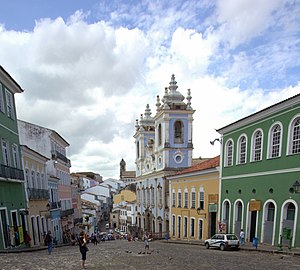
Salvador is an enchanting city full of mysteries and charms. There are millions of tourists every year flocking to Salvador to enjoy its beaches. Parts are best explored on foot, such as dense historical areas including the Pelourinho and the Lacerda Lift, the first urban lift in the world, and the Mercado Central.
History [ edit ]
Founded in 1549 by the Portuguese, Salvador was the capital in the heyday of the slave trade. The legacy remains today in its large Afro-Brazilian population, and the resulting culture in many ways outshines the rest of Brazil; in music, many of the greatest names from the mid-20th century to the present hail from Salvador, such as Dorival Caymmi, Gilberto Gil, and Caetano Veloso. In literature, the late Jorge Amado was also from the region. It's a vibrant, exciting city, and its people are quite friendly.
Orientation [ edit ]
Salvador is on a peninsula on the north-east coast of Brazil which shields the large Baía de Todos os Santos ("All Saints Bay") from the Atlantic Ocean. The city is the third largest in Brazil, sprawling for dozens of kilometres inland from the coast. Most visitors head for the coastal neighbourhoods that cluster around where the bay meets the ocean. Salvador, Brazil has a tropical climate including rainforests and lush vegetation.
A 100-m cliff runs along the entire bayshore, dividing the city into Cidade Alta , up on the cliff, and the Cidade Baixa down by the bay. The former features Pelourinho , the old city center that packs historical sites, colonial architecture, museums, restaurants, bars, hostels, artisanal shops, and music/dance/capoeira academies into a convenient, albeit tourist-swarmed, set of winding cobblestone streets. The latter features a commercial center with lots of bus traffic coming in from all over Salvador.
Outside of this area, there are many beach districts that stretch from the tip of the peninsula northeast along the Atlantic coast. The Barra neighborhood at the tip of the peninsula is the main alternative jumping-off point to Pelourinho, and a little further to the northeast are the hip neighborhoods of Rio Vermelho and Amaralina , which feature a nightlife less geared to the foreign tourism industry. A decent bus ride beyond these is the neighborhood of Itapuã , which has an energetic beach side nightlife and relatively few foreign visitors. Northward from there are kilometres and kilometers of gorgeous beaches, all accessible by bus.
The bayshore coast north beyond Pelourinho features a more tranquil atmosphere and a locally patronized, though less scenic, beach life. The interior of Salvador is where the "new city" has developed, full of residential neighborhoods, shopping megaplexes, and knotted highways, all of which can be quite alienating without actually having a friend to show you around.
Local residents enjoy sharing their exotic dancing and music skills with tourists. Residents are also considered some of the friendliest people on the planet.Tourist are welcomed with open and friendly arms by the majority of local residents.
People [ edit ]
People of Salvador, as other people from the state of Bahia , have a reputation of being relaxed, easygoing, and fun-loving, even by Brazilian standards, and of leading a "slow life". It's questionable whether this reputation is true, as the hectic behavior of pedestrians and drivers in traffic does not seem to be typical of "slow" or "relaxed" people. Regardless, few soteropolitanos (natives of Salvador) seem to bother with this reputation, even the bad part of it, and some even make fun of their own supposed laziness. Also, most people in Brazil agree that soteropolitanos are generally friendly and warm people.
As a former African slave port, Salvador inherits a massive social inequality with notable racial tones, with a wealthy minority being mostly white and often living in gated communities, and the majority of people being relatively poor and mostly black or mixed. The city's highly famous Carnival has been a subject of controversy, with many criticising the lack of participation of locals in the event (as they can rarely afford the expensive tickets), and others remarking the importance of the event to the city's tourism and economy.
Climate [ edit ]
With a tropical climate and year-round sunny weather, temperatures in Salvador do not vary much. In summer, average maximum temperatures reach 30 °C (86 °F) and in winter, temperatures are between 26 °C (79 °F) and 21 °C (70 °F). However, humidity can give a greater thermal sensation than that. If you go swimming, the sea also has a pleasant average temperature of 27 °C (81 °F) all year round. With lots of sun and heat throughout the year, your concern as a tourist will just escape the rainy season, which lasts from April to June in Salvador.
With over 2,400 hours of sunshine a year, it's essential to use sunscreen in this sunny city.
Get in [ edit ]

By plane [ edit ]
Scheduled airlines:
- LATAM (all Brazil, Miami and Buenos Aires ).
- Gol (all Brazil, Buenos Aires and Rosário ).
- Azul Linhas Aéreas ( Vitória da Conquista , Paulo Afonso , Ilhéus , Porto Seguro , Teixeira de Freitas , Lençóis , Recife , Belo Horizonte , Fortaleza , Goiânia ), Feira de Santana , Campinas and Cuiabá ).
- Passaredo ( Vitória da Conquista , Barreiras, Brasília and Ribeirão Preto).
- TAP ( Lisbon ).
- Aerolineas Argentinas ( Buenos Aires and Córdoba )
- Air Europa ( Madrid )
- Cabo Verde Airlines (Ilha do Sal)
- Copa Airlines ( Panamá City )
- Condor ( Frankfurt ).
The airport is 28 km from the city center (via the Paralela expressway) or 32 km (via the seaside). There is a subway station easily reached by a free bus shuttle from the terminal. The subway fare is R$3.70 (including transfer to city buses). The subway is the best option to reach the city, it goes to the city center and also connects the airport directly to the main bus terminal (Estação Rodoviária). To Barra, Campo Grande or Ondina area, take the subway to Lapa Station (Line 1) and then a short bus ride (or a taxi/Uber). To Pelourinho, take the subway to Campo da Pólvora Station and then walk (around 900 meters, it's ok if you're arriving during the day) or take a taxi or Uber. To the ferry-boat terminal (to Itaparica), take the subway to Acesso Norte Station (Line 1 and 2) and then a bus towards São Joaquim. Two kinds of taxis are available in the airport, the executive taxis (Coometas and Comtas), and the normal taxis . Executive taxis are pre-paid, they have a table of prices rather than a meters. The other taxi option would be the normal taxis which are metered. A third option would be the executive air-conditioned minibuses which depart every 20 minutes to the Praça da Sé, in downtown near Pelourinho via the seaside, stopping at famous beaches like Ondina, Pituba, Amaralina and Itapuã, and Barra as well as stopping by Shopping Barra --an American-style shopping mall located not too far from the Farol da Barra The fare for these buses is R$4. Another option is the urban buses that go to many parts of the city, for the tourist the options are Lapa and Campo Grande buses, the best thing is ask the driver before taking an urban bus, the fare is R$3.70. There is also a shuttle service to some hotels around the city and costs R$25.00. The tickets are sold inside the arrivals area or online. To Praia do Forte , take the subway to Mussurunga Station or Rodoviária Station and then a bus, try to check the schedule of theses buses in advance.
By bus [ edit ]
Salvador's long-distance bus station is in the middle of the new city, 14km from downtown. Salvador is accessible via scheduled buses from all around the country and from Paraguay. Inside the bus stations there are taxis (local taxis and executive taxis) and local buses which can all take you to many places in Salvador and the metropolitan area. Executive buses in the Iguatemi Station can be accessed from the Iguatemi Mall by way of a busy walkway. Bus travel in and out of Salvador can take a lot more time than expected. Count on an average speed of 50-60 km/h when planning your itinerary.
By boat [ edit ]
Salvador is a common stop on international cruise routes and was once visited by the Queen Elizabeth 2 during her sailing career. Note that the docks area can be dangerous. This area is linked to the Pelourinho historic centre by the Elevador Lacerda , and to the city by urban buses and executive buses to Iguatemi .
Get around [ edit ]
By foot [ edit ].
There are a number of transportation options available in Salvador, including taxis, buses and car rentals. the bus fares are quite affordable, although the taxi fares can be quite expensive if one is traveling a long distance.

The old city center can be easily explored on foot. To get between the upper and lower sections, take the Elevador Lacerda or the cable car, remember to take small change as the fare is just R$0.15. The streets between the two are considered dangerous even during the day.
City buses, as in other Brazilian cities, are constant and confusing. Fares are normally R$3.70, as of July 2018 (even for buses into the neighboring city of Lauro de Freitas ). There is also the option of the air-conditioned executive buses for R$5. Remember to board in the back for the full-sized buses.
Know your landmarks and neighborhood names. Any large shopping area will have a complimentary frequented bus stop, and the major intercity terminal, Lapa, is next to Shopping Lapa.
Other major bus terminals include: Estação Iguatemi (between the Rodoviaria and Shopping Iguatemi), and Estação Mussurunga (on the Paralela with buses usually connecting to Praia do Flamengo interior neighborhoods in Salvador).
If you are trying to make your way out of Pelourinho, you can either take the Elevador Lacerda down to the Comercio and find buses for just about every route, or walk to the Praca da Sé bus stop just south of the elevator, which has a much smaller selection of buses passing through, and many options of executive buses.
Buses are safe to ride at night, as long as you are on a frequented (i.e. coastal) route and dress and act inconspicuously. Service stops at midnight and begins again around 04:30-05:00. There are a limited number of lines that provide night service from 00:00-04:00
You can find more about the Salvador bus routes and time tables one the website for the Superintendência de Transporte Público [dead link] (in Portuguese only).
By taxi [ edit ]
Salvador cab drivers must be competing with those in Rio for spots on Formula 1 racing teams. They will certainly get you where you're going quicker than the bus! However, as buses stop running after midnight, do be prepared to haggle quite a bit with taxi drivers who refuse to use the meter, especially if you've decided to explore far from your bed. Executive taxis (white and blue) don't have meters, and the prices are on a table, it's more expensive than city taxis, but they are much more comfortable, they are in stops in the main shopping malls, the airport, bus station, ferry-boat station and big hotels.
By car [ edit ]
Renting a basic car with air conditioning (and 100 km/day or km free) costs R$ 110-140 per day, plus fuel. It's not hard to find your way across Salvador avenues, but although people from Bahia have a reputation of being relaxed and easygoing, traffic is aggressive (somewhat like Rio de Janeiro ), and you will frequently see drivers attempting dangerous overtakes on you. Pedestrians are also careless and unexpectedly run to cross roads and streets. If you are not used to this type of traffic, consider asking for a private driver, which is possible on many car renting agencies. Renting a car may be a good idea if you plan to visit the beaches from the northern part of Bahia, with more time flexibility than allowed by travel agencies.
By bicycle [ edit ]
Cycling is not really a good option to get around in Salvador, as there aren't enough cycleways and parking for bicycles, and drivers don't have any respect for cyclists. An exception is the cycleway along the east coast of Salvador, which runs for 12.55 km and goes from Amaralina to Piatã beaches. Be aware that as the cycleway is not very used, a lot of pedestrians use it for walking.
By metro [ edit ]
Salvador has a metro system consisting of two lines connecting the city center to some suburbs, the airport (Estação Aeroporto) and the long-distance bus terminal (Estação Rodoviária). Pelourinho district is 900 m away from Campo da Pólvora Station. Barra area is linked by very frequent city buses from Lapa Station.
The subway fare is R$3.70 including two city bus transfers with the subway card (Cartão Integração - easily bought at any subway station, including the airport) or with the Salvador bus card (Salvador Card).
See [ edit ]
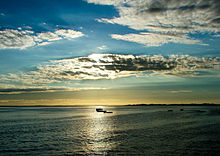
- -12.97474 -38.5092 1 Igreja de São Francisco , Largo do Cruzeiro de São Francisco , ☏ +55 71 3322 6430 . One of the most important churches in barroco style around the world.
- At the center of the Cidade Alta there are the two large squares Praça da Sé and the Terreiro de Jesus which are connected at the corner by the cathedral. The latter is probably the most lively part of town, with food carts and stalls through the day and revealers in the evening hours.
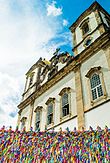
- Abaeté Park — A protected state park around the lake with the same name. The lake is famous because of the stark contrast between the dark water and the very white sand dunes. There is an entertainment area with a lot of bars and live music.
- -12.98232 -38.5203 6 Solar do Unhão . The best place in Salvador to watch the sunset. It is an old style house located at the Baía de Todos os Santos . Inside there is a small museum ( Museu de Arte Moderna ) with local art pieces. Sometimes on Saturday evening there is a jazz concert. ( updated Oct 2020 )
Do [ edit ]
You'll find a huge variety of things to do in Salvador. Some of the popular activities include:
- Day tour of Salvador - Salvador 500 years in 1 day (info: salvador-guide.basix.cc)
- Salvador Parks
- Salvador golf courses
- Salvador music festivals
- Participate at a Candomblé ceremony. Candomblé is an Afro-Brazilian religion that originated in Salvador and still has a significant following in Brazil. Their places of cult are called terreiros and many are open to visit. You can ask at FENACAB (Nacional de Culto Afro Brasileiro). They organise visits with a taxi for 100 Reais and have an office in Rua Portas do Carmo, 39 – 1º andar (antiga Alfredo de Brito) – Pelourinho +55 71 3321 1548. http://bahia.com.br/outros_servicos/federacao-nacional-de-culto-afro-brasileiro/ [dead link] Many travel agencies also organize similar visits for the same price. They are free to enter and tourists are welcome to participate, so if you know a terreiros you can also go by yourself.
A good Brazil tour guide in Salvador, known as a guia de Salvador , will be able to show you around lots of the attractions and activities if you want to explore on your own. A good option to get a general idea and find your way around in the city is the "Salvador Bus", an open-top tour bus passing by the main points of interest and offering explanation on the way.
One of the main attractions in Salvador is the Carnaval. Salvador's giant Carnaval , the biggest of the world, according to the Guinness book of records, lasts for one week and is extremely popular with Brazilians and tourists alike. The event happens in mid-February and consists of parades, live entertainment, music, dancers and vendors. The main parades follow three circuits: one in the historic center Pelourinho (with mainly traditional groups in costumes), one on Campo Grande, where most bands play samba, and the most popular one in Barra/Ondina, where modern Brazilian Axé music mixes with percussion and all kinds of rhythms and styles, and the bands parade between "Camarote" boxes on one side and the beach on the other. Options to participate are either by watching from the camarote boxes, or purchasing an "abadá" shirt to join a group that accompanies one of the bands throughout the parade.
You can expect to have a lot of fun if you vacation in Salvador during Carnaval. Salvador also has many other attractions that tourists will find enjoyable. these include golf courses, museums and even an old 17th-century fort. Anyone wishing to visit Salvador Brazil will find their trip to be entertaining, fun and full of wonderful memories.
Go to the beach [ edit ]
Visiting a Salvador beach is a highlight for many tourists. One of the main central Salvador beaches is Porto de Barra. It was originally the site of the first settlement of European newcomers to Bahia. It can get very crowded on weekends. The north-East region of Salvador concentrates most beaches with good water quality. Flamengo and Stella Maris are the most popular beaches among tourists and upper class locals. They have excellent tourist infrastructure and rough waters excellent for surfing. Jaguaribe, Piatã and Itapoã, with calmer waters, are mostly frequented by locals and can become quite crowded at weekends. They are a good option with you want to mix with the local population, but don't bring anything besides your clothes, sunglasses, sunscreen, and some cash, as muggings are quite common.
The other beaches of Salvador aren't suited for bathing, but still can be good for walking, cycling, or taking pictures. Farol da Barra has a beautiful view (specially during the sunset), but it's difficult to walk due to the rocks. "Farol" means lighthouse, and this beach is known for its lighthouse as well as being popular with surfers. A much safer choice is nearby Plakaford. Here the calm waters and soft sandy beaches are welcoming for families and children. In the city south, there is an array of beautiful beaches that include Tinhare and Boipeba.
For a nice day trip, catch the ferry to the laid-back island of Itaparica .
Buy [ edit ]
Salvador shopping is the bargain hunters paradise. There is nothing that you cannot find in a mall. If you plan to buy popular art, crafts and clothing, check the small stores at the Old Town or head to the Mercado Modelo (Model Market). Locals like to shop at American-style shopping malls:
- Shopping Center Iguatemi
- Salvador Shopping
- Shopping Barra
- Shopping Itaigara
- Shopping Center Lapa
- Shopping Piedade
- Bahia Outlet Center
- Salvador Norte Shopping
- Aeroclube Shopping & Office
The first thing that anyone wanting to shop in Salvador should know is that it is essential to haggle. very few vendors will stick to their given price. If pushed they will always go lower. If you are looking for souvenirs you may want to check out Litoral Norte located at Rua Gregorio de Matos 30. They sell t-shirts and other items. Most will cost you no more than $5.
If you want local art you should visit Pelourhino. There are many galleries that double as stores. Galeria 13 at Rua Santa Isabel 13 displays work by local artists.
Eat [ edit ]
Bahian restaurants are considered to be among the best in Brazil. The majority of Bahia restaurants offer South American cuisine but there a few that offer other specialties. For example, the Maria Mato Mouro located at Rua 3A Ordem de São Francisco, Pelourinho serves a wide range of seafood dishes from all over the world although most are from South America. One of the most popular dishes is the grilled bahia fish badejo. This restaurant is open daily from noon until 1AM and offers main courses from $15 to $25. The Terreiro de Jesus is a great place to sample the local cuisine from street stalls, served by Afro-Brazilian baianas in their traditional white dresses. A must try dish is the Abara. This is a wrap with bean paste, dende oil and onions all cooked in a banana leaf with spices for flavour. if you prefer western food then you will find many fast-food places like Burger King, McDonald's, Subway or Pizza Hut. You also will find casual dinner chains like Outback Steakhouse.
Be sure to try acarajé , small fritters made from black-eyed peas and onions fried in palm oil slathered with spicy vatapá (shrimp paste).These are sold by Baianas on the street.
Budget [ edit ]
- Acarajé da Cira , Largo de Itapuã, 3249-4170. Fresh acarajé daily from 10AM-11PM. There is also another location on the Largo da Mariquita in Rio Vermelho.
- Acarajé da Dica , Rua J, Castro Rabelo, Pelourinho. Open Tu-Sa 3PM-11PM, Su 10AM-1AM.
- Health Valley Brasil , Rua Direita da Piedade ( in the city center ). Vegetarian restaurant run by an African couple. Serving typical dishes based around ginger. Very popular with the local alternative crowd. Buffet including fruit juice and desert costs R$12.
- Quiosque de Amaralina , Ave Otávio Mangabeira, Amaralina. Serving acarajé near the beach from 4PM to midnight.
Mid-range [ edit ]
- Bistrô PortoSol ( On a cross-street near Porto da Barra ). Small, cozy Austrian-Hungarian restaurant run by an Austrian and his wife. Simple accommodations decorated with posters of classic Hollywood movies. Quite delicious.
- Companhia da Pizza , Rio Vermelho ( On a cross-street near the Pestana Bahia and Blue Tree Towers Hotels ). One of the city's most popular pizza restaurants.
- La Figa , Rua das Laranjeiras 17, Pelourinho ( Near Terreiro de Jesus ). Italian restaurant with fresh pasta around R$35 for two people, appetizers around R$10, and desserts. High quality, good service and good atmosphere.
- Maria Mata Mouro , Pelourinho ( Near São Francisco Church ). Small, with only 12 tables but the service is great. Try the shrimp.
- Meridiano , Ave Tancredo Neves ( In front of the Casa do Comércio building ). Gourmet cuisine at moderate prices. Excellent service.
- São Salvador ( On the grounds of the Salvador Trade Center ). Buffet with a refined atmosphere.
- Panela da Bahia , Pelourinho, Rua Frei Vicente, 7 . Bahian food and drinks with exotic flavours at very reasonable prices. Try the Moqueca de camarao com banana. It is exquisite. Around R$30-55 for two people including drinks.
- Hostel Galeria 13 , Pelourinho, Rua da ordem terceira no 23 . The new European owner offers Pelourinho a much needed variety of international dishes & Spanish tapas . The menu includes a great selection of vegetarian meals from around the world. You can enjoy your meal in the unique Moroccan chill out room or in their patio garden. They also offer those great juices with a touch of ginger, or maybe a caipirinha with watermelon.The quantities are very generous and the prices are fair.
- Bahia Beach house Rentals , Atelier do Sobrado Rua Guedes Cabral, 184 Rio Vermelho Salvador -Ba 41950-620 , ☏ +55 71 9619-2635 , [email protected] . Beach houses for rent, mainly on the northern seaboard of Salvador.
- Pousada Rancho Fundo , Salvador / Abrantes, Lot. Las Palmas, Camacari -Ba 42480-000 ( between Salvador and Praia de Forte ), ☏ +55 71 3623-2606 , [email protected] . 24 hr . Nice big Sitio (Farm like) close to fab. beaches.
Splurge [ edit ]
- Amado , Ave Contorno. Contemporary cuisine.
- Barbacoa , Ave Tancredo Neves. Fine meat dishes and some of Salvador's best feijoada in a refined atmosphere.
- Boi Preto , Boca do Rio ( in front of Aeroclube Plaza Show near the Convention Center ). One of the best churrascarias in town. Full buffet and salad bar plus unlimited fine cuts of meat.
- Casa do Comércio , Ave Tancredo Neves, 11 ( in the heart of the financial district ). F. A good place to eat well and take in a panoramic view of Salvador.
- Marc Le Dantec , Pier Sul Apartment Service, Ondina. The best French restaurant in the city.
- Mistura , Itapoã. Specializing in fish and international cuisine.
- Trapiche Adelaide , Comércia. Voted among the best fine dining in the city, with a fine view of the Bay of All-Saints.
- Yemanjá , Ave Otávio Mangabeira 9292, Pitubá, 231-5570. Long held nationally and internationally as the standard in typical Bahian cuisine.
No trip to a Salvador restaurant is complete without dessert. The Bahia region is famed for its sweet tooth. A Cubana at Rua Alfredo de Brito 12 is open daily from 8AM until 10PM. It is an old fashioned ice cream parlor or sorvetoria with 28 homemade flavors.
Drink [ edit ]
Be aware of bars charging an entrance fee on exit.If you want top make sure that there is no cover ask when ordering the first drink.
Bars [ edit ]
- Bar da Ponta , beside the Trapiche Adelaide. A place to see and be seen, drink, and have a fantastic view of the bay.
- Beco dos Artistas , near Campo Grande. One of the gay and lesbian areas of the city, with a diversified crowd. Friday and Saturday nights only. The area has various bars and a restaurant (the nightclub is now closed). Aim to get there around 10PM, as it starts to empty around midnight as people move onto other clubs.
- Bohemia Music Bar , Jardim Brasil. The comfortable atmosphere, live music, and a varied menu make this a popular pick-up spot. The places often checks for IDs at the entrance.
- Chuleta , Vale do Canela ( near the UFB campus and the neighborhoods of Graça and Vitória ). Boteco frequented by university students, famous for its cheap beer and for the meat snack from which the bar takes its name. Open air, plastic tables.
- Largo de Santana , Rio Vermelho. This busy street has various bars and restaurants, and some of the best acarajé in town.
- Mercado do Peixe , Rio Vermelho ( at the seaside in front of the Blue Tree Towers Hotel ). One of the best after-hours spots, Mercado do Peixe is a real Salvador institution. It starts to get busy after 3AM when everywhere else is closing. With simple accommodations and plastic tables, various stands stay open offering moquecas and regional appetizers, in addition to drinks. During the day it is, as its name suggests, a traditional seafood market.
- Casarão do Lord , Rua Frei Vicente, No 7, Pelourinho , ☏ +55 71 3321-2448 . In the middle of the Pelourinho. Live bands (salsa, samba, reggae, zouk, semba) and DJs spinning African, Brazilian and world music. Tasty African dishes and drinks are also offered. African flags, maps, and artworks adorn the walls. The top floor has a projection system showing films and documentaries.
- Hostel Galeria 13 , Pelourinho, Rua da ordem terceira no 23. The new native English speaking owner has travelled and worked in many famous bars and clubs around the world you will get a chance to check out his knowledge of drinks. They offer great juices with a touch of ginger 'refreshing', or maybe a caipirinha or roska with water melon already being boasted the best in Brasil, a big Claim take him up on it. You can enjoy your drinks in the garden or the most original spot in Pelourinho, the Moroccan "chill out" room.
- Bar Zulu , Pelourinho, Rua das laranjeiras no 15 , ☏ +55 71 8784-3172 . A very international bar & vegetarian restaurant.A mix of staff from all over the world bring you a cool corner bar with terrace and individual bar tables in every window, great for people watching. The bar offers the most original menu in the "Pelo", Spanish tapas, salads, sandwiches, international dishes and a vast choice of great veggie dishes from around the world. The bar has a feel of a trendy Spanish tapas bar with some of the friendliest girls serving with a smile. Try their house special Caipirinha "zumarangi" strawberry & passion fruit. The owner promises they will soon be providing a sports tv, so it could become a great spot for catching a European footie.
Nightclubs [ edit ]
- Dolce , on the first floor of Shopping Boulevard 161, Itaigara. Very busy club, attracting a somewhat older crowd.
- Fashion Club , Ave Octávio Mangabeira, 2 , ☏ +55 71 3346-0012 . 471, Pituba. Once the most vibrant nightclub in Salvador, Fashion Club has taken somewhat of a backseat since the opening of Lotus. Prices, however, are around half of what you would pay at Lotus.
- Off Clube , Rua Dias Dávila, 33, Barra , ☏ +55 71 3267-6215 . The main gay and lesbian club in town. A variety of events attracts locals of all social classes.
- Rock in Rio Café — Often mentioned in tourist guides but now closed.
- Zauber Multicultura , Ladeira da Misericórdia, 11, Edifício Taveira, Comércio, 71 3326 2964. Combining music and visual arts in one of the most important historic areas of the city. The space bridges between the old (architecture) and the new (decoration). Find out what is going on before you go, and take a taxi, as the location is in a rather dangerous and prostitution-plagued area of the city.
Sleep [ edit ]
There are luxury hotels on the beach. Salvador also has discount hotels that offer cheap rates for those on a budget. There are also hostels in Pelourinho that are reasonably priced, but noisy at night.
- Albergue da Lucia , Rua Portas do Carmo 9, Pelourinho , ☏ +55 71 3266-2384 . Check-in: 14:00 , check-out: 12:00 .
- A Meson Pousada [dead link] , Rua Portas do Carmo 11, Pelourinho 51 71 3322-8039 offers affordable lodging in the middle of all the action, day and night, for Salvador's Historic District.
- Hostel Pais Tropical , Largo do Pelourinho 7, Pelourinho 51 71 3322-1859 Situated in the heart of Salvador. Offers economical prices, good breakfast and support for speaking in English, Portuguese, Spanish, and Polish.
- Open House , Rua Comendador Bernado Catarino, 137, Barra , ☏ +55 11 3711-2186 . Run by an artist couple, Cuban writer and film director husband Alex and Brazilian painter, dancer and choreographer wife Jacqui. A few blocks from Barra beach and trendy restaurants and bars, the house is full of paintings and artistic touch and incredible hospitality. Dorm and private rooms available.
- Ibis Salvador Rio Vermelho , Rua Fonte do Boi, 215, Rio Vermelho , ☏ +55 71 3172-4100 .
- Hotel Ondimar , Ave Oceânica, 1843, Ondina , ☏ +55 71 3339-8383 .
- Sol Plaza Sleep , Ave Otávio Mangabeira, 4581 , ☏ +55 71 3418-3699 . Praia de Armação.
- São Jorge . In Pelourinho. Free internet and breakfast included.
- Praia da Sereia , Ave Dorival Caymmi, 14 ( near the airport ), ☏ +55 71 3285-8100 . Itapoã.
- Che Lagarto , Avenida Oceânica, 84, Barra , ☏ +55 71 3235-2404 , [email protected] . Prices from US$12 the night, breakfast included, public kitchen, bar inside the hostel.
There are 3 hostels affiliated with Hostelling International, two situated in Barra and one in Pelourinho. All are quality youth hostels.
- Hostel Barra , Rua Artur Neiva, 04, Barra ( near Morro do Cristo ), ☏ +55 71 3245-2600 .
- Laranjeiras Hostel , ☏ +55 71 3321-1366 . Rua da Ordem Terceira 13, Pelourinho.
- Hostel Galeria13 . Rua da ordem terceira 23, Pelourinho, 71-32665609.(It is not affiliated with HI)
- Casa de Mainha Friendly Hostel , R. Arthur d'Almeida Couto - Vila Laura , ☏ +55 71 99247-6947 . Cheap place in Villa Laura, the owner is extraordinarily friendly, high value for the low price. The owner will send you recommandations for visits and evening activities. Late night check-ins possible for a small fee.
- Pousada Poesia Hotel , Rua da Poesia 118, Farol de Itapuá , ☏ +55 71 3249-1435 . Check-in: 2PM , check-out: noon . CEP: 41640-485
- Bahia Othon Palace Hotel , Av. Oceânica, 2294 , ☏ +55 71 2103-7100 , [email protected] . The hotel faces Ondian Beach and provides guest with a magnificicant view of the Atlanitc Ocean. The hotel offers a nightclub, beauty spa and other activities. Rates start at US$103 per night.
- Bahia Beach house Rentals , Atelier do Sobrado Rua Guedes Cabral, 184 Rio Vermelho Salvador -Ba 41950-620 , ☏ +55 71 9619-2635 , [email protected] . Beach houses for rent on the Bahia coast, from the Whalecoast to the Coconut coast.
- A Casa das Portas Velhas , Largo da Palma, 06, Nazaré , ☏ +55 71 3324-8400 , [email protected] . Right on Salvador City Center, this accommodation has a Colonial English style.
- Vila Galé Salvador , Ave Rua Morro Escravo Miguel, 320 Ondina CEP 41 700.000 Salvador Bahia - Brasil , ☏ +55 351 217 9076190 , [email protected] . On Praia de Ondina in São Salvador da Bahia, 20 minute away from the International Airport. Online booking.
- -12.81883 -38.26008 1 Pousada Rancho Fundo , Salvador / Abrantes, Lot. Las Palmas, Camacari -Ba 42480-000 ( between Salvador and Praia de Forte ), ☏ +55 71 3623-2606 , [email protected] . 24hr . Check-in: 2PM , check-out: noon . Hotel Pousada at the Estrada do Coco close to the beaches of the Coconut Coast.
- Mercure Salvador Rio Vermelho , Rua Fonte do Boi, 215, Rio Vermelho , ☏ +55 71 3172-9200 , +55 71 3172-9286 , fax : +55 71 3172-9286 .
- Iguatemi Business Flat , Rua das Alfazemas, 761, Caminho das Árvores , ☏ +55 71 2101-1300 .
- Golden Park Hotel , Av. Manoel Dias da Silva, 979, Pituba , ☏ +55 71 2201-5622 .
- Marazul Hotel , Av. Sete de Setembro, 3937, Barra , ☏ +55 71 3264-8200 .
- Atlantic Towers , Av. Oceânica, 1545, Ondina , ☏ +55 71 2203-3000 .
- Hotel Cocoon , Rua Heackel José de Almeida, 238, Jaguaribe , ☏ +55 71 3368-8100 .
- Pousada Des Arts , Rua Direita do Santo Antonio, 90, Historic Centre , ☏ +55 71 3012-5964 .
- Pousada Santo Antonio , Rua Direita do Santo Antonio, 130, Historic Centre , ☏ +55 71 3326-1270 .
- Portobello Ondina , Ave Oceânica, 2.275, Ondina , ☏ +55 71 2203-6000 .
- Sol Vitória Marina , Ave Sete de Setembro, 2068 , ☏ +55 71 3418-2000 . Vitória.
- Holiday Inn , Rua Dr Augusto Lopes Pontes, 1207, Costa Azul , ☏ +55 71 4009-4488 .
- Ondina Apart , Ave Oceânica, 2400 , ☏ +55 71 3203-8000 . Praia de Ondina,
- Pisa Plaza , ☏ +55 71 2103-6555 . Ave Prof. Manoel Ribeiro, Jardim Armação.
- Aram Yami , Rua Direita de Santo António, 132, Centro Histórico, 40301- 280 Salvador da Bahia Brazil , ☏ +55 71 3242-9412 .
- Zank Hotel Boutique , Rua Almirante Barroso, 161, Rio Vermelho , ☏ +55 71 3083-4000 , [email protected] . The Zank Boutique Hotel has a variety of environments.
- Hotel Casa do Amarelindo , Rua das Portas do Carmo, 06, Pelourinho , ☏ +55 71 3266-8550 , [email protected] . This top-range hotel is located on Pelourinho.
- Vila Galé Salvador , Ondina , ☏ +55 800 2848818 , [email protected] . 5-star hotel located right on the seaside, close to tourist attractions.
- Pestana Bahia Lodge , Rua Fonte do Boi, 216, Rio Vermelho , ☏ +55 71 2103-8000 . The Pestana Bahia Lodge is an urban resort and the first time-sharing hotel in Salvador.
- Villa Bahia , Pelourinho , ☏ +55 71 3322-4271 . Villa Bahia Hotel is a luxury hotel with an African-Portuguese colonial flair. The building was totally renovated to turn into a cosy and charming hotel with a 17th - 18th century style.
- Fiesta Bahia Hotel , Avenida Antonio Carlos Magalhes 711, 55 , ☏ +55 71 3352-0000 . The hotel provides a convention center for businesses and a floor just for ladies. A gym, game room, wet and dry sauna, spa and outdoor pool are just a few of the services provided for guests. Rates start at $210 per night for luxury rooms and $468 per night for suites.
Cope [ edit ]
You can extend your visa or visa-free stay in Brazil with the Policia Federal inside the airport on the second floor. Just follow the signs.
Consulates [ edit ]
Stay safe [ edit ].
Due to high social inequality, Salvador is notorious for street crime, and for a tourist that wanders carelessly in the streets, the likelihood of a mugging or armed robbery is considerably higher than in São Paulo and perhaps even Rio de Janeiro. Salvador recognizes the importance of tourism to the city economy, so most important tourist sites such as Pelourinho and Mercado Modelo, as well as main popular festivals like the Carnaval, are usually heavily guarded.
In 2018, Salvador had 47.23 homicides per 100,000 residents, the 9th highest in the country, and the 29th highest in the world.
People with darker complexions will have an advantage over those with pale skin. Blacks are likely to blend in well; other dark-skinned people may be inconspicuous in many places, but others are immediately labelled as either upper class citizens or tourists, and may be specially targeted.
If you are moving on foot, by bicycle, or by bus, it's best to go out during the day. Avoid bringing anything valuable, just enough to enjoy your day. The Flamengo and Stella Maris beaches are among the safest places to go during the day, and they are the best options if you just want to enjoy a good beach without much local culture. In other places, try to stay at areas guarded by police.
As a general rule, be suspicious if people approach you directly in a friendly way as they either want money or to sell you something. It's wise to reject an approach immediately and if necessary then think about it.
At night, it's better to take a cab to go out. Stay at reasonably crowded places. If you don't see other tourists where you are, then it's probably not a place you should be unless you are feeling particularly adventurous.
- Some areas which are strongly frequented by foreigners can become dangerous, especially at night, i.e. the Barra harbour area. Never go to the beach at night!
- The long sloping road leading from the old town to the harbor should be avoided even during the day. Always take the elevator.
- If you are staying in the touristic Barra area, beware of the favela near Shopping Barra, especially at night. The area just to the east toward the beach can be dangerous as well.
- Beware of vehicular traffic. Crossing the streets is always dangerous even when using a pedestrian crosswalk with the traffic light red for cars. As one member of Supergrass band once said: "In Brazil green means go, and red means go faster!" Start the crossing only when vehicles have already stopped.
- Never agree to share a taxi with other random people, especially if they approach you. Most likely, it's just a trap to rob you!
- Watch out for children in Pelourinho, especially on Tuesdays at the Geronimo Concert at the old church - they are reaching out for any low pockets in cargo pants!
- Be careful when walking near the Iguatemi: it is dangerous to wander there. Don't go there past 11PM, unless you are in a car or a taxicab, you will be robbed.
- If you rented a car and stopped in a parking spot, do not stay in the car for too long. You will be a vulnerable target.
When shopping always check the price first, especially if you are white and have blue or green eyes, many locals will see you complexion and feel they have the right to charge you double for services and products. Always ask for a Coupon Fiscal it ensures that the company or individual you are purchasing from pays the proper tax, and it can usually result in them "suddenly" giving you a 10 - 15% discount if you don't want the coupon as they have to pay 27% tax what you buy and the coupon ensures this.
Be particularly aware of bancas and kiosks on the street as they will undoubtedly charge you more for being an estrangeiro (foreigner).
All the little extra money you are charged can seriously eat into your budget and leave a sour taste in your mouth as nobody likes being ripped off.
Stay healthy [ edit ]
As elsewhere in Brazil, some beaches in Salvador are not suitable for bathing, and conditions can change frequently. On the day of your visit, check the latest weekly bathing bulletin [dead link] (in Portuguese, boletim de balneabilidade ) of the state's Environment Department (INEMA).
Go next [ edit ]
Salvador is the gateway to many other nearby attractions such as:
- Praia do Forte . Beach town with the "Project Tamar" turtle sanctuary.
- Imbassai . Just a few kilometers further north from Praia do Forte, this relaxed village's beach lies between the sea and a river that runs parallel to the ocean for a few hundred meters. Unique panorama.
- Boipeba . A beautiful and very pleasant island.
- Morro de São Paulo . Very frequented island by tourists and locals, plenty of restaurants, hostels and bars. It has four beaches with translucent water.
- Massarandupió . 90 km from Salvador, it's a true paradise, a semi-desert beach, with a small river. Walking by the beach you can reach a naturist area.
- Aracaju and further north to Maceió and Recife
- Chapada Diamantina National Park
- UNESCO World Heritage Sites
- UNESCO tag to be fixed
- Has custom banner
- Verbose Climate graphs
- Has mapframe
- Has map markers
- Airport listing
- Articles with dead external links
- Eat listing with no coordinates
- Sleep listing with no coordinates
- Drink listing with no coordinates
- Grande Salvador
- All destination articles
- Usable cities
- Usable articles
- City articles
- Has Geo parameter
- Pages with maps
Navigation menu
Must-see attractions in Salvador

Igreja NS do Bonfim
This famous 18th-century church, located a few kilometers north of Comércio on the Itapagipe Peninsula, is the source of the fitas (colored ribbons) you…
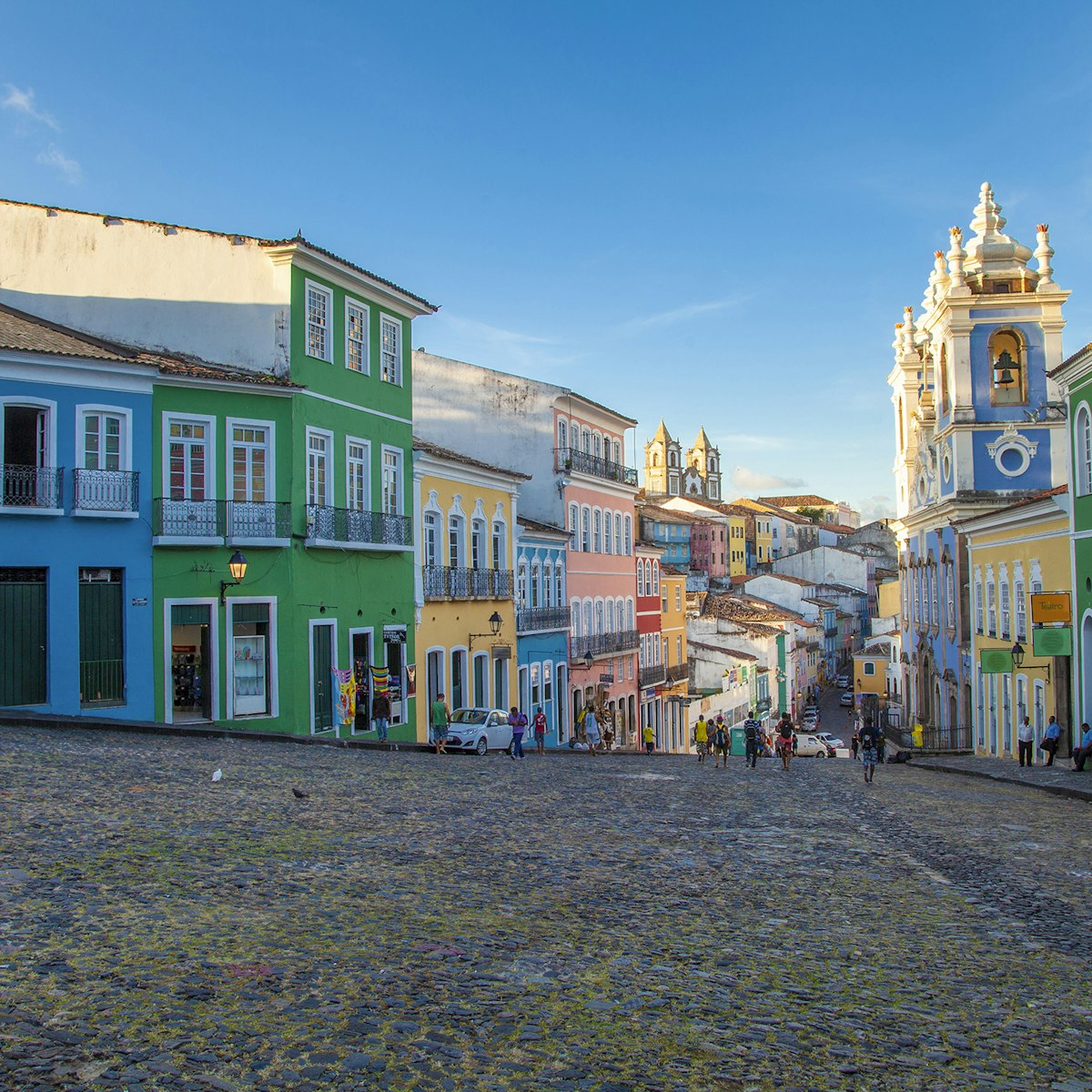
The centerpiece of the Cidade Alta is the Pelourinho, a Unesco-declared World Heritage site of colorful colonial buildings and magnificent churches. As…
Museu Náutico da Bahia
This excellent nautical museum in Forte de Santo Antônio da Barra contains relics and displays from the days of Portuguese seafaring, plus exhibits on the…
Largo do Pelourinho
Picture-perfect Largo do Pelourinho is a sloping, triangle-shaped square, once the site of the pelourinho (whipping post) – one of several nearby…
Museu Afro-Brasileiro
Holding one of Bahia’s most important collections, the Museu Afro-Brasileiro exhibits wood carvings, baskets, pottery and other artwork and crafts linking…
Forte de Santo Antônio da Barra
Built in 1698, Bahia’s oldest fort is more commonly called the Farol da Barra for the lighthouse (South America’s oldest) within its walls. In addition to…
Mercado Modelo
The original 1861 Customs House, where slaves were housed when they arrived in Salvador, was partly destroyed in a fire in 1986. After reconstruction, it…
Fundação Casa de Jorge Amado
Literary types shouldn't miss a quick visit to the Fundação Casa de Jorge Amado, offering an overview of the life of one of Brazil’s best-known writers. A…
Casa do Carnaval da Bahia
The story of Salvador's world-famous Carnaval is told through wonderfully evocative archival video and photographs at this museum which opened in 2018…
Museu de Arqueologia e Etnologia
Below the Museu Afro-Brasileiro (one admission ticket gets you into both), the Museu de Arqueologia e Etnologia exhibits indigenous Brazilian pottery,…
Igreja da Ordem Terceira do Carmo
The original church, founded in 1636, burnt to the ground; the present neoclassical structure dates from 1828. The nave has a French organ and a baroque…
Museu Carlos Costa Pinto
This lovely two-story mansion houses some of Salvador’s finest decorative art, from the collection of the patrician couple Carlos de Aguiar Costa Pinto…
Igreja e Convento São Francisco
One of Brazil’s most magnificent churches, the baroque Igreja e Convento São Francisco is filled with displays of wealth and splendor. An 80kg silver…
Escola Olodum
Stop into the headquarters of Olodum for information on percussion workshops and tours (only for small groups, not individual travelers), which include a…
Igreja NS do Rosário dos Pretos
The king of Portugal gave the Irmanidade dos Homens Pretos (Brotherhood of Black Men) the land for the periwinkle-blue Igreja NS do Rosário dos Pretos in…
Forte São Diogo
It's worth the uphill hike to this 17th-century fort: from here, the views of the bay are fantastic.
Elevador Lacerda
The beautifully restored, art deco Elevador Lacerda connects the Cidade Alta with Comércio via four elevators traveling 72m in 30 seconds. The Jesuits…
Solar do Unhão
This well-preserved, 18th-century complex served as a transfer point for sugar shipments: legend says it's haunted by the ghosts of murdered slaves. Today…
Museu de Arte Moderna
Museu de Arte Moderna has a changing display of avant-garde exhibits (and erratic opening times). The hillside sculpture garden is a pleasant place to…
Praça da Sé
The history of Praça da Sé reveals intriguing details about Salvador's development. From 1552 to 1933, the square was the site of the grand Sé Primacial…
Terreiro de Jesus
A colorful intersection of vendors, tourists, capoeiristas and colorful locals, the Terreiro de Jesus is a historic site of religious celebrations, and is…
Escadas do Carmo
Leading away from the Pelourinho, the steep Ladeira do Carmo provides access to the Escadas do Carmo, a wide set of steps that were the setting of O…
Museu de Arte da Bahia
Museu de Arte da Bahia showcases works from Bahian artists, with paintings by José Teófilo de Jesus (1758–1817) and drawings by Argentine artist Carybé…
Catedral Basílica
The Catedral Basílica dates from 1672 and is a marvelous example of Jesuit architecture. The interior is elegant and simple, with marble-covered walls and…
Plano Inclinado Gonçalves
After sitting, unused, for almost three years, the 1874 funicular railway Plano Inclinado Gonçalves reopened in 2014. The restored line connects Comércio…
Faculdade de Medicina Building
A Portuguese prince, upon arrival in Salvador in 1808, founded a school of surgery here that was later named the Bahia School of Medicine.
Forte Santa Maria
A 17th-century stone fortification that's administered by the Navy.
More destinations you need to see
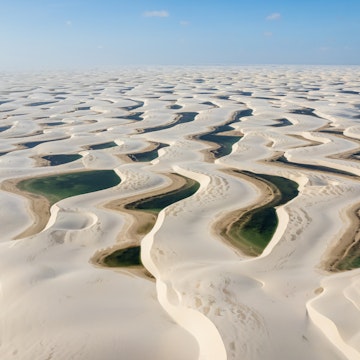
- Bangkok Food Tour
- City Guides
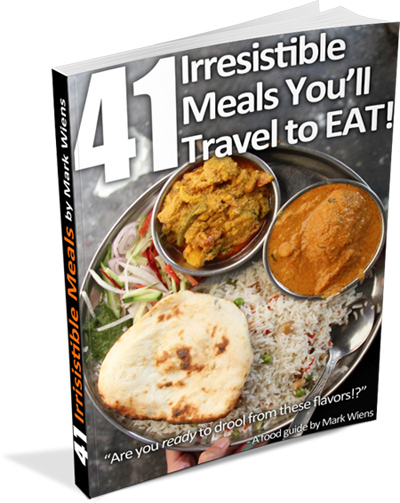
These meals will make you want to travel, just to eat!
Prepare yourself to drool over these 41 meals, each featuring mouthwatering photos, details, and where you can eat it.
I've also included some of my personal travel eating tips and answered some of your top questions... like "Mark, how do you make money to travel?".
You must love food as much as I do!
Just enter your name and email below and I promise to only send you delicious emails :)
Salvador, Brazil – Your 24-Hour Itinerary to Exploring Salvador
Salvador is a city in the Brazilian state of Bahia, and a place in Brazil that you absolutely need to visit.
On Brazil’s Atlantic coast, Salvador is home to a unique Afro-Brazilian culture that literally exists here, and nowhere else in the world.
In this article, I want to give you some ideas about a few of the things you could do here, and share (a lot) of the wonderful things that you need to eat in Salvador.
Full Salvador video guide
(Watch the full street food tour of Salvador in the video above, or watch it on YouTube here )
You Should Visit Bahia
In this article, I will share all the details you need to create a massive and delicious One-Day Itinerary in Salvador.
You will find restaurant information, map locations, details, and photos, everything you’ll need to explore Salvador.
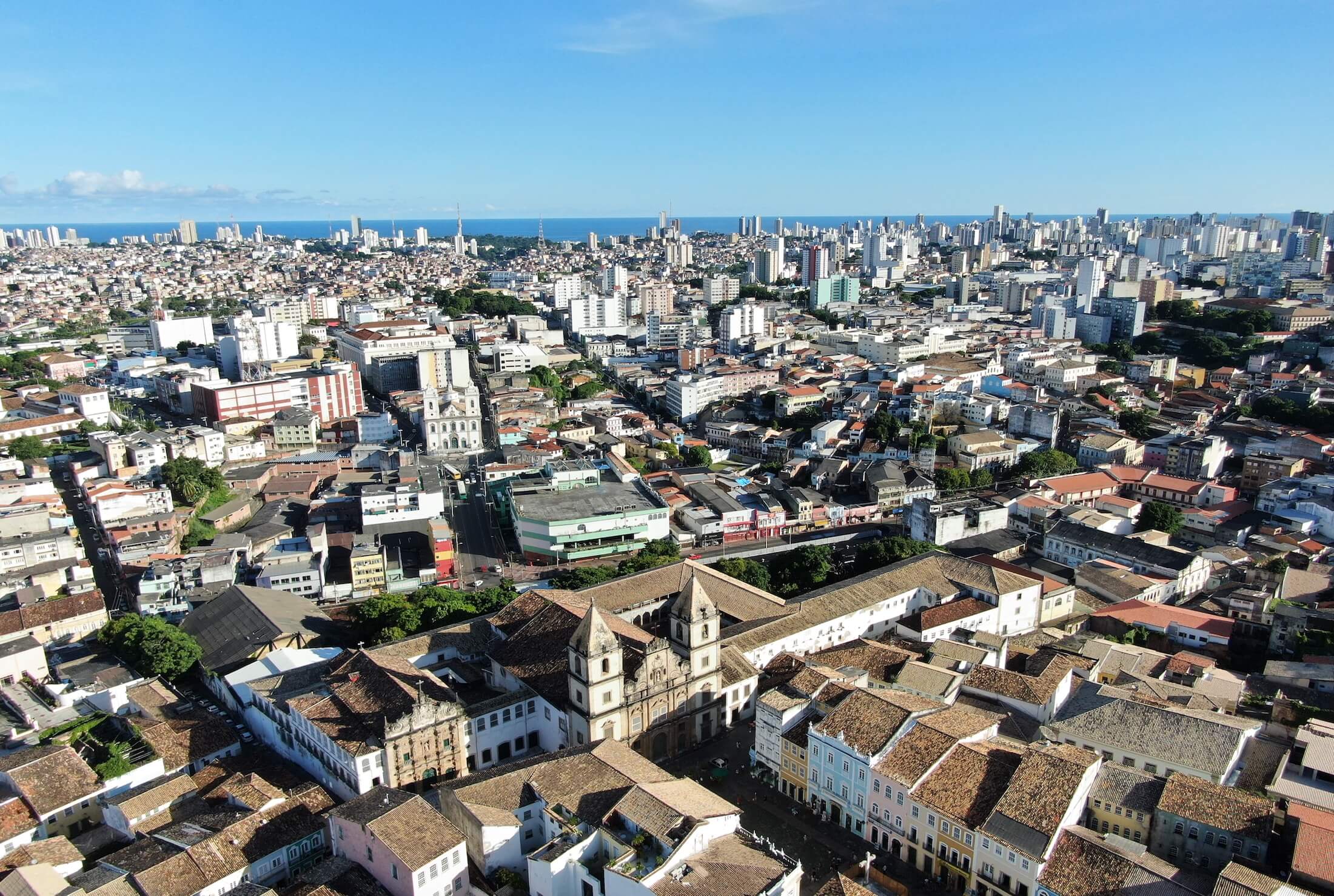
An Overview of This Article
There’s so much to do in Salvador, this might even be a two-day exploration for some.
Therefore, you might also try learning about Salvador in the order I’ve listed below (the two groups of places include things that are physically near to each other).
Start your day with a visit the Sao Joaquim Market (many local fruits and snacks to eat there) and then stop at a beautiful, quiet beach to visit a gorgeous example of the city’s history (some say the Solar do Unhão is the most beautiful spot in all of Salvador).
Be sure to check out the 5 Best Foods of Salvador (final section of this article) and order a few of them for breakfast today, and a few others for your lunch.
Continue just 1 km north along the bay to visit the Mercado Modelo, a good place for buying souvenirs, and some delicious local food. Next, take the famous Lacerda elevator to the Upper City, walk towards Pelourinho (classic architecture and cobbled streets), and practice Capoeira with some professional performers on the way (North-East Brazil’s unique martial art).
Circle around the historic morning streets of Salvador town to enjoy the morning air (visit Pelourinho), and have a coffee while you enjoy some truly lovely views of Portuguese-style architecture, looking out over the bay’s beautiful blue water.
Take a short walk from the Lacerda elevator over to see a street-performance of Olodum (the amazing local drum culture), all the while stopping off for snacks along the way.
Finally, learn which restaurants to visit, and what to order when you’re there, using our list of the 5 Best Foods in Salvador.
We absolutely loved our time with the people of Salvador, this town has a great atmosphere, absolutely incredible local food, and I’m sure you’ll love it too.
Note: While we did this self-guided tour of Salvador in one amazing and ultimate day, it would be just as enjoyable to break this into two days (which would actually give you more time to eat at all those restaurants you want to visit as well).
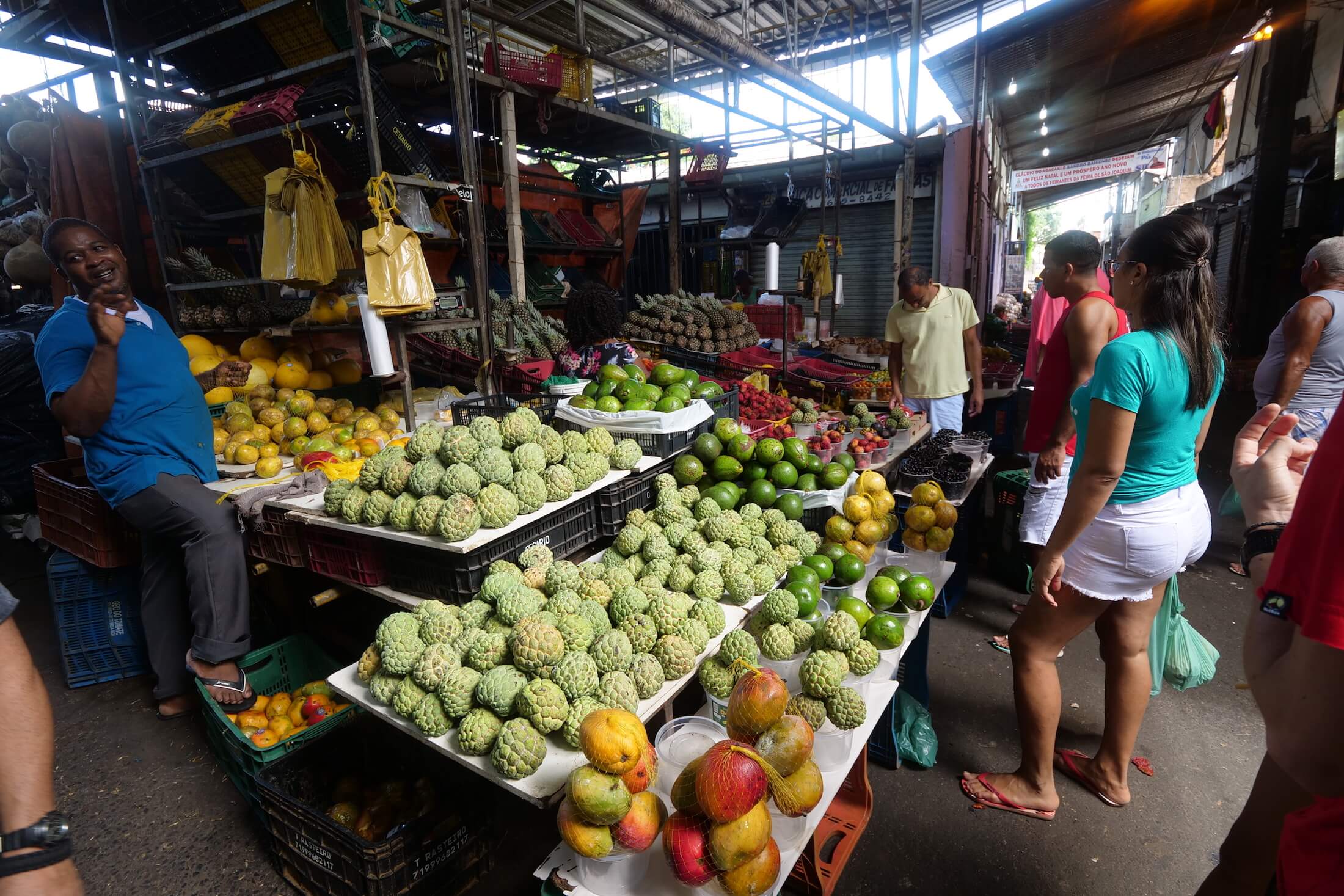
Your Day Begins in Salvador
You’re waking up to a full day of exploring Salvador, and in this case, I’m slightly jealous of you already.
730AM – There’s no single part of a city that will give you such a multi-sensory, educational (and delicious) introduction to a new place, wherever you are in the world.
I always enjoy starting any city tour with a visit to a fresh market. In my experience, visiting a local fresh market is definitely one of the best ways to quickly get to know a place.
In Salvador, São Jaoquim is a wonderful place to start.
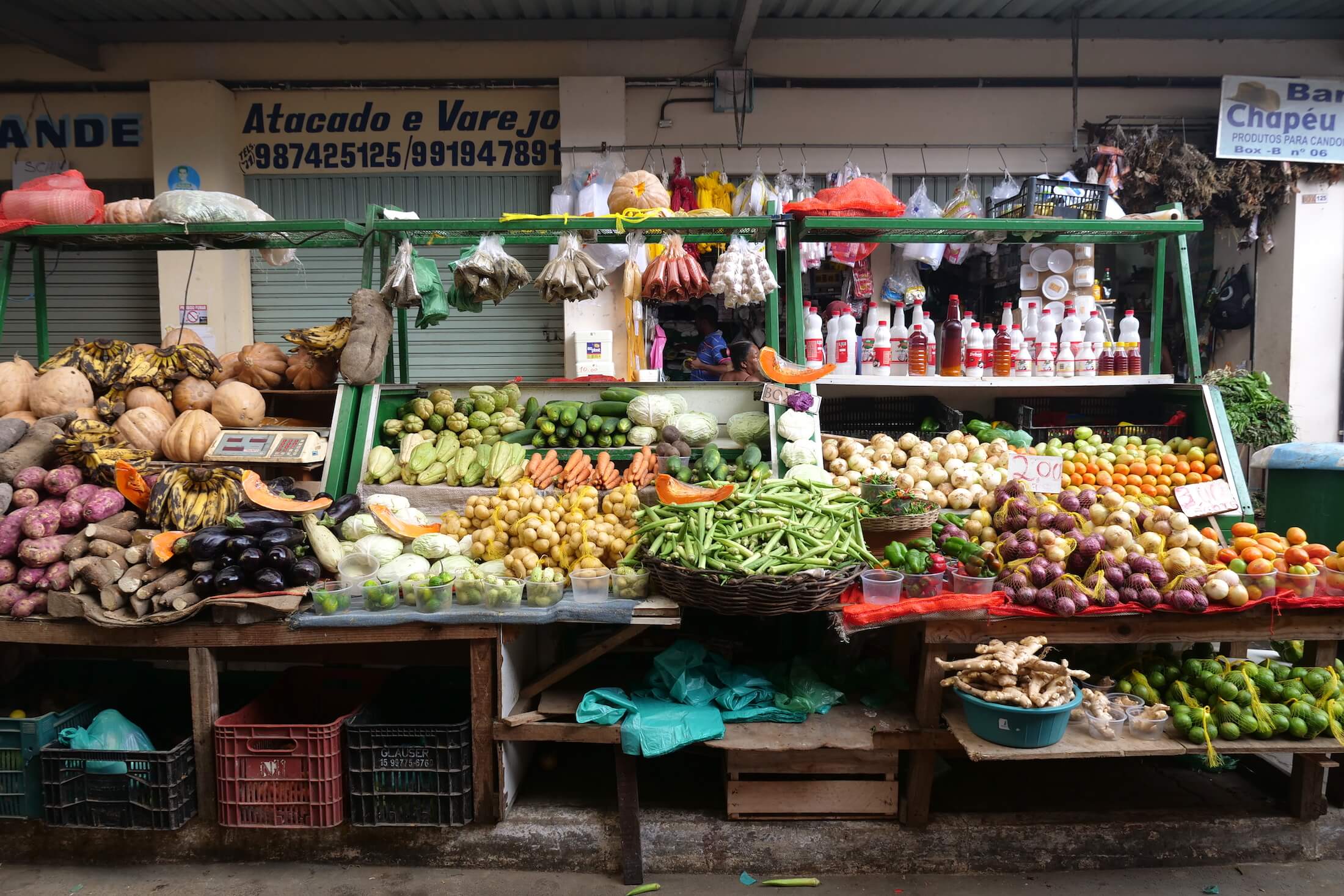
Sao Joaquim Market
You will never forget the powerfully sweet smells that hit you like a wave of jungle aromas, just seconds after entering this fresh market.
As for myself, I won’t forget the friendly smiles and ‘thumbs-ups’ that welcome you pretty much anywhere you walk in Salvador.
To begin our own street food tour of Salvador, we started in the morning at Sao Joaquim Market. By the way, watch the video of our day if you haven’t yet already, you can use the YouTube link here ( link ).
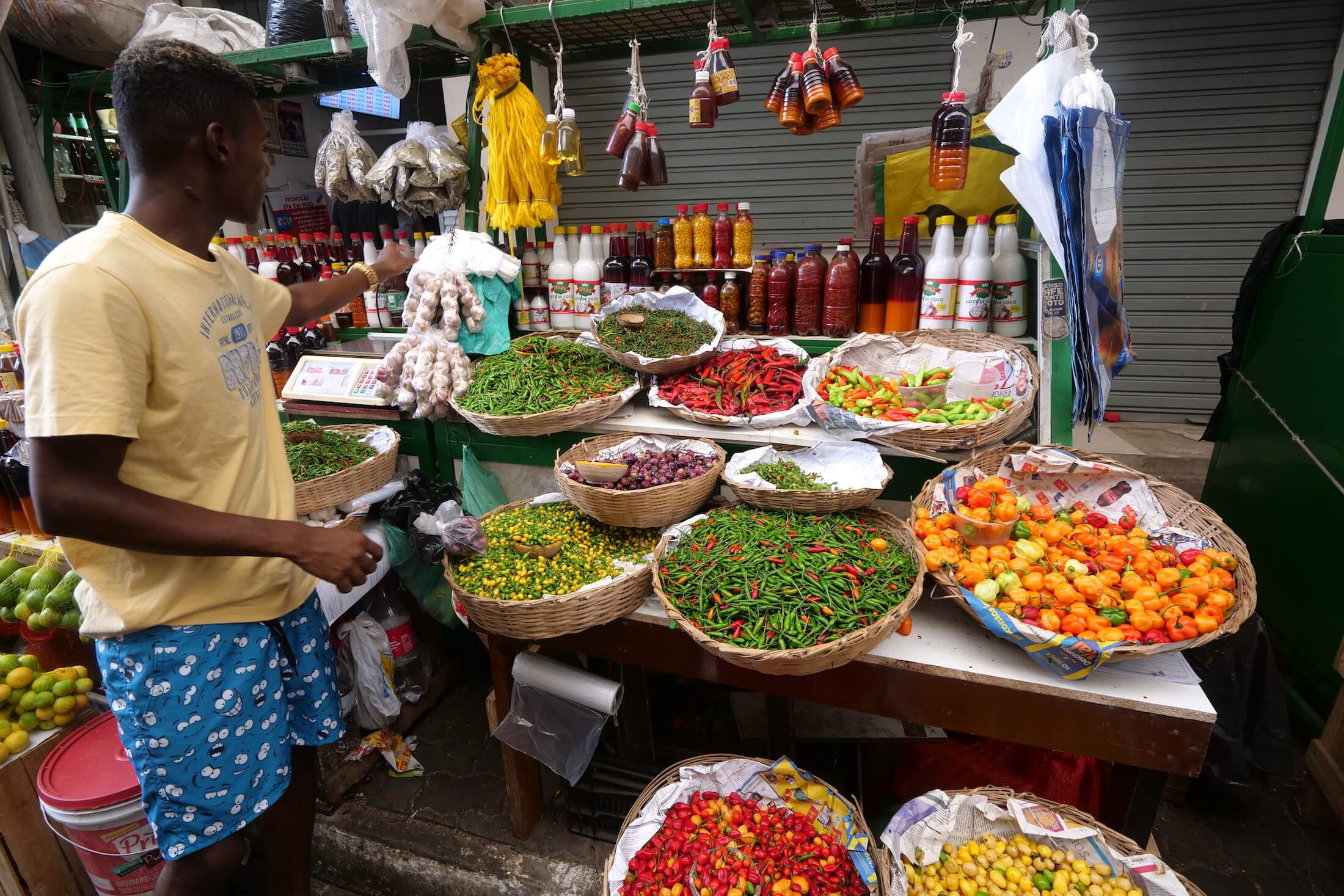
This Market has Everything
This market is full of local food, but as its also near the water’s edge – you can see ships bring in huge amounts of wholesale items here (there’s even a live animal market), as well as a huge area for tons of Brazilian fresh fruit.
This may also be your first introduction to the unique Afro-Brazilian culture of Salvador, which is a huge part of what makes Salvador feel so powerfully unique.
Surrounding the market center are shops selling dry herbs and spices, and many items relating to local Candomblé religious practices.
Recanto Da Lucia For Breakfast
8AM – Enjoy a morning coffee or soft drink at one of the open-air restaurants along the water’s edge, and take a moment to think about where you are in the world (I’m serious, open a map on your phone)
I hope that you came here hungry, because now is the time you should get excited for breakfast. The local food options at São Joaquim market are amazing.
At this time, I recommend that you stop for a gorgeously meaty breakfast at the small restaurant ‘Recanto Da Lucia.’
This meal at Recanto da Lucia was actually one of my favorite of the whole Brazil trip. The location, the atmosphere, the local morning market vibes here are classic – they are perfect and totally ideal for a Migrationology-style 8am meat-heavy breakfast feast.
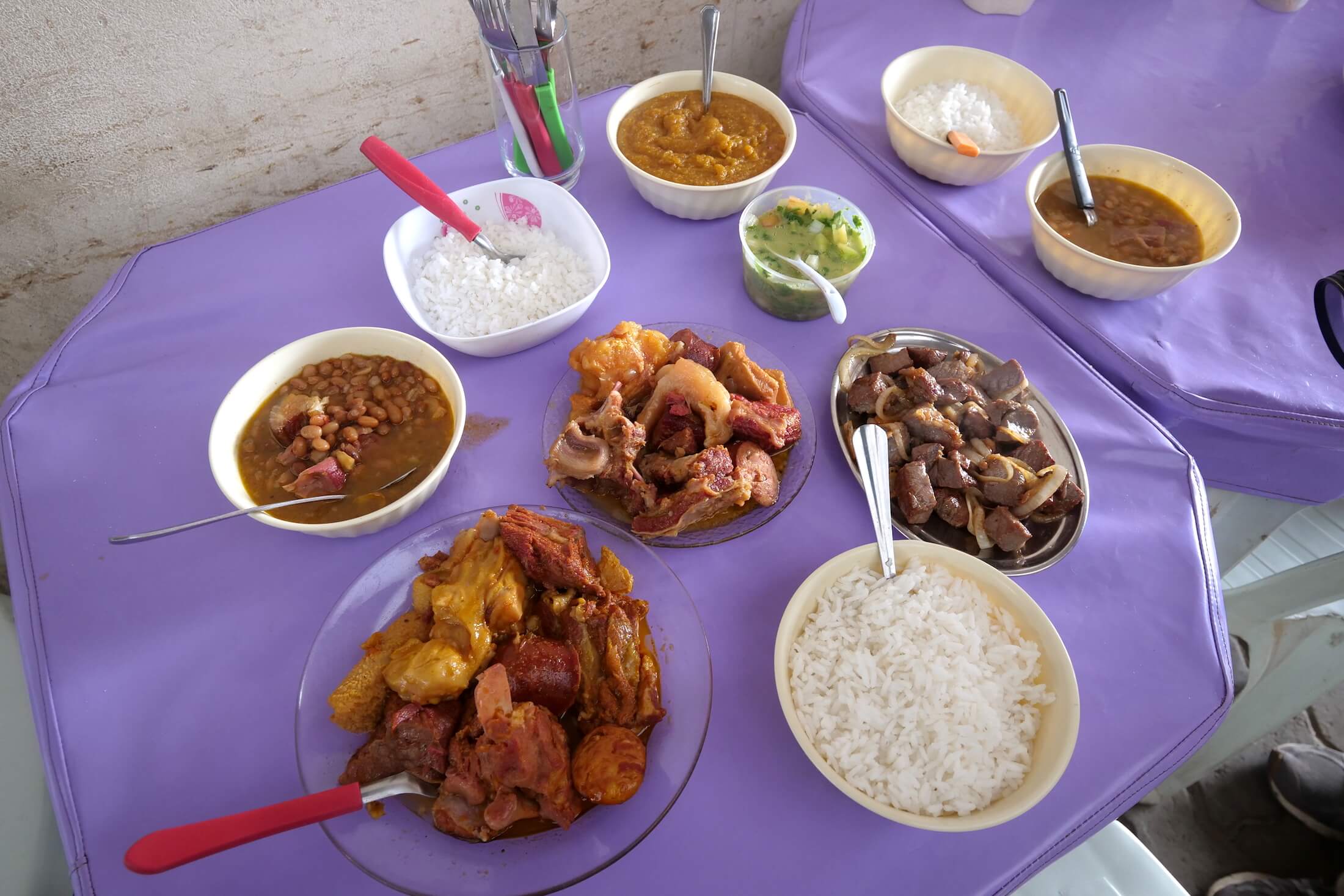
Name: Recanto Da Lucia Location: Its not on Google Maps, but this is the Sao Joaquim Market Entrance ( here ) Hours: No Hours Posted, but we came for Breakfast (around 8am) Price: Our total bill for 4 people, came to 80 BRL ($20.61)
What Mark Ate Here
Order a plate of steaming beef tendons and steak to share, which comes with a side of black beans, and a small salsa-like salad. Follow this by ordering fried beef liver and onions, and don’t forget ask about their pirãu (a local delicacy made with dendê oil and cassava paste, sometimes its not on the menu, but you need to have this food here).
They will serve some incredible spicy and sour dipping sauces to go with these two main dishes of meat, as well as plates of white rice, and a shaker of cassava powder that’s been fried with pork fat (farofa).
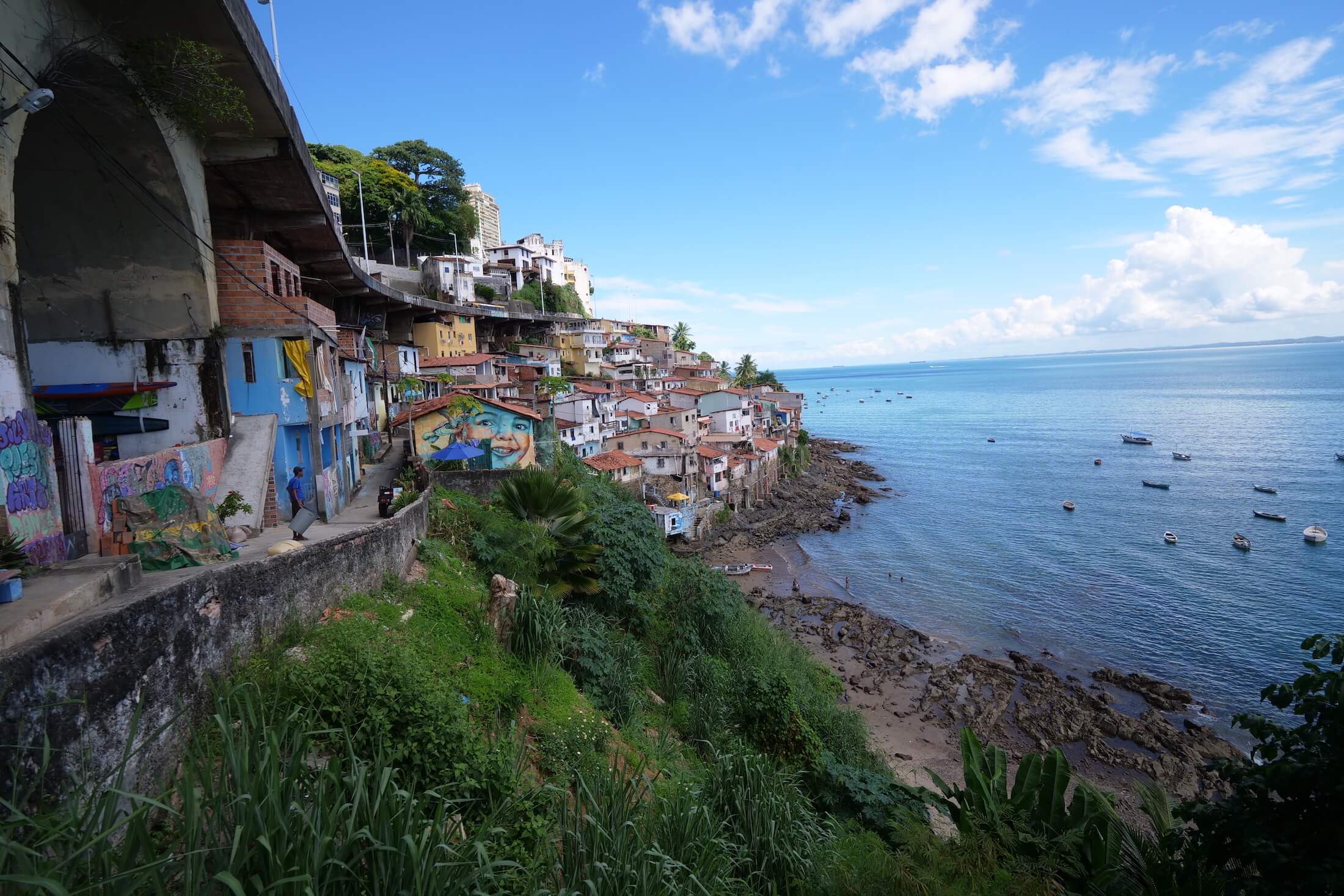
Quiet Local Beaches
9AM – Salvador is on a peninsula, and so it is almost completely surrounded by either rocky outcroppings and small scenic cliffs, local fishing spots, or wonderfully quiet beaches (like this one).
I love how you can find examples of both very modern, but also hundreds-of-years-old Salvador history, directly next to each other, sometimes even directly on top of each other here.

Be Careful Going Down
Getting down some tricky sets of stairs to visit one such beach location, I will still say it is well worth the journey – this is a way you’ll experience yet another side of this amazing city of Salvador.
In the photo below, you can see an old chapel, which is built directly next to the beach in the photo above. The building was a chapel, then a sugar mill, and later a museum, and is a piece of Salvador’s history that’s being kept in beautiful condition.
Get exclusive updates
Enter your email and I’ll send you the best travel food content.
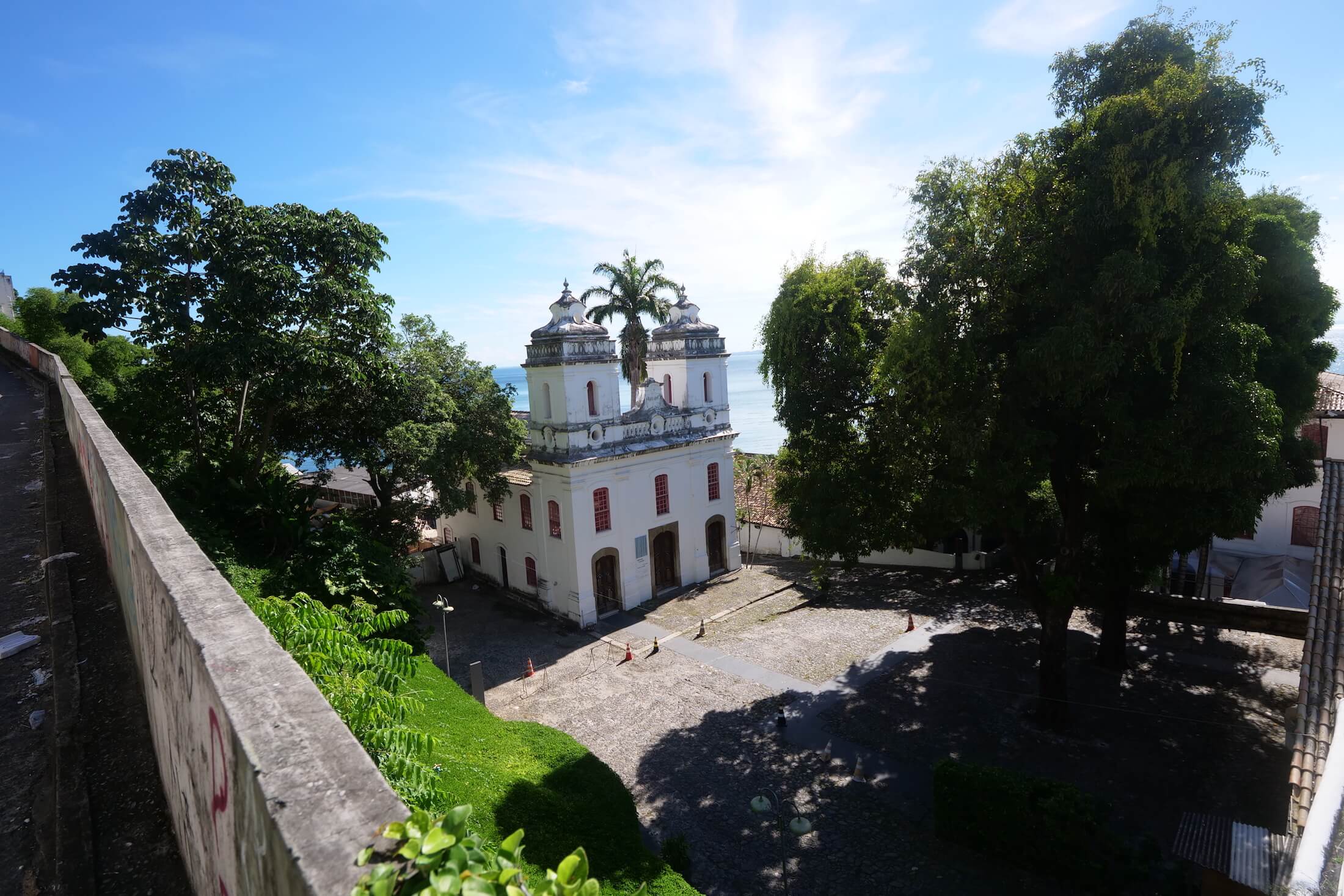
Solar do Unhão
One of our favorite meals in Salvador took place just a few hundred meters past this chapel – you should check out the entire article ( here ) of that incredible lunchtime feast of Salvador seafood.
We didn’t actually go inside the Solar do Unhão museum (we came for an early lunch to Ré Restaurante de Suzana on another day, and the Solar wasn’t open yet). As we were passing through, walking above this place on the cement barriers though, we couldn’t help but notice its beauty.
Beautiful (and Quiet) Local History
The chapel-turned-mill-turned museum is not open for very long each day, so we would love to go back for another visit.
If you have the chance, here’s the information on the Solar do Unhão, and leave a comment below telling us how you enjoyed your time there.
Name: Solar do Unhão Location: Google Maps ( here ) Hours: Tuesday to Saturday 1pm to 6pm, Closed on Sunday and Monday
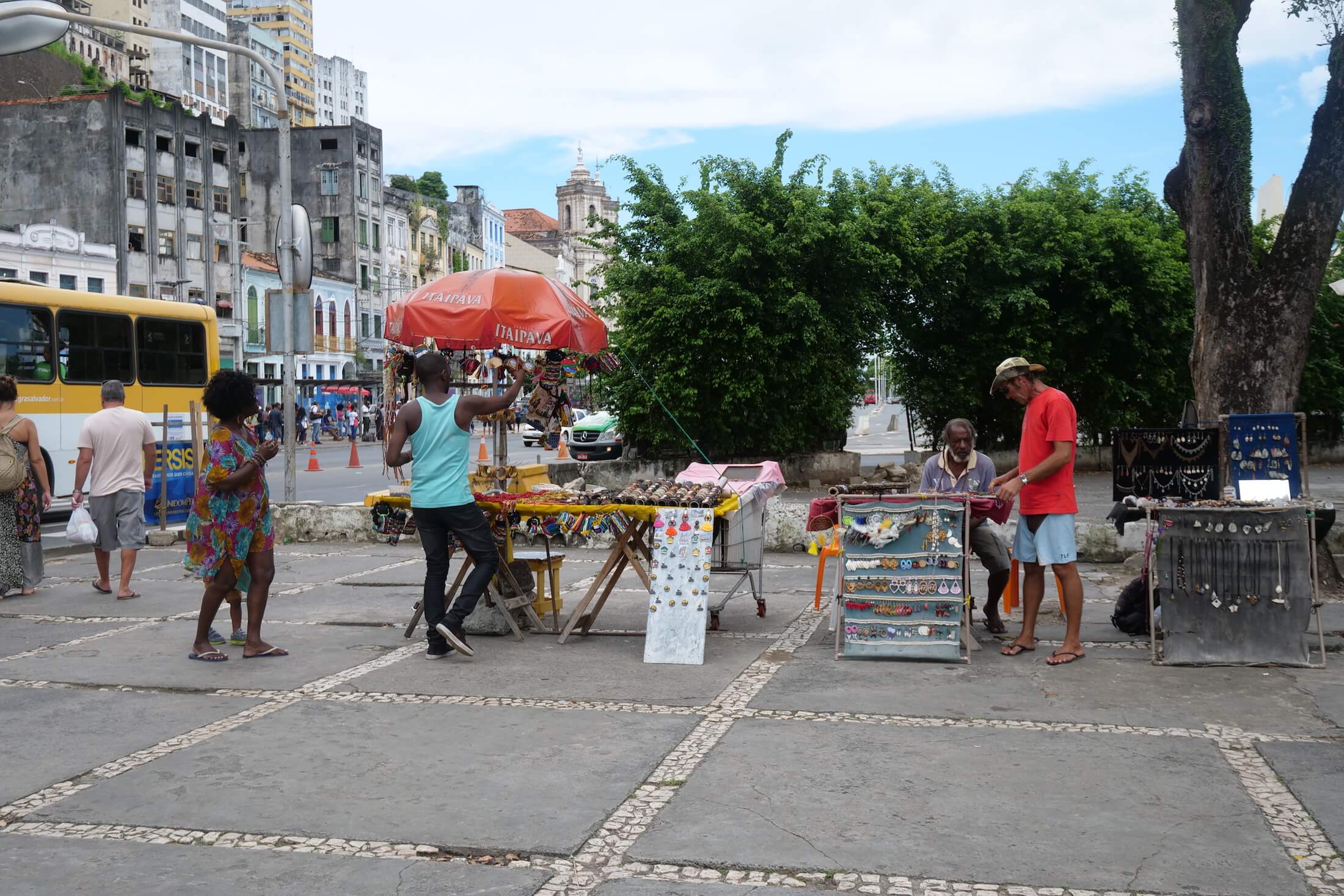
Mercado Modelo
930AM – Next up, on the way to visiting the old town area of Salvador, stop at the Mercado Modelo for a quick drink of fresh coconut water, a chance to buy souvenirs, or even a delicious second breakfast.*
Just 1 km north of the Solar de Unhão and its picturesque beach community nearby, Mercado Modelo is also located right along the bay that borders Salvador.
Although it can be quite touristy, this really is a great location to buy souvenirs to bring home (the market was quite busy each time we passed during the week), as well as being a central transportation location if you enjoy traveling by local bus around Salvador.
Snacks and Food at Mercado Modelo
If you’re not interested in anything but the next meal, walk behind the shops to find some more awesome examples of Salvador local food.

Jacibar Restaurant
While this won’t make the list of the five best things to eat in Salvador (at the bottom of this article), Xinxim de Galinha is definitely an amazing Brazilian food , and surely something that you have to eat at least once during your time here in Brazil.
Surely too, this is a food that you should think about having right now for your second breakfast today in Salvador.
Walk through the market and take a right, find the small row of kitchen type kiosks called ‘Jacibar Restaurant.’
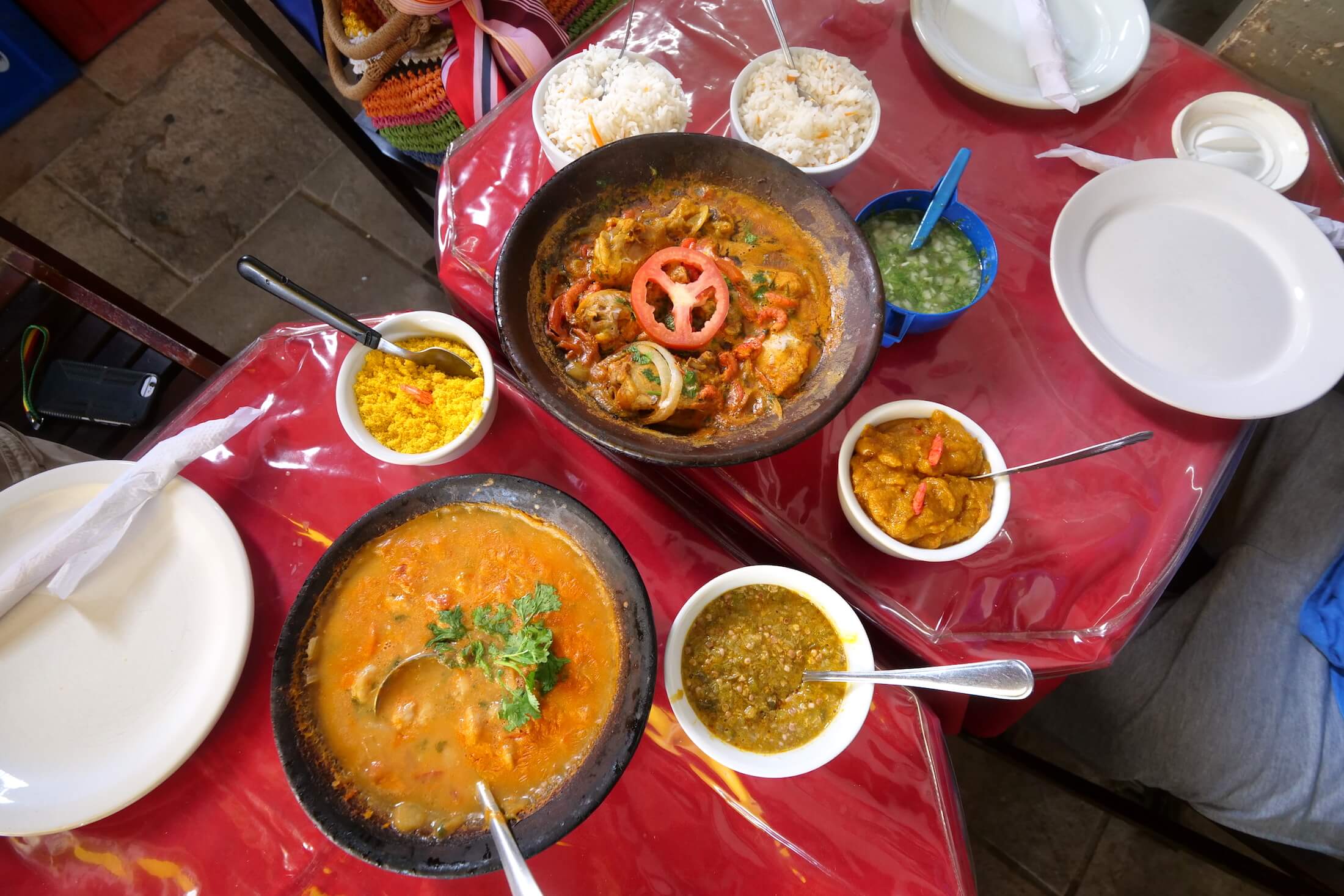
While the rest of the market is pretty touristy, there are many delicious local dishes to be found with Senora Jacy (Jacibar).
Besides Xinxim de Galinha, the bobó de camarão is delicious, and also the caruru. An incredible meal, and very cool to see how the atmosphere and vibe changes so much, sitting in basically an indoor alleyway just meters from such a touristy area.
Name: Jacy Restaurant Location: Google Maps ( here ) Hours: Open Daily, 7AM to 4PM, Closed on Sunday Price: Our total bill for 5 people, came to R$180 (US$45)
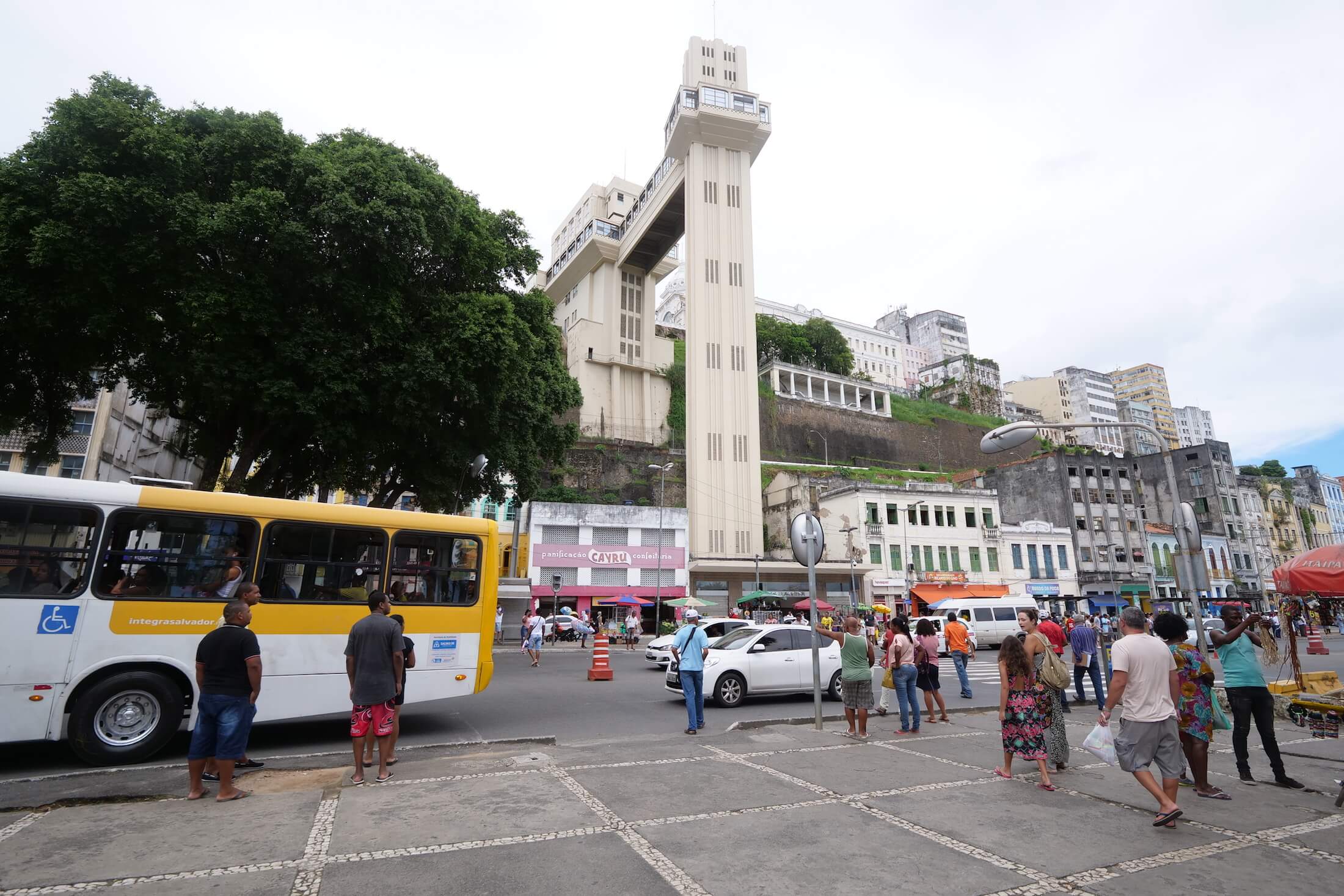
Lacerda Elevator
11AM – Walk directly across the street from the Mercado Modelo, and travel about 80 vertical meters upwards in this elevator that’s over 100 years old.
An old elevator, and yet very much still in use, this is a well-loved piece of Salvador’s history. The Lacerda elevator connects the lower and upper city areas, and wow – what a view from the top!
I think this is one of the cheapest entrance fees I have ever paid anywhere (without it actually being free), as each passenger costs R$.30 each way (US$0.08).
The lift itself has no windows, but there’s a long set of them inside the entryway, and the view overlooking Salvador here is incredible.
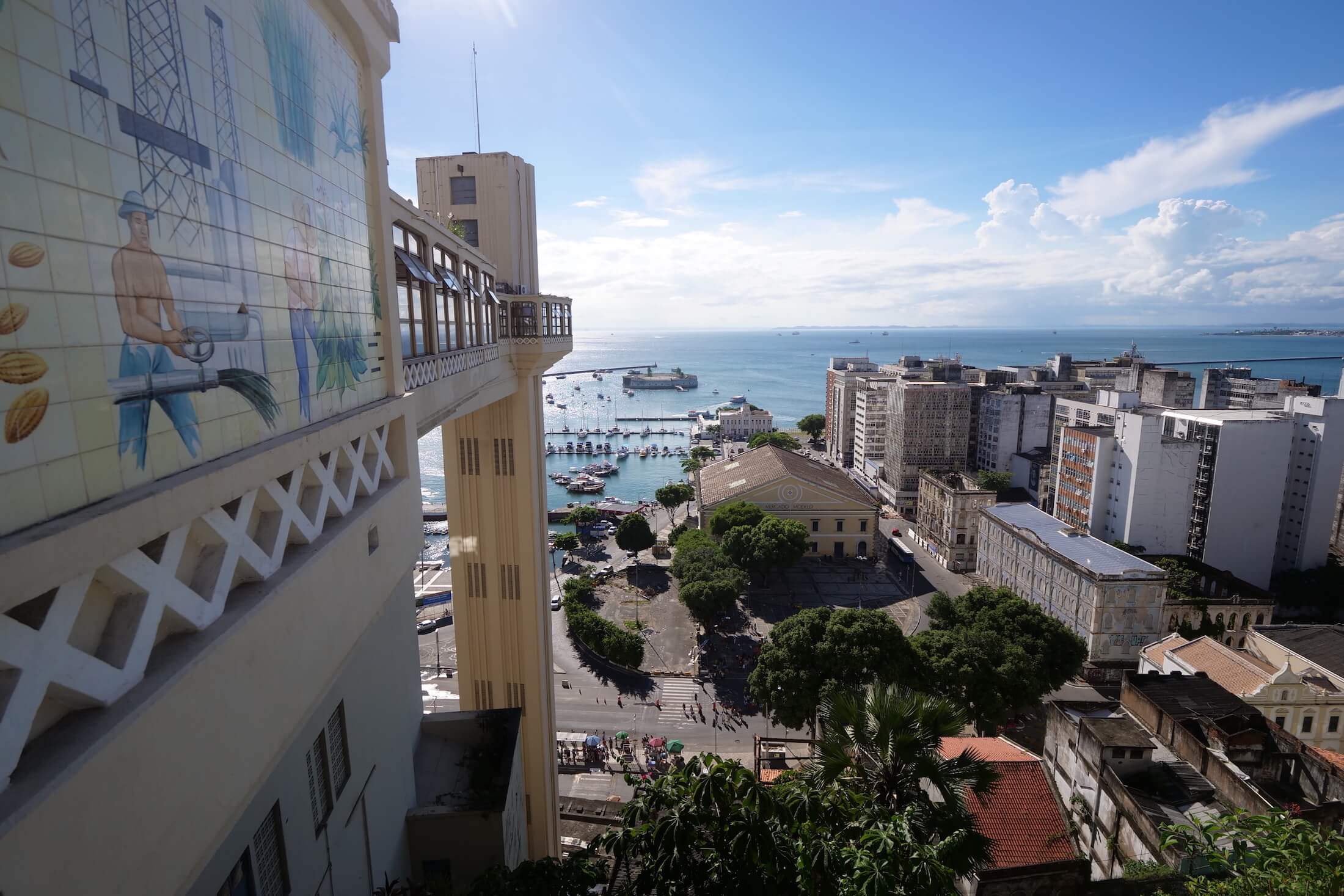
1130AM – Any chance to stop and have a cup of fresh Brazilian coffee is welcome, especially when it comes with a view like this one.
Most of the coffee in Brazil comes from the Central Southern state of Minas Gerais, but the state of Bahia grows plenty of delicious coffee as well.
Have your second (or maybe your third), cup of coffee for the day here, look out over Salvador and the waters that surround it, and dream of the delicious seafood that you will be eating later today.
If coffee is not interesting to you, then this could be a good chance to try Brazil’s iconic soft drinks – the Guarana drink made by Brazilian company Antarctica is very sweet and has a unique taste as well.
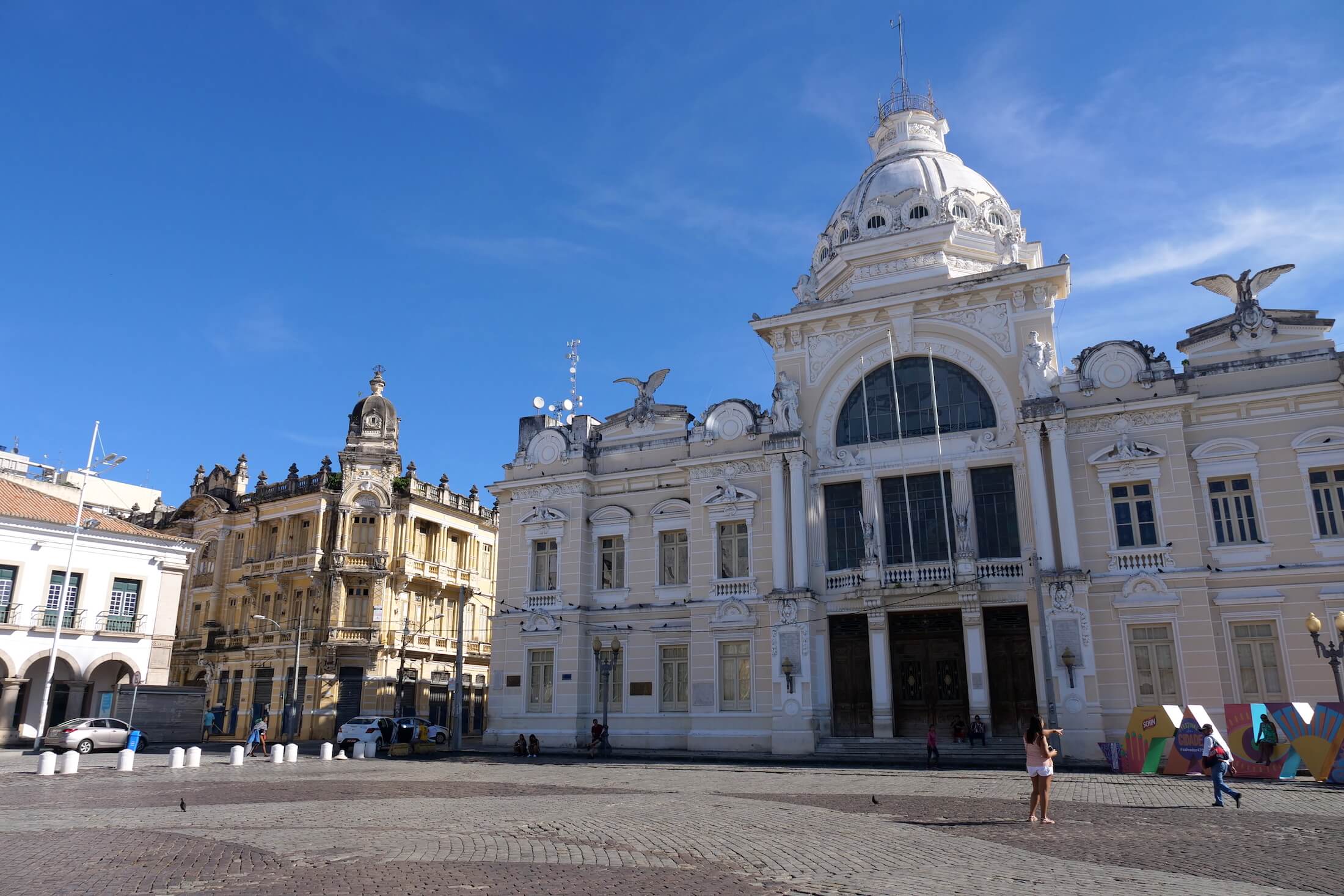
Note: This could be your starting point for Part 2 (or a second day) of things to do in Salvador.
NOON – After a gastronomic introduction to life in Salvador da Bahia, you should make your way to learn a bit about the historic area of Salvador as well.
Exiting the Lacerda elevator, the area you are now entering is Pelourinho.
A beautiful area here, and an older part of the city, this area is full of hostels, nicer restaurants and cafés. You’ll find tons of local streets snacks in the incredibly narrow streets, and an abundance of great photographs waiting around every turn.*
Here you can also see demonstrations of Capoeira martial arts, Olodum drumming practice, and on the way you’ll almost feel like you are in Portugal – the streets and architecture here have so much obvious European influence.
*Note: If you have a rental car, be prepared for some tricky driving and parking, the streets here are extremely narrow, and some of the roads quite steep.
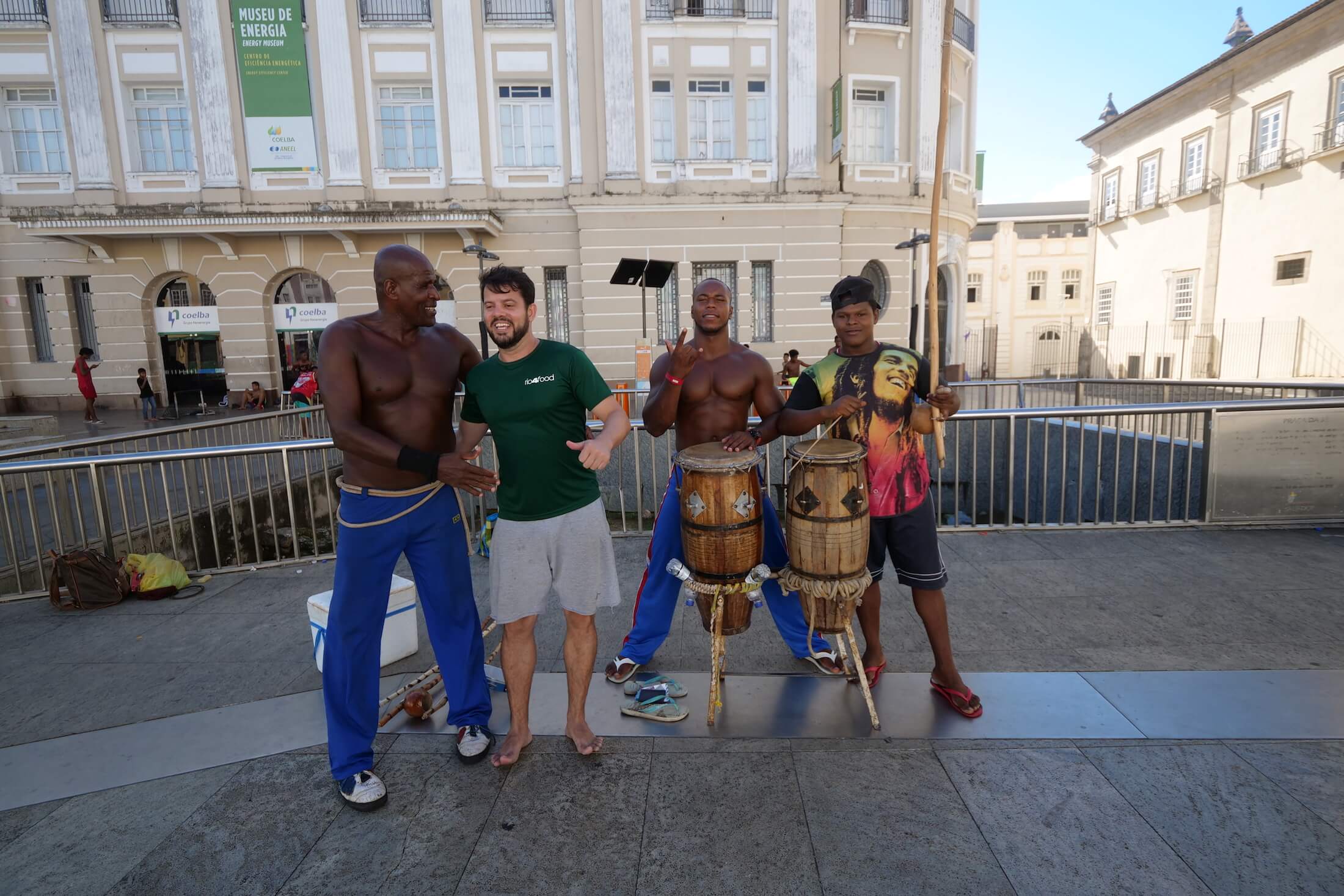
Capoeira (Martial Art)
Part of the unique culture in Salvador, and something you absolutely cannot miss while you’re here, is seeing a performance of the Brazilian martial art of Capoeira .
This unique and complex martial art was developed by African slaves who had been taken to Brazil in the 1600s. It is quite acrobatic, one could almost think that they are dancing, and the movements are mesmerizing to watch.
You can sit back as a spectator, enjoying the music that accompanies a practice demonstration like this, or feel free to ask if you can take part as well.
Note: There is no fee, we found this group practicing in a public area. Of course, as performers doing this for their daily living though, they appreciate tips if you enjoy the show.
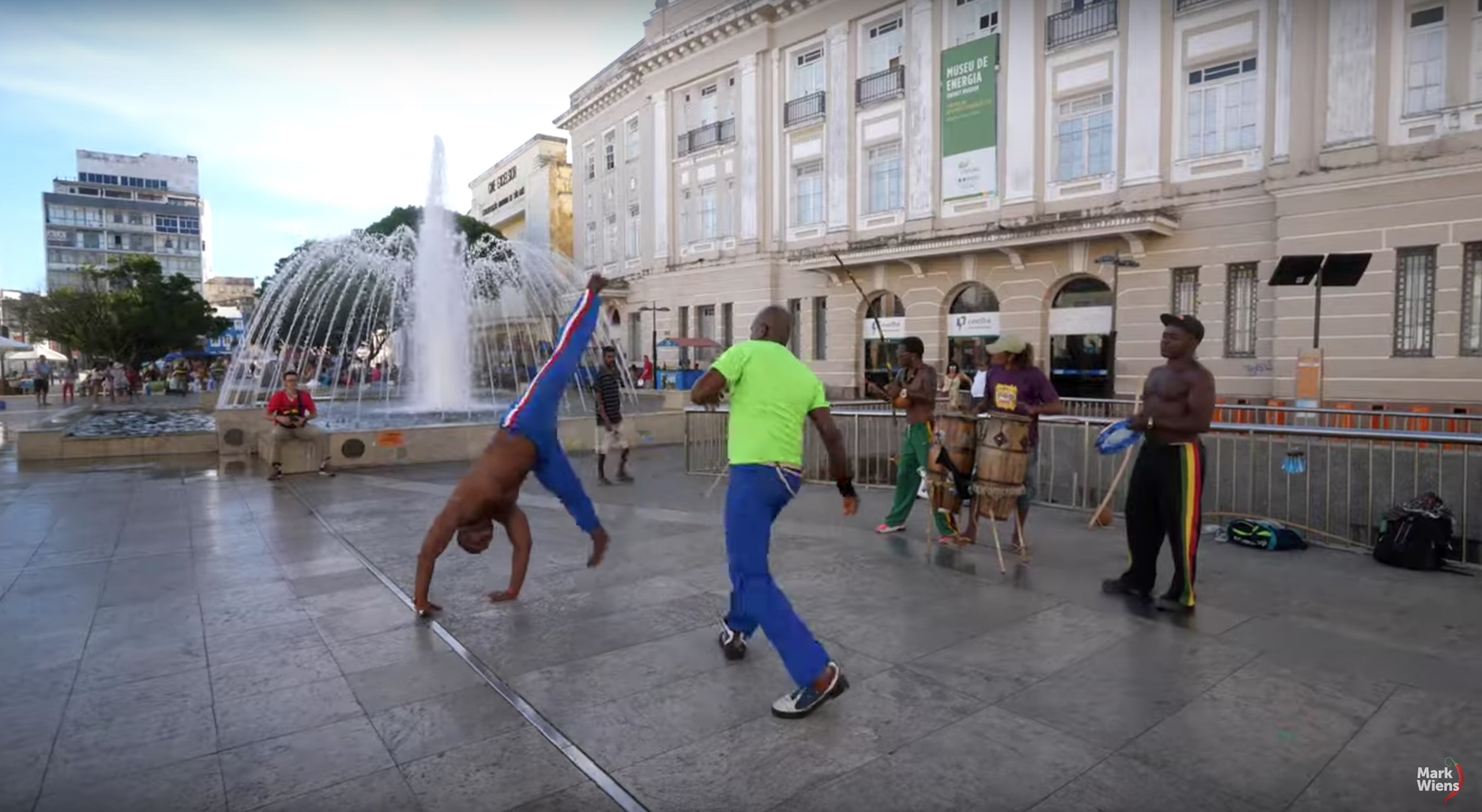
What you see here is not a fight, but a practice session – a ‘ Roda .’ This is also how the martial art of Capoeira was disguised in the past, and practicing this way includes music and simple singing, and one very unique instrument which determines the rhythm of the Roda.
As slaves developed a way for themselves to practice without needing to hide, they could stay fit, while also being a part of something, overall giving themselves something of their own of which they could be proud.
Local Martial Arts in Brazil
Like most martial arts, there are of course many groups of people who practice this very seriously, and would seriously injure you, were you to attempt to join in.
I think it is so cool though how there is also this other side to this martial art of Capoeira, one that is fun, musical, and so unique. It is welcoming to a spectator experience, and if you have a chance, I recommend trying it out for yourself.
Here’s some info on the ‘ Berimbau ‘ as well, such a cool and unique Brazilian instrument, read a bit to learn how incredibly complex practicing the Capoeira rhythms can be – its incredible.
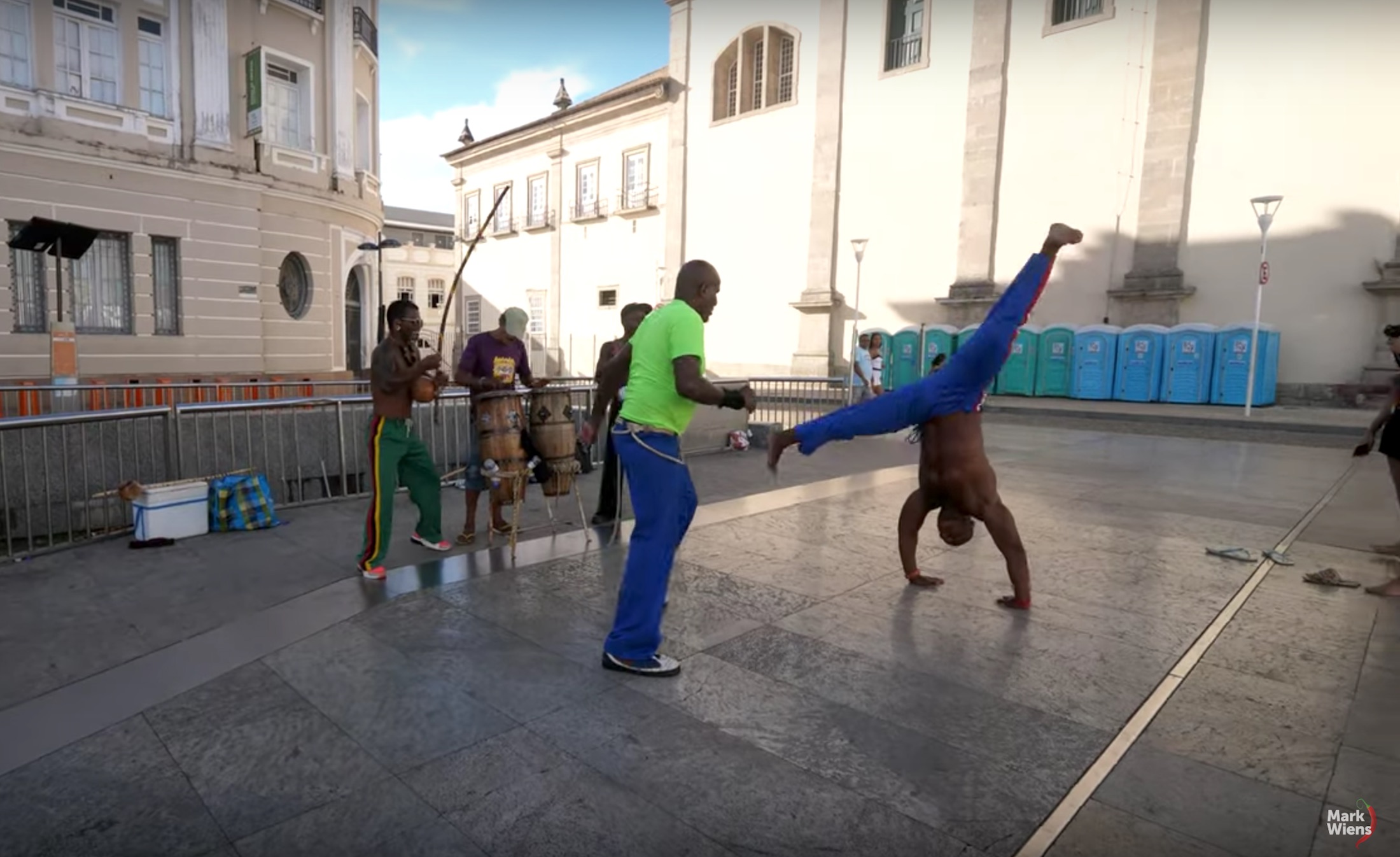
Centro Histórico (Historical Center)
Besides the incredible displays of love for their local traditions, this is the area where the people of Bahia will direct you when you want to find churches, museums, and the beautiful examples of local architecture, spanning across the years of both colonial and modern Brazil.
We did not take very much time to explore around in this area, but it is very obvious that one could spend many days here in the Historical Center of Salvador. This is likely the best place for those learning about the history of Bahia, and a great place to get a feel for the gorgeous diversity that the state of Bahia adds to the greater country of Brazil.
Name: Historical Center of Salvador Location: Google Maps ( here ) Hours: Open Daily
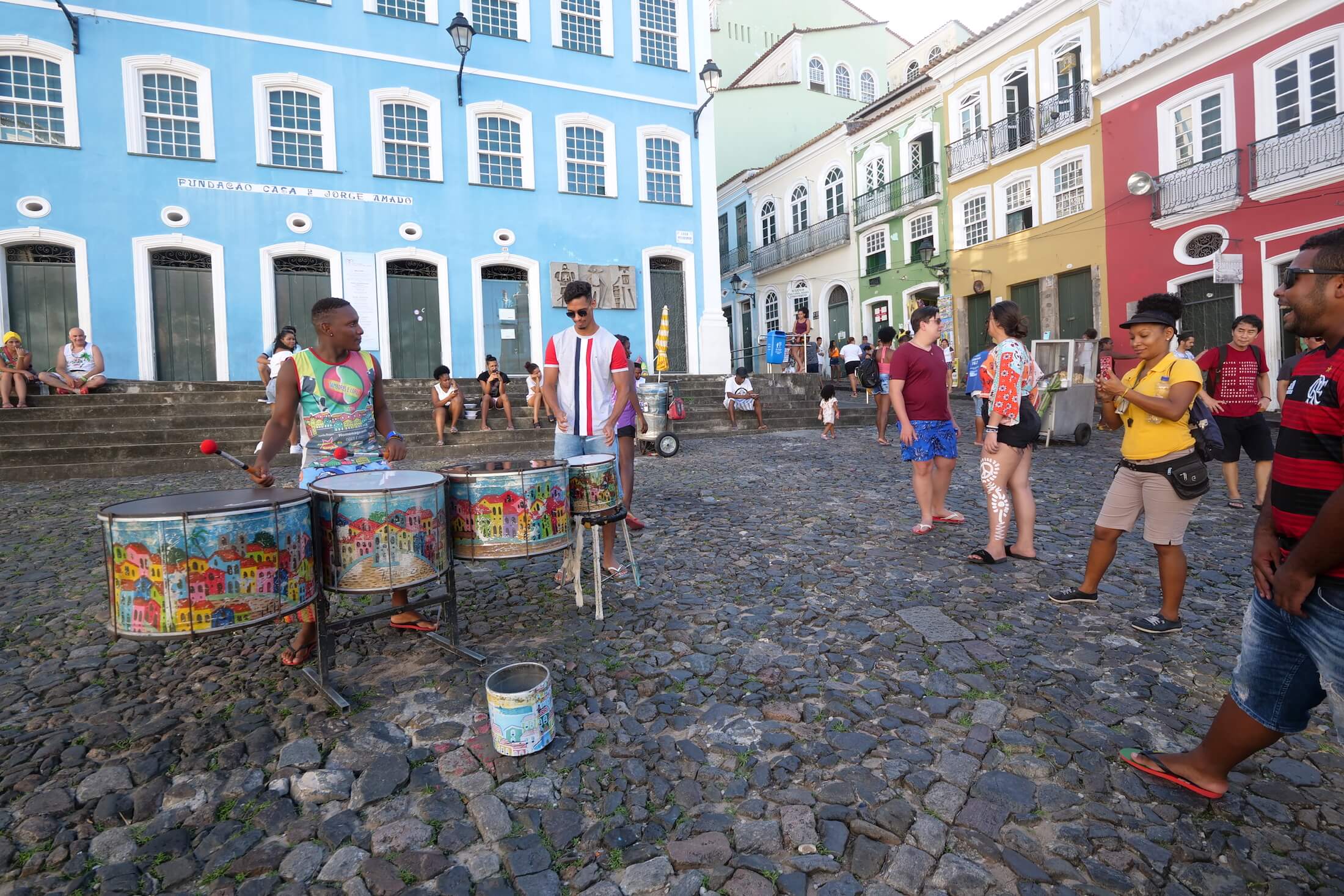
130PM – Featuring mostly drums and rhythm, followed by dancing and finally singing, Ololdum is a unique type of music and a huge part of the state of Bahia’s modern culture (wiki article here ).
Definitely one of the most well-known things about Salvador, the local Olodum music tradition was one of the things we were most looking forward to seeing for ourselves.
Near the historic area of Pelourinho (mentioned directly above this section), you can watch at least a small group of people who are involved in Olodum, practicing drumming rhythms every day.
Salvador’s (and Brazil’s) Love of Music
If you want to see the full Olodum carnival performance however, you are going to need to visit Salvador in January of February. Traditionally, each Tuesday is treated as a full practice day, and if you’re wondering why it takes so much organizing, you can check out a video here .
Carnival is one of the most amazing things in all of Brazil (the video above is only the Salvador carnival, Brazil’s Carnival (in Rio de Janeiro each year) is even larger!).
In my opinion, what on earth could be more cool than people getting together to cheer and support musical performance with the same passion that most people cheer for sports? Of course Brazil has great athletes as well, but its their love of music which is so amazing and wonderful, and it is something in our world about which we all need to learn more.
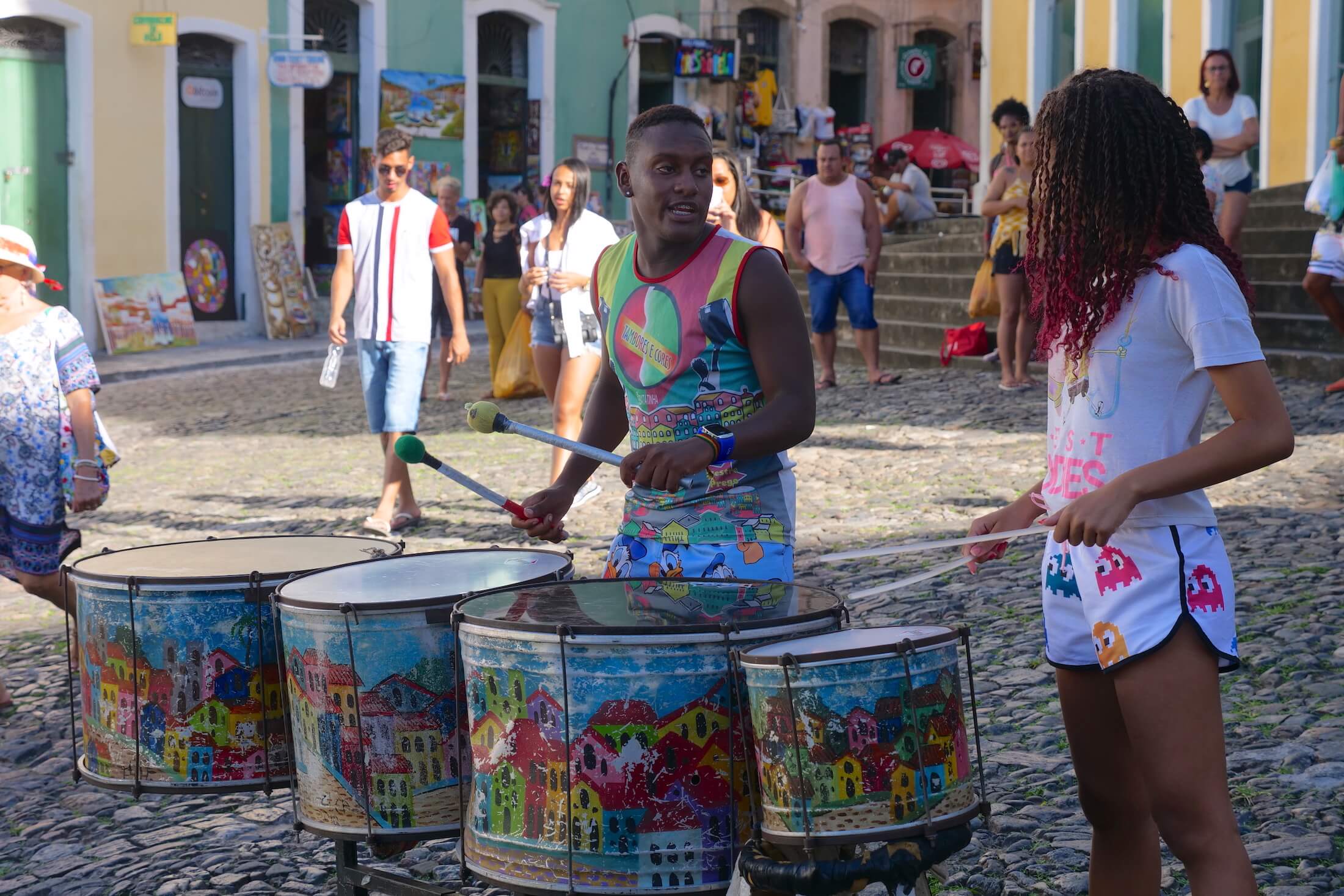
A School of Music and Tradition
Olodum is more than just a single music event, and it could be called a ‘school of music tradition.’ Basically, Olodum hopes to be the culture, ideas, and traditions of the state of Bahia in music form.
It has grown over the past 50 years (since its creation) into something that has transformed the entire local community of Salvador, as well as gaining fame almost worldwide. What started as group performance in Rio de Janeiro’s Carnival, Olodum exists now with a purpose of promoting and educating about Bahia’s history, culture, art, and gives a voice to the identity (and pride) of what it means to be from Bahia.
Final Notes Before Moving On
Salvador, Bahia, in Brazil, is a place that will undoubtedly exceed expectations. The food and people are outstanding, and will always make it one destination you will never forget.
What a stunning combination of natural beauty, food, and hospitality.
Note: From here, the time can be adapted to your own schedule, Each of the five food listed below comes with information on where and when to have it, but the order is up to you.

5 Best Foods of Salvador
Of all the wonderful things about this amazing city of Salvador, my favorite has to be the incredible Afro-Brazilian food culture.
Literally blooming from every street corner in town, this truly is a unique place in our world – there’s simply nowhere else like Salvador when you visit Brazil to travel for food.
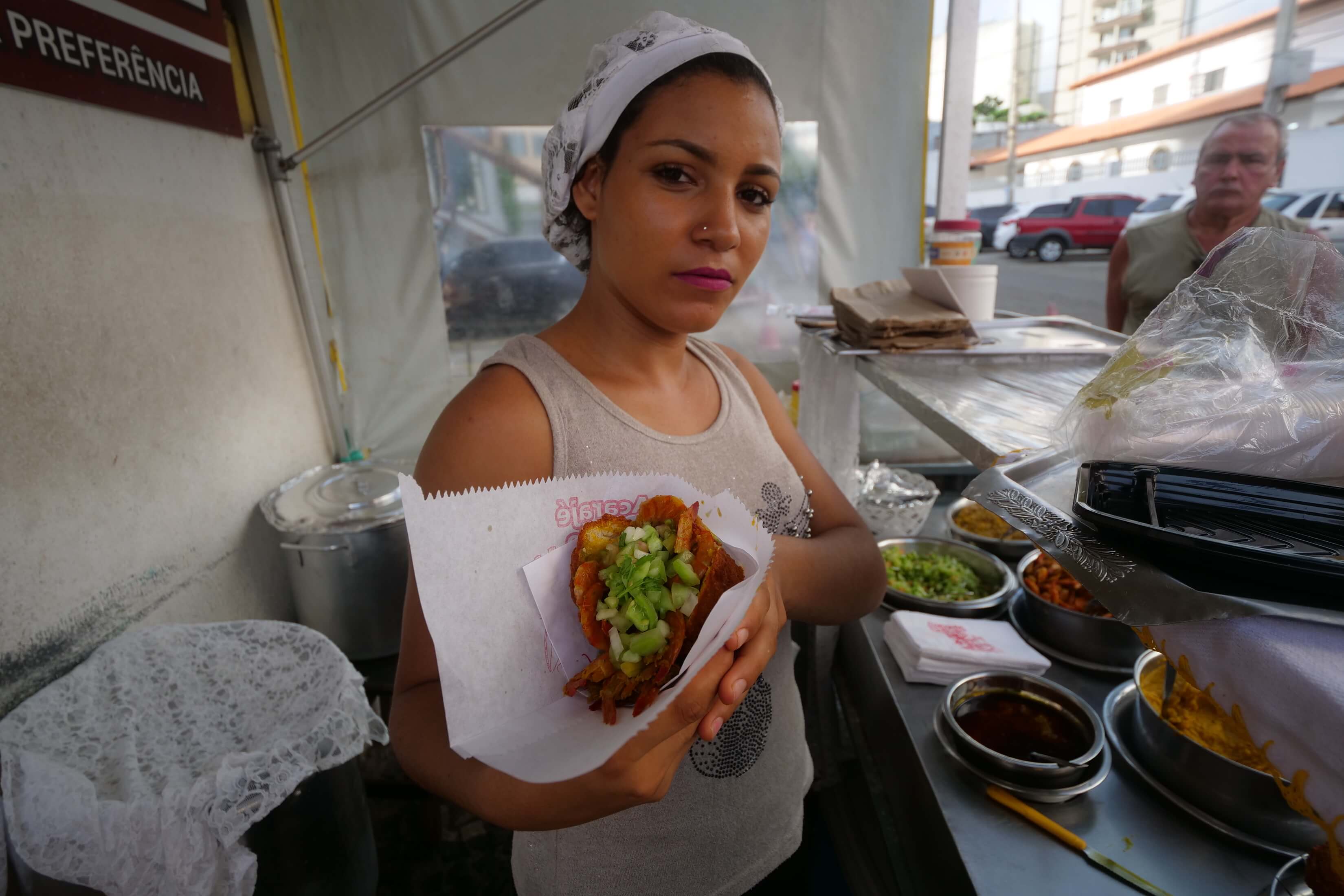
You Really Should Try All 5 of These Foods
The following list is not in order, all of these foods are incredibly good, and all of them are worth a trip to Salvador just to eat.
You will find information about when and where we recommend having each food, and if you do want to have all of them in a single day (which is possible), then please let us know how you enjoyed yourself by leaving some words in the comment section below.
Finally, we think that these are 5 dishes that will give you the most real and lasting memories of your (delicious) time in this incredible part of our world.
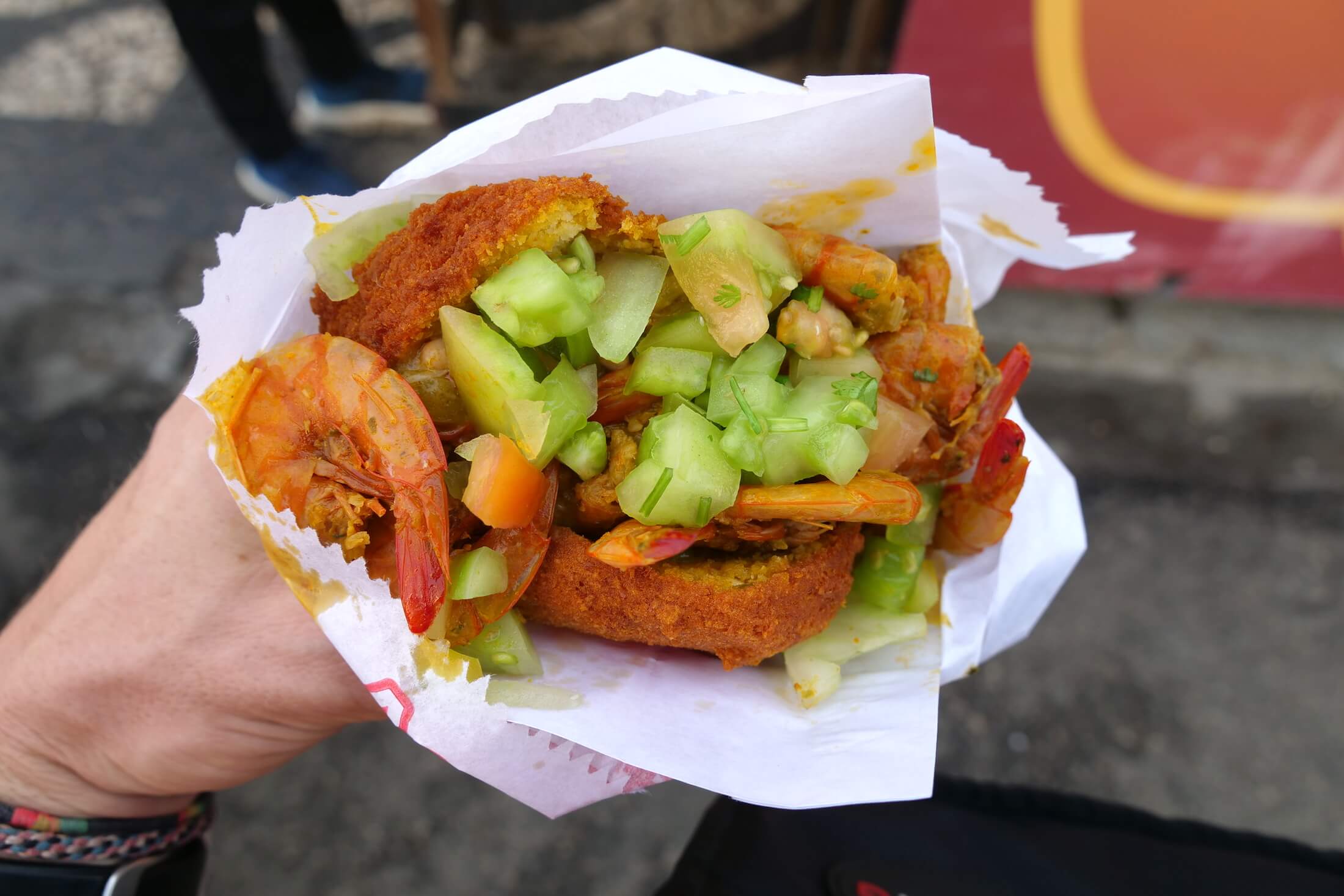
Acarajé is without a doubt one of the best and most ultimate street foods in the entire world.
To paraphrase a chef friend’s statement during a previous trip (traveling for food in Asia ), “you haven’t actually been to Salvador, if you haven’t eaten Acarajé.”
There’s no way you can visit Salvador and not allow your mouth to be completely blown away by this food.
What Is It?
Starting off by deep-frying black-eye pea cakes in red palm oil (dendê oil), the acarajé-maker packs each sandwich-style patty with a selection of local delicacies. You choose between some thick pastes of okra and cassava, the chef adds in some green tomatoes, and don’t forget the chili oil, and maybe a few entire chilis.
You’ll get a wonderful gentle crunch each time you bite through the outer fried patty, and the delicious warmth mixing together the mushy vatapá (the cassava paste), the gooey cururu (the okra paste), and those entire salted shrimp… it’s actually difficult to put into words how happy your mouth will be.
The onions and cilantro finally come in with the green tomatoes to add brightness to each bite, a squeeze of lime makes the tongue tingle, and finally the slow burn from the chili and chili oil just sets this food apart from all other contenders.
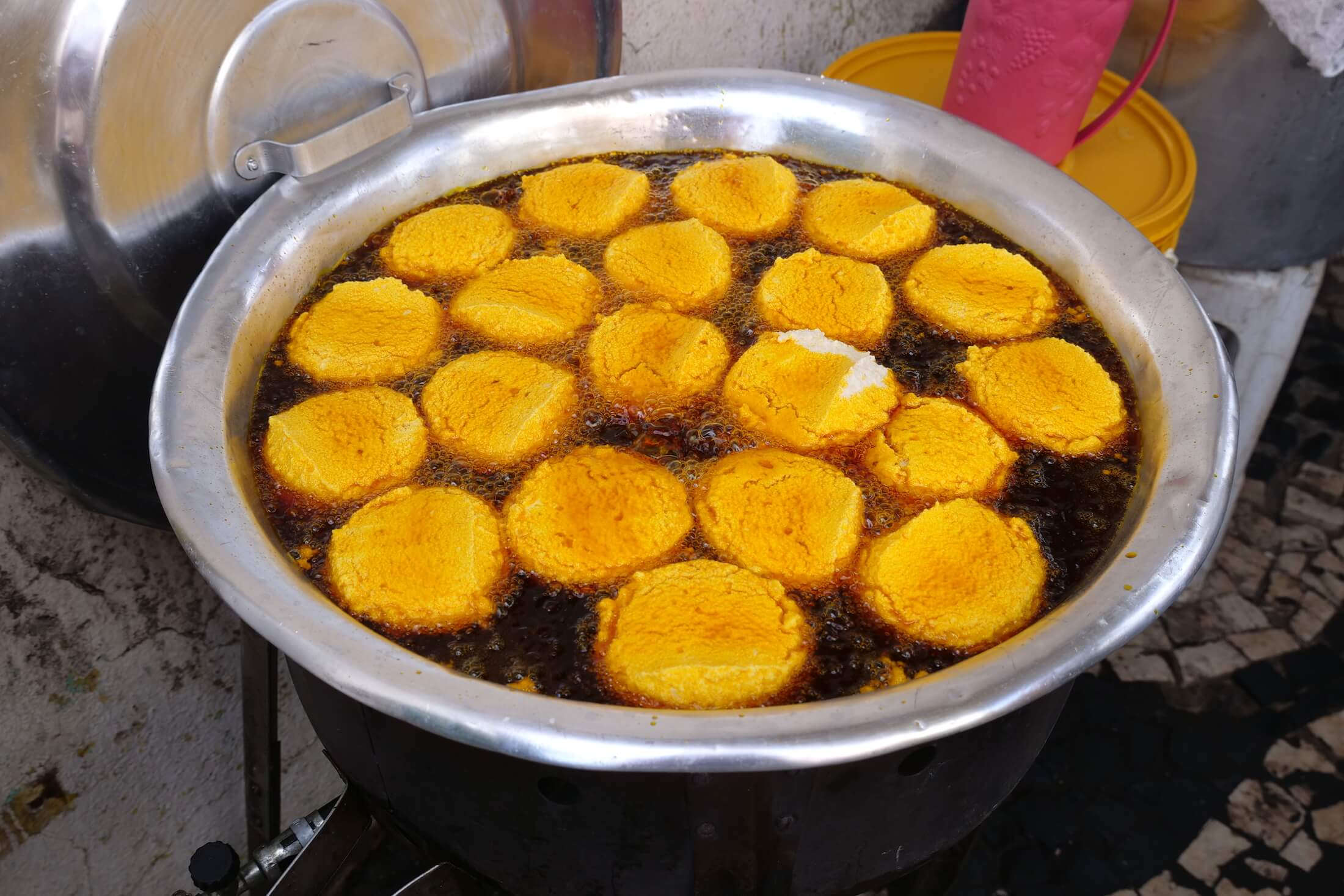
Where Do Brazilians Eat Acarajé?
If you’re in Bahia, you’ll probably find your way to Salvador at some point – and visiting Señora Ivone needs to be right at the top of your list!
She is famous, while still maintaining just the same single-station street cart. You can tell the dedication of her followers though, as we were there at least 15 minutes early, and we were definitely not alone!
Order (at least) one Acarajé with shrimp, and one Abará as well.
Name: Acarajé de Ivone Location: Google Maps ( link here ) Hours: Open Daily, 3pm to 8pm, Sunday 10am to 3pm Price: R$6 for basic acarajé, up to R$10 for shrimp (US$1.50-2.50)
When to Eat Acarajé
This is usually an afternoon snack/meal in Bahia, so be sure to clear your schedule from about 4pm onwards.
If its your first time having Acarajé, you’ll likely find yourself immediately ordering seconds.
The powerful feeling of pleasure, just the heart-warming happiness that comes with eating this food, is a feeling that will stay with you a long time. I can’t think of many more handfuls of food in my entire life that left me with a more complete sensation of food happiness.
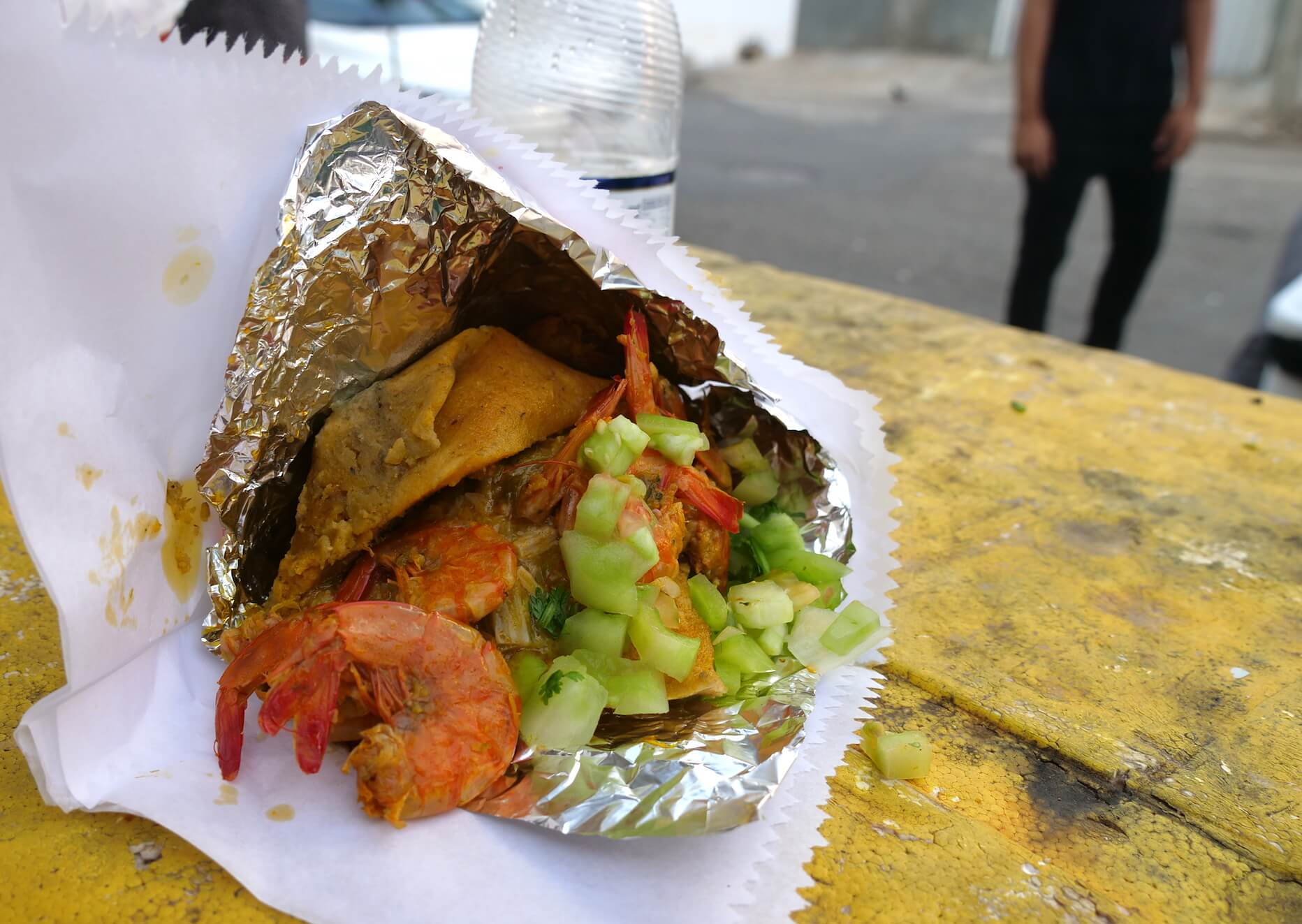
On your next trip to Brazil, visit the diversity of Salvador, Belo Horizonte , Curitiba , Manaus , Belém , Goiania , and Rio de Janeiro – these are all places that we visited ourselves – and experience love for Brazil through its food.
Bahia is an amazing place, and the next dish here you have to search for is Moqueca.
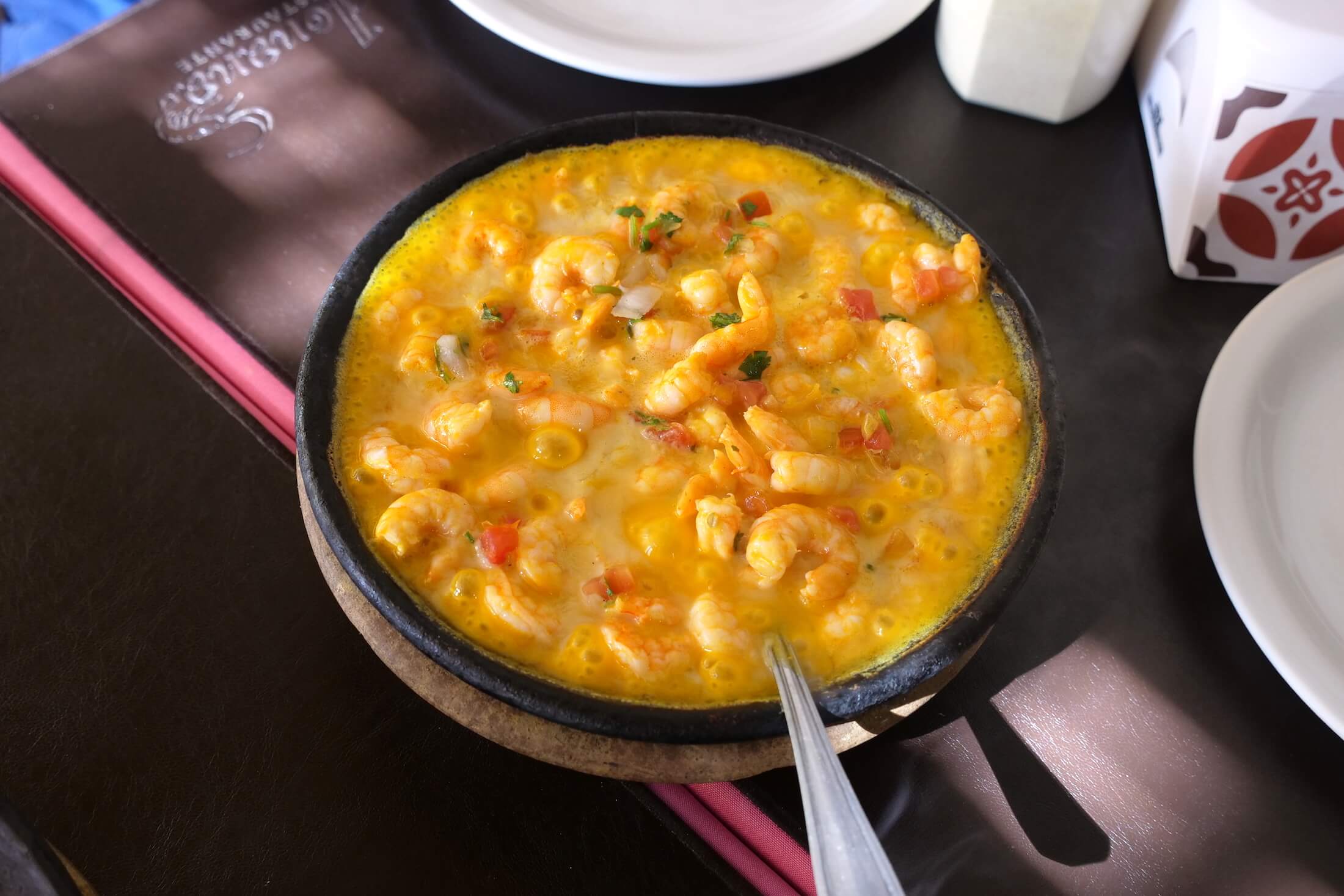
There are actually two slightly different types of Moqueca, one which comes from Espiritu Santu , and one from Bahia (the state of which Salvador is the capital).
Moqueca is the most famous dish from the region of North East Brazil, and a delicious food that you definitely need to have when you’re here in Salvador.
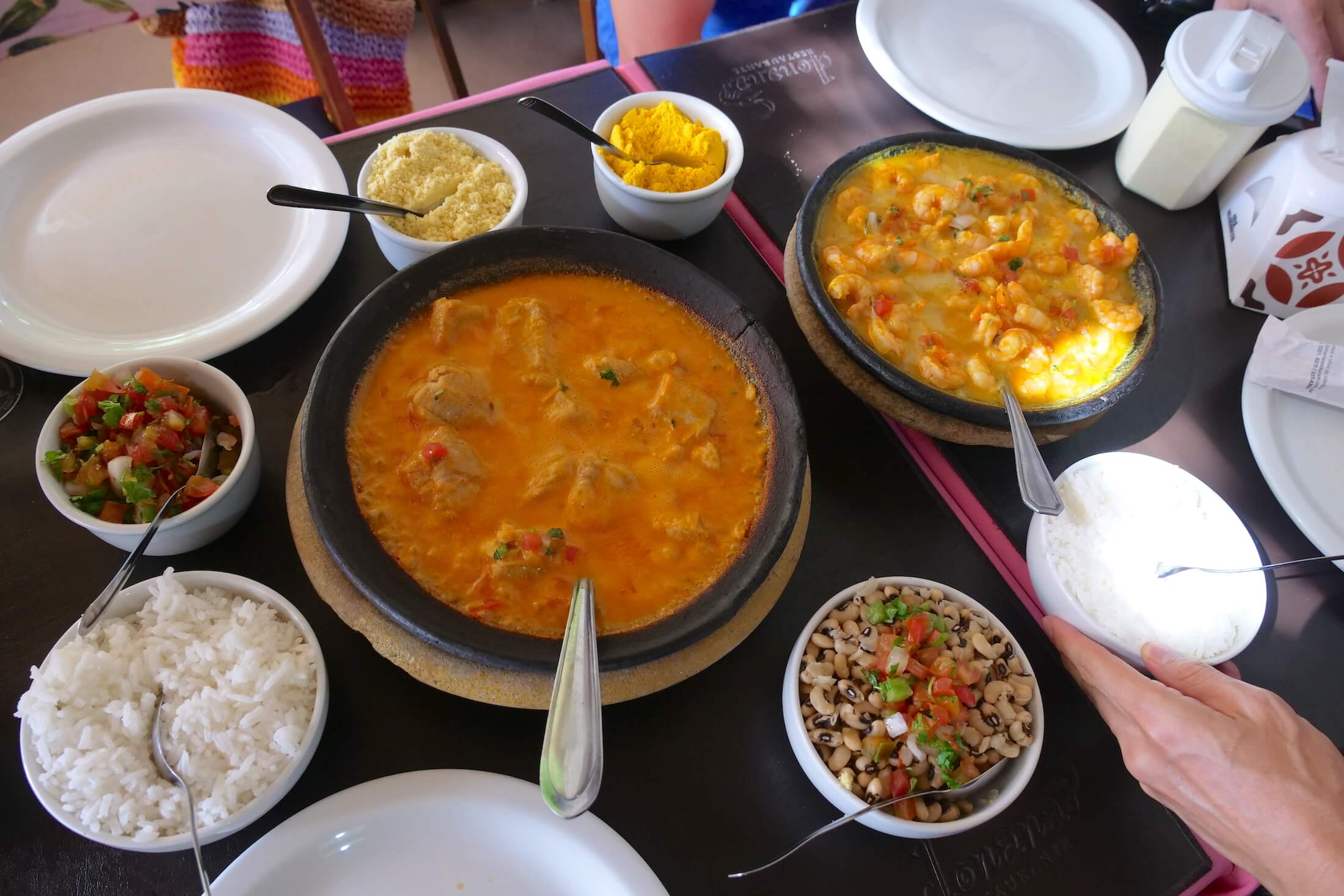
How to Eat Moqueca
Moqueca is traditionally a clay-pot stew of ocean fish or seafood, and tastes best when you have it as a main course item surrounding it with a huge spread of side dishes.
A common ingredient in Moqueca is shrimp, but as Moqueca in Bahia always cooks in this black clay vessel (thoroughly and wonderfully mixing the flavors together over longer, lower heat) they often choose to use a few other meats that might not be nearly as flavorful on their own.
Dry fish is common, as well as stingray, manta ray (like another version we had here ) and you can really enjoy some true, traditional flavors of Salvador’s favorite food with a huge meal around a seafood stew of Moqueca.
It might look like a curry, but the rich color comes from healthy portions of both coconut milk, and red palm oil (dendê oil).
Where Do Brazilians Eat Moqueca?
Name: Donana Restaurant Location: Google Maps ( link here ) Hours: Open Daily, 12pm to 6pm Price: R$87 for our entire meal here, 5 people including drinks (US$22)
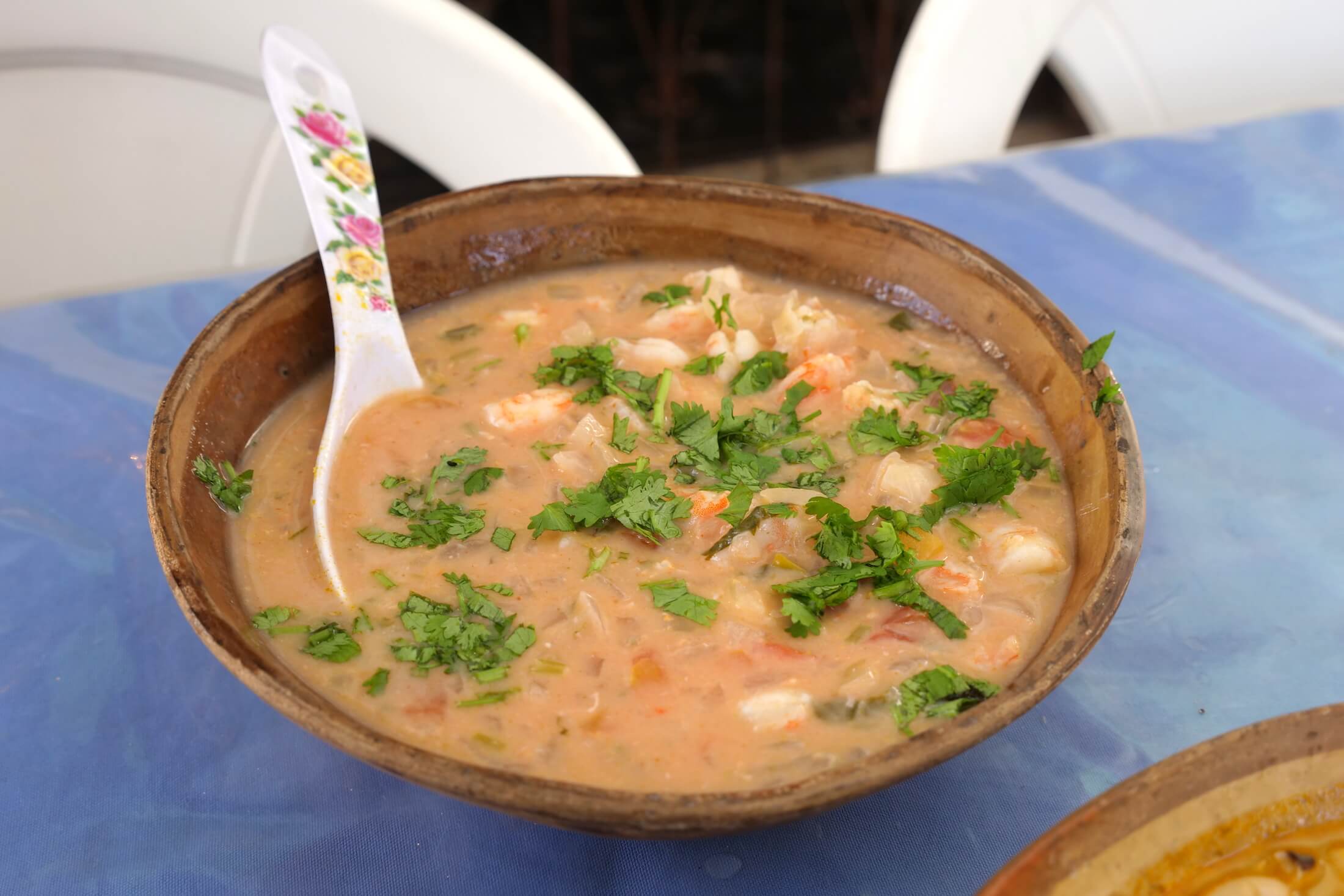
3. Bahian Shrimp Stew (Ensopado de Camarão)
‘ Ensopado ‘ in English translates directly to ‘stew,’ and this shrimp stew is another delicious example of food here in Salvador.
Its mostly sour in flavor, but the consistency is so incredibly creamy. You can have it with plenty of different main ingredients, but at Dona Suzana’s this stew is full of lots of Brazilian seafood.
How To Make Ensopado de Camarão
Starting off with the stew broth, the recipe I had that tasted best was one that was very thick with coconut milk (the chef, Dona Suzana, also uses a lot of both tomatoes, and okra in her recipe, for even more thickness and rich texture).
There are also chunks of onions, carrots, and green pepper, finishing with fresh cilantro on top just before serving.
I love the bright taste of that sour stew with a few shrimp, and all the soft onions. I don’t know if the local recipes prefer lime juice or vinegar, but its wonderfully sour as well as being so rich (and this is such a great combo to have with moqueca, by the way).
Another Bahia favorite is ‘bobo,’ and you could also try to eat this food at the nearby Mercado Modelo (Salvador’s Central Market).
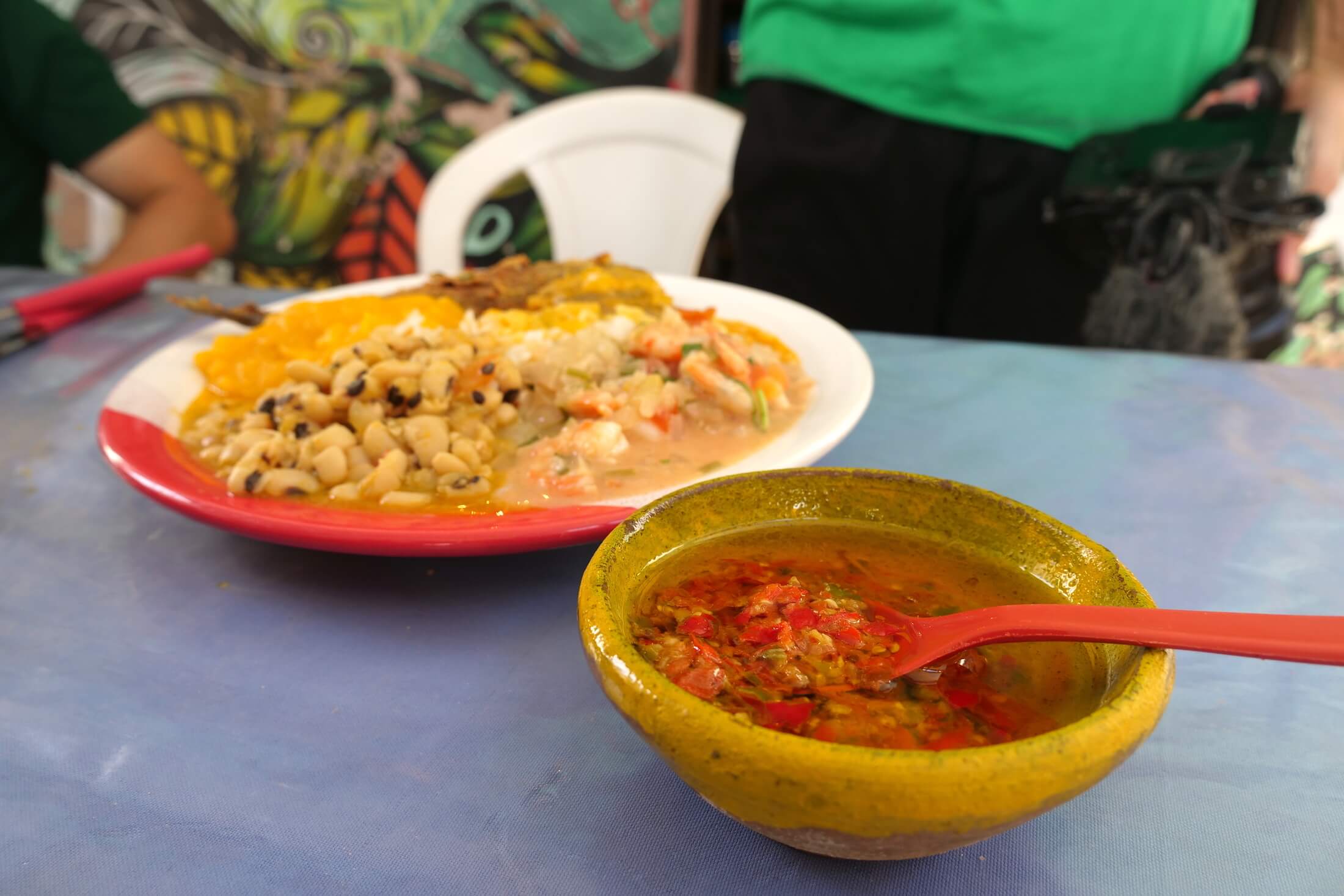
Where Do Brazilians Eat Shrimp Stew?
One of the most stunning locations so far out of all the meals we had in Brazil, Ré Restaurante Doña Suzana has an absolutely perfect place for your late lunch meal today.
So good, I wrote an entire article about it here ( link ).
Name: Ré Restaurante Dona Suzana Location: Google Maps ( link here ) Hours: Open Daily, 12pm to 6pm Price: R$87 for our entire meal for 4 (US$22.41)
How to Eat Ensopado
As you are so near the seashore here, why not go a little crazy for Brazilian seafood. Ensopado is a great way to start, but you should order at least one of each of the popular dishes to go with it.
Try one dish each of shrimp, ocean fish, and manta ray, a great combo of Salvador’s three favorite seafoods. I think this ensopado stew tastes best with shrimp, but of course feel free to find your own favorite combination.
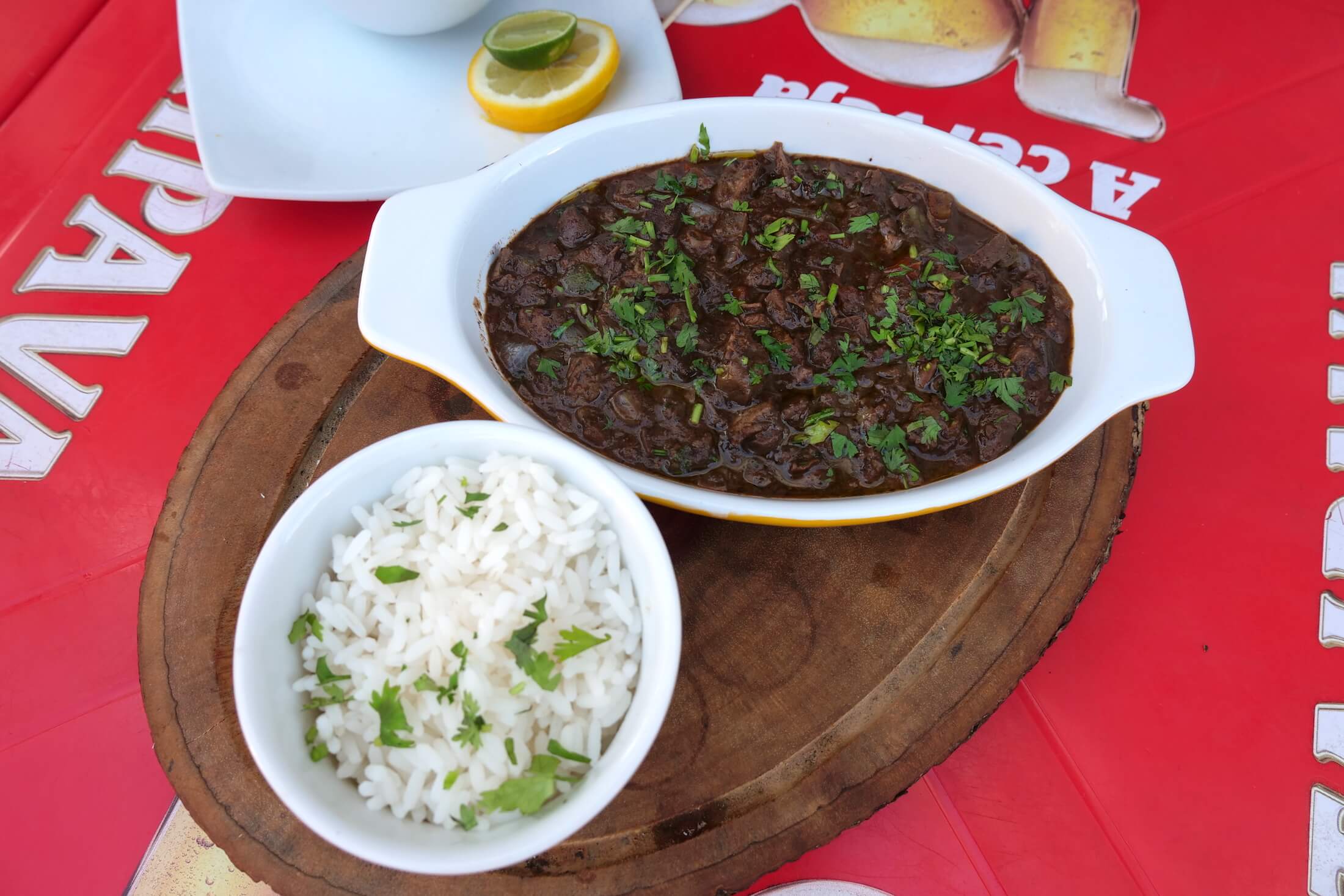
4. Meat and Innards Stew (Sarapatel)
Including just a few vegetables, and a wonderful mix of meaty ingredients, Sarapatel is an amazing local food in Salvador.
People usually eat this food with rice, in the afternoons or evenings. It can be a great food to have in the afternoon, as Sarapatel tastes so great with a nice, cold Brazilian lager beer.
Sarapatel is one of the dishes where you can see very obvious Portuguese influence on the local cuisine of Brazil. Even though its so meaty, it doesn’t necessarily need to be ‘dinner’ on its own (many people will go out for larger meals later in the evening).
Order this with a side of white rice, and squeeze on some juice from a lemon or a lime.
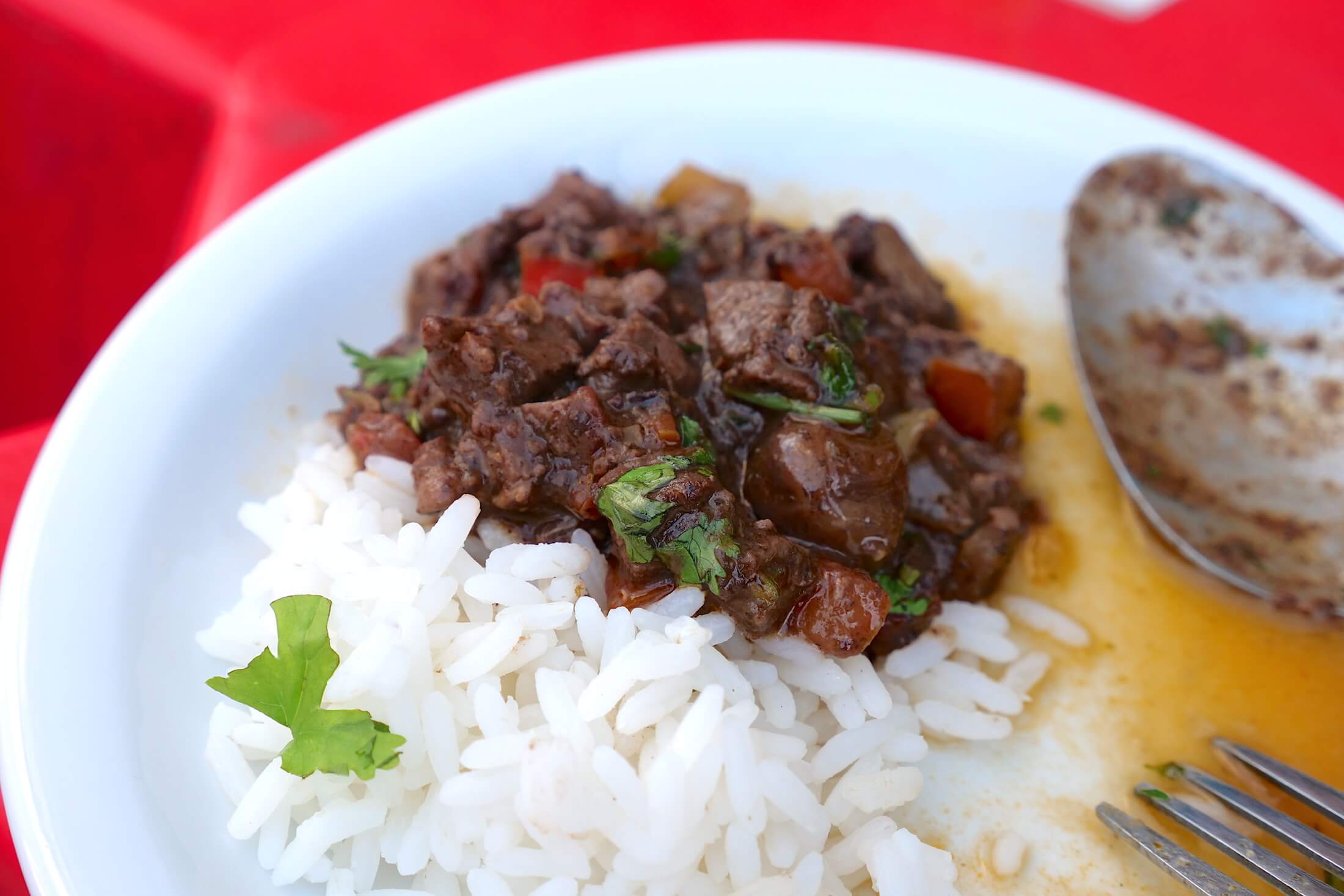
Where To Eat Sarapatel in Salvador?
I think its a great food to have just before dinner, and we had a great version of this food at a local restaurant Boteca di Janela, in Salvador.
She makes it extra rich by including large portions of blood while cooking the soupy liquid, as well as thick chunks of skin and chewy intestines.
(By the way, locals know Boteca di Janela for its great appetizers, and extremely cold beer)*
Name: Boteca di Janela Location: Google Maps ( link here ) Hours: Open 11am-4pm Thurs. and Fri., and 12pm-6pm on Sat. and Sun. Closed Mon. to Wed. Price: R$87 for our entire meal for 4 (US$22.41)
*Back Story – This restaurant just has a very cool small-neighborhood Salvador vibe – if you’re lucky, there might be a local football match happening in the afternoon. The stadium is just around the corner, and you can hear the live cheering, as well as watch it on local TV. Look over the shoulders of excited fans while getting deep into your own afternoon snacks of Salvador’s best local food.
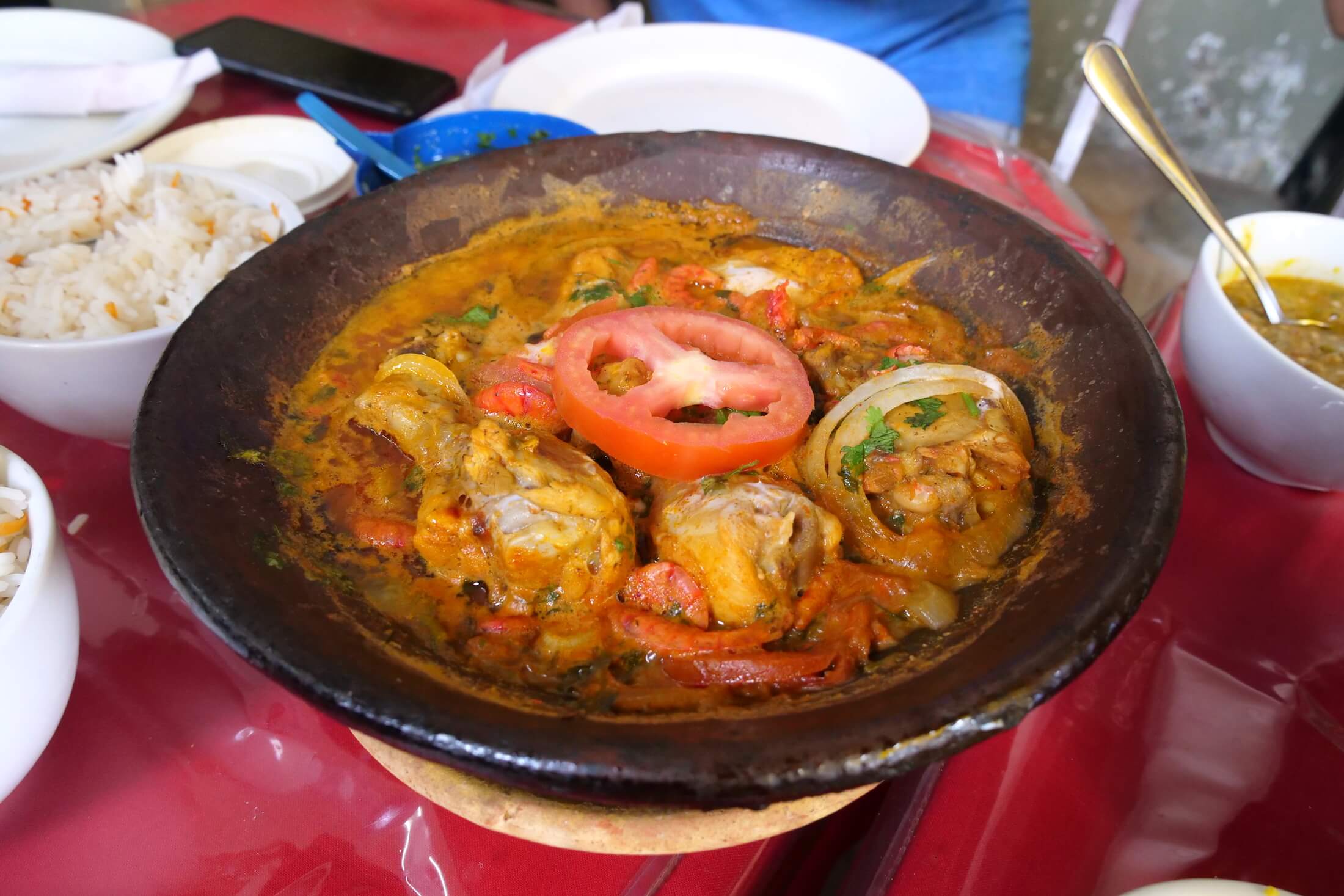
5. Chicken XinXim (Xinxim de Gallina)
One of the most amazing looking foods in all of North Eastern Brazilian is Xinxim de Gallina.
This food is full of dry spices, peanuts and a mash of cashews, and a small amount of green vegetables for flavor while it stews. I can only think of a curry when the massive plate first arrives at the table, but this is not a curry (as there is no curry paste).
Xinxim de Gallina is incredibly creamy, and rich, as the recipe includes palm oil at the beginning. It then gets a second healthy portion of coconut milk, just before it comes to the table.
Gallina is chicken meat, and usually gallina will be an older chicken, with flavor more suited towards soups or stews (like the one you see in the photo above).
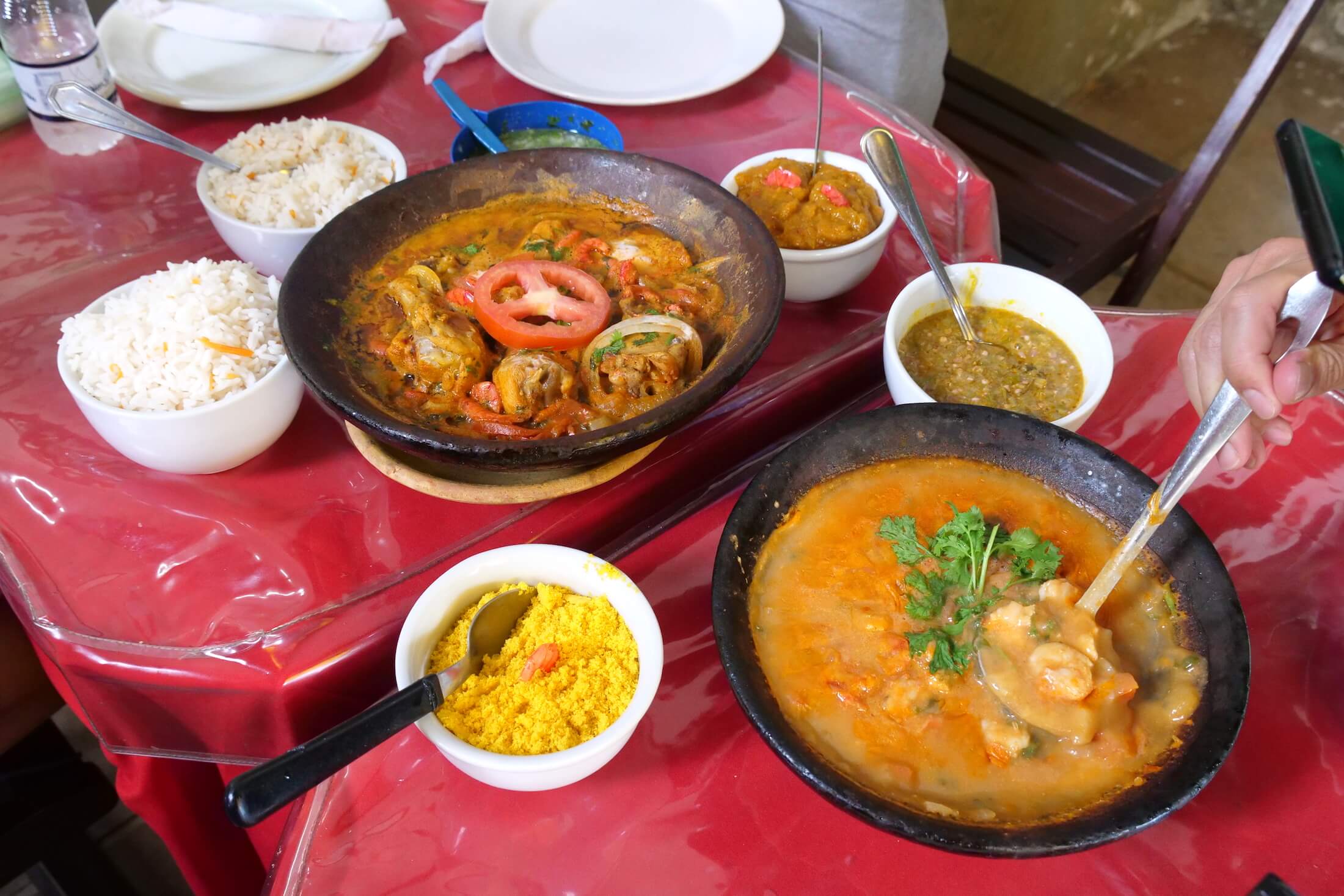
Where Do Locals Eat Xinxim de Gallina?
Name: Jacy Restaurant Location: Google Maps ( link here ) Hours: Open Daily 7am to 4pm, Closed on Sunday Price: R$180 for everything, plus another full Xinxim for take-away
How to Eat This Food
Many people order Xinxim de Gallina as a main dish to share, and during our meal in the Mercado Modelo market we had it like this as well.
Along with an order of ensopada de camarao (Bahian Shrimp Stew, #3 in this Salvador Food List), you might have some delicious pirãu here (a smooth mash of cassava and dendê oil), and a large bowl of caruru (okra paste with a mash of peanuts and cashews).
Note: This market is full of tourists, but if you want a great spot for real and authentic local food of Salvador, then start at the North side of the market. Find the hallway where Jacy is doing the actual cooking (link above), and take a seat at one of the tables immediately beside her stall.
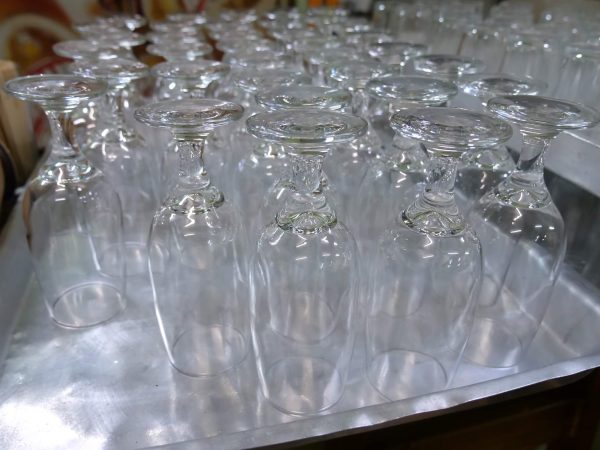
Feijao Tropeiro – Amazing Food in Belo Horizonte, Brazil
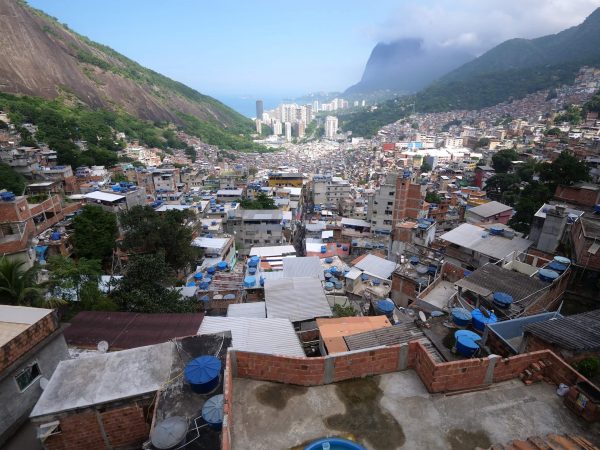
Favela Visit in Rocinha – A Brazilian Sensory Overload of Food, Art, and Reality
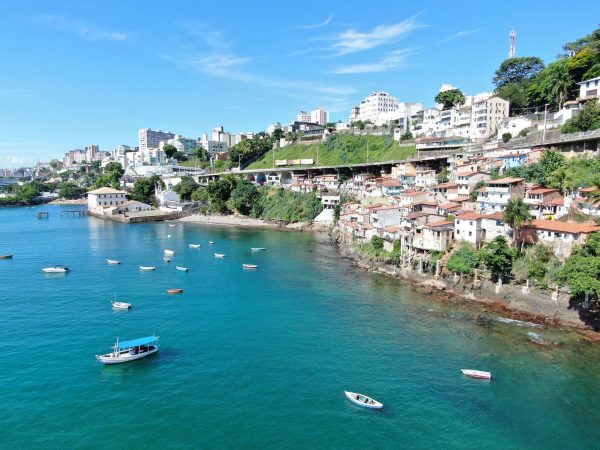
Brazilian Seafood Lunch, with Chef Dona Suzana (Local Hero in Salvador)
Enter your email and I'll send you the best travel food content.
175 comments. I'd love to hear from you!
Leave a reply cancel reply.
Your email address will not be published. Required fields are marked *
Save my name, email, and website in this browser for the next time I comment.
This gown’ dreamy chiffon cape feels ceremonial and refined, and is definitely eliminated to disclose a slinkier metallic sheath underneath for dinner and dancing.
خرید هارد اینترنال
It is a beautiful place
Essayduniya
Nice Recipes thank you so much dude!
boardman-wellness.com
2 years ago
Brazil has the best food.
3 years ago
great article i love to eta
Indysmoke clothing
wow, the food is very delicious, can’t wait for me to taste the food in brazil
Brazil 🇧🇷🇧🇷, is one of the best places to visit if you love food. They have got very nice people.
dapatkan keuntungan berlipat ganda setiap hari dengan bermain di situs resmi WARNETQQ
Couponsavinguae
I loves street food in brazil. Thank you for posting.
credit repair near me
vishal kaushik
All stuff is great. Please keep sharing!!!
starswikifolder
thanks for sharing this
https://173.212.220.119/
https://173.212.220.119/ merupakan situs terbaru untuk deposit via pulsa tanpa potongan dengan syarat withdrawal yang mudah tanpa ada kendala apapun. okezone88 juga terkenal dengan permainan arena betting bola provider sbobet terbaik di indonsia
keyurkumar Valand
Wow this is an amazing post if you are interested in a post like this 10 Most haunted places in Rajasthan with History
Whats Biography
Can you give me Backlinks in this Link Please https://www.whatsbiography.com/2021/03/parth-samthaan-biography.html
fakta bola sepak
https://faktabolasepak.blogspot.com/ its my blog about information soccer, lets come to my blog and read some information about soccer. Im so approval can come to your blog and read some of you article.
dotlocal.org
my favorite websites are migrationology.com and dotlocal.org
cherliekevin
I am Charlie Kevin and I am a fitness trainer. I am currently working with Soma fitness studios. It is an fitness center that aims at helping people achieve good health and wellness. We believe that fitness should be easily reachable to one and all. We here aim at achieving health through natural ways with the use of informative blogs and professional workout regime. Without the right health and fitness, it is not possible to enjoy live our life to the fullest. Choose Soma fitness studios for good health.
Such a Nice content here! Whatever you mention in this particular article that all information are truly useful tenali raman stories
oem company in chennai
Hey, thanks for sharing such a great blog. I really enjoyed while reading it. I’m planning to travel Brazil, once Covid comes to end then definitely I will play to go Brazil and explore it completely
Magtech Group
Wow it looks so good. Brazil is always in my Wishlist because I wanna experience their culture. Definitely once this pandemic is over then definitely I will pack my bags and travel to brazil
I had visited Salvador, Brazil , it was nice! bio for fb
Brilliant post!
4 years ago
Specially, Acarajé is looking so delicious. Looking the photos anyone will want to enjoy it.
The food of Brazil is so much amazing. And the places also do same. Thank you for sharing such amazing food of Brazil.
The Acarajé de Ivone looks delicious!
Vishal Kaushik
Stay ahead and keep writing.
awesome post.
Wow….
Salvador looks so beautiful! Thanks for sharing
bandar togeltogel singapore
Fantastic blog! Do you have any hints for aspiring writers? I’m planning to start my own site soon but I’m a little lost on everything. Would you recommend starting with a free platform like WordPress or go for a paid option? There are so many options out there that I’m completely confused ..
Any tips? Kudos!
Joel Bruner
Hi Ciara, awesome message today! Thanks for reading, thanks for the support. Good luck with your own blog, and yes I can help you with an entire post actually 🙂
https://migrationology.com/how-to-start-a-travel-blog/
Ok, any more specific questions, of course always feel free to ask, and good luck getting start. It is a lot of work, but very worth the time!
The food in Brazil looks amazing too! Thanks for sharing!
I am a great fan of your blog so whenever someone asks me about what to in some country when visiting, I recommend them your blog. It’s just great and very informative.
Chakrr, I cant tell you how much we appreciate that. Thank you! All the best today, cheers!
That’s why this is my favorite website on travel food. Thanks for whatever you post.
Great review. Very beautiful photos. Thanks for sharing.
Very helpful and interesting stuff.
Rodrigo Prado
Are you still here in Salvador?
I was looking for a guide about Thailand and found your blog. I’m planning on spend some months in Thailand next year.
If you sill in Salvador give a call so we can meet up and talk about travels and street food. and I’ll show you the best acarajé in the city.
Rodrigo! Thats awesome, hey thanks so much for reaching out. Unfortunately there are no plans to travel much of anywhere right now, but if you do manage to make it to Thailand, yes please! Let us know! Thanks again for the message, hope all is well today.
Very beautifully written post. Thank you very much. We, readers, love to read articles like this. Please visit us : http://www.datadotlabs.com
Kedar Kalamkar
5 years ago
This food blog has stimulated my tastebuds. I am feeling hungry now. Chicken XinXim is way too tempting
Hi Kedar! Thanks for the comments. Yes, that chicken XinXim is a great food, highly recommend it in North Eastern Brazil!
OMG you made me love Brazil so much as it has also been a Dream Visit for me, thanks for writing this up!
Hi Amogh, thanks for writing! It is worth being called a ‘dream destination’ for sure, I loved our time there.
Great content I have ever seen on this website. Keep it up guys.
Thank you for sharing this article. Keep writing. Thank you so much.
Prashanthi, you’re most welcome!
I love Brazil! Excellent blog guys, keep us updated 🙂
Irwan Sarbini
Great place…Good and informative article, you look smart and hope you get a reward for your kindness
Irwan, thanks for your support! Glad you found it useful. Take care!
Egypt Tours
Is it safe to visit Brazil in December?
Hello to *all of you* at Egypt Tours! Brazil is a wonderful place, but of course as with anywhere in the world, you should always take precautions while traveling. Some places are more dangerous than others, but on the whole, Brazil welcomed us so warmly, and were so friendly, I never felt in danger during our time there (in April 2019). Hope you enjoy the time! Safe travels, all the best 🙂
umzug basel
It’s a very helpful post for me. Thank you very much.
Hello Umzug, very glad you enjoyed it!
Very Helpful Article This would make my trip easier.
Ishan, that is what we hope to achieve, thanks for the comment!
Really nice article, I would love to visit Salvador but it is definitely too far for me.
Hi Lukas – well, I hope you do have the chance someday! Until next time, thanks for the support!
I Just love your blog! Thank you for sharing this great blog. It was interesting to read and learned a lot about the country of Salvador Brazil.
Angie, thank you so much! That is a great comment, thanks for taking the time to write. Cheers!
206.189.144.187
Great article! Thank you so much for sharing and looking forward to learning more from this blog
Thanks a lot Babby, Ill continue to do my best to keep the information relevant! Take care!
Satnam singh
Thanx for giving such a wonderful information about Brazil’s food and historical places to visit. your post about Salvador is wonderful.
Hi Satnam, thats great, thanks so much for the kind words!
Beautiful pics of the culture, dishes and scenic views. I would love to wake up in Salvador and have a cup of Brazilian coffee.
Hey Pathaveram, I think you just made me thirsty for some Brazilian coffee… oh man. Thanks for the comment! Cheers!
I’ve never tried any of these foods and I’m in love!
Hi Lea – I hope you have the chance to try them for yourself someday! Cheers!
Great Itinerary! Thank you for sharing!
Thank you very much Rahul!
Urvee Nandha
Great post guys, that is the grate ideas and topics to share with us. That’s i like it. If you need help with creating your marketplace, please contact us. Prisom Technology team has built multiple successful online marketplace platforms, and we will be happy to assist in building yours.
Thank you Urvee, I will remember that for next time. Til then, thanks for reading!
The Newzbox
Thanks for great information… Love from India
Hi Ajay, Thanks for the message – We’re glad you enjoyed the article! Til next time, cheers!
Brazil has been on my bucket list forever! This has made me want to push it to the top of the list. I mean the acaraje looks amazing. The moqueca reminds me of something I had in Portugal. You can never go wrong with seafood stew!
Joaquin!! Its still waiting for you, man, Brazil is incredible!
wow! great guys keep it up and good article
Thanks for the response, glad you enjoyed the article! Til next time, cheers!
It was one of the best travel blog I had read, Got something different.
Amar, youre most welcome. Have a good one!
Eita saudade da minha Bahia! <3
Weslley, thanks for all the comments! Yes, eu saudade Bahia tambem!
Explore Holiday
Enjoyed reading the article above, really explains everything in detail,the article is very interesting and effective. Thank you and good luck for the upcoming articles
Explore India, thanks for the great support and comments! Cheers.
Cruise Mummy
I’d love to head to Brazil on a cruise one day. It looks like such an interesting place. I love all the bright colours of the food, looks delish! Definitely on my list now!
Hello! Thanks for the message, yes Im sure it would be a great choice, or by yourself as well – missing Brazil often! Take care.
کابینت ممبران
but if you want a great spot for real and authentic local food of Salvador, then start at the North side of the market
That is awesome that you have visited as well! What were your favorite places to visit?
Dipak Sarkar
what a fantastic post! This is so chock full of infomation I can’t wait to dig deep & utilizing the resources you have given me.Your exuberance is refreshing
Dipak, you’re awesome, thanks for reading, and we are happy you enjoyed the article 🙂
Miles A. Carson
Super informative article about Salvador and it’s culture I have ever read. It will be consider as a go to guide for anyone who want to visit Salvador.. Thanks a lot for writing such a masterpiece.
Wow, Miles, that is great man! Thank you so much, hope you have the chance to visit Salvador as well! Cheers
It’s really great. keep it up guys. Rock on…
I must say a delicious blog. Beautiful Pictures of tasty food
Hi Eloise, thanks a lot! We try to keep the photo qualities very high. Thanks for your support!
ZAHOOR KHAN
I love the efforts you have put in this, regards for all the great articles.
Zahoor, thanks a lot. Appreciate your kindness!
Rebeca Duarte
I’m Brazilian and I live in Bahia, I’m glad you made a post showing what’s good in my dear land, you made me go back in time, thank you.
Rebeca, thank you SO much for the nice response. Happy to see this 🙂 you have an amazing home, I would like to return tomorrow!
customer care
Thank you very much (once again) for a beautiful and very informative guide. Never been to this side of our planet, but your post about Salvador fills me with wanderlust. Take care, George. very helpfull artical
George, you are most welcome, glad you found it interesting, hope this can help you if you do ever make it to South America! Cheers
Airport Corner
One of the best places to eat street food. I hope to return there one day.
Totally right Nicolas! I hope the same thing, may we both have our (food) dreams come true 🙂
Remarkable blog!!! Couldn’t be written much better! One of the essential values of travelling is that it breaks the monotony of existence and work. Life, for most people, is a mad rush from one place to another, from one activity to another, trying to gather as much as possible. You are doing a splendid process. Hold it up!!!
Rk Singh, thank you so much! Thanks for the response, glad you enjoyed the article.
Chichawatni News
Beautyfull city in brazil , I wish i could visit in next summer. Very amazing article. You did great job. keep it up.
It is a gorgeous place, glad you enjoyed the article! Til next time, cheers!
villabetting
I’m so starving after i see your images i think brazilian foods are so tasty as it looks.
Citra, thanks for the comments (sorry for making you too hungry!) Cheers!
Salvador has to be one of the places i am planning to visit, i know one day i will be there.. thanks for this piece
Thank you Jhaki, hope you get a chance to visit someday soon! Cheers
Hey Joel. Thank you very much (once again) for a beautiful and very informative guide. Never been to this side of our planet, but your post about Salvador fills me with wanderlust. Take care, George.
Amazing, Brazil is the country where I want to go. Thanks for Sharing.
Ayush, hope you can visit soon, and I hope this can help you plan a great trip! cheers
Hi Joel, Good to see your vacation blog post, actually i visited this blog long time back and today i read this blog article which is really interesting. Keep posting! Thanks 🙂
Hello Priya, wow, thank you for the response! very happy you enjoyed it, yes I really loved Salvador, one of the coolest places of the entire trip. Ok well, see you on the next one, thanks again for the message 🙂
David Gonzales
Salvador looks so vibrant and colourful! Your photos and descriptions of the food have made me so hungry. I’m definitely adding Salvador to my travel wishlist!
Hi Sam! Thats a great choice, whew, Salvador is amazing. Ok, cheers!
Acarajé looks sooo good! Thanks for a great in-depth guide that left me very hungry and with an urge to travel to Salvador!
Kris, you are very welcome. Eat (at least) one for us too please! Take care
Taras Yasinski
I was in Salvador last summer and what can I say. That was one of the best trips in my life! I will never forget those sunny days.
Taras, thank you for writing! Yeah, I cant argue with you calling it ‘the best,’ it really deserves to be praised highly – amazing place Salvador, would love to go back!
Thilan Danushka Dissanayaka
Well written article. Thanks for good job. 🙂
Thank you for writing Thilan, have a great day!
infogameonline
beautyfull city in brazil , very amazing
Salvador has to be one of the coolest places I/we have ever been, that city is truly special! (and delicious 😉 )
Star Wikipedia
very nice article.. keep posting
Hi Star, thank you very much for your support!
Thanks for sharing this article for me and all the beautiful Brazilians
Hi Long Phan, thank you for your comments, and thanks very much for your support! Take care!
hey nice your blog
Most welcome Sudhir!
its look like amazing and great place everyone should visit this place.
Hello Nasir! Thanks for your comments, we’re glad you enjoyed the article!
Bali Itinerary
Salvador Brazil looks amazing and is now getting added to my travel bucket list! My family and I appreciate your fantastic food recommendations, like the ones I posted in my Bali Itinerary, Vietnam Itinerary, and Bangkok Itinerary (and soon to be published, Thailand Itinerary!)
Whitney! Thats an awesome comment, thanks for your support, and for taking the time to get in touch. Bali and Vietnam will be great, Im sure you’ll love Bangkok of course, good luck with the travel planning and thanks again for reaching out! Take care
Boutique hotel Espiritu Santo Vanuatu
Loved this post! Thank you for sharing such a wonderful blog. Enjoyed reading it and got a lot of information about Salvador place.
Hi, you’re very welcome, and thank you very much for your support! Salvador is a truly wonderful place to visit. Cheers!
Rakesh Sinha
it looks like an amazing place would love to visit someday.
Hello Rakesh, yes the beauty was quite overwhelming at times, a truly amazing place 🙂
the photos are so pretty. I wish I can visit there. the food also looks amazing.
Hi Joyce! I hope you have the chance as well! Thanks for the comments.
Salvador looks like an amazing place. I love the classic tiles and retro look of the Lacerda elevator. What a colorful city, from the historical houses to the food. Can’t wait to visit Salvador one day and taste that delicious-looking Moqueca and creamy Xinxim de Gallina for myself. Thanks for this excellent and mouth-watering city guide!
Thanks for sharing. this place is Beautiful Awesome country and great people!
Truly Kavita, you are totally right, and hey thanks for the comment! Have a great day!
Thanks for share this article .it is really Awesome country and great people!
Thank you very much Rekha, take care, and thanks for your continued following of this blog! All the best!
Hi!! Love your post. It’s really amazing & helpful too. I like the way you explained everything, kind of example you used. By sharing this amazing post, you have inspired me alot. Looking forward for going on vacation. Keep sharing 🙂 Thank You & Regards Ankita
Ankita, that is a really great message, thank you so much for taking the time to write. Really happy that you liked it, hope its useful to you as well while you are (possibly?) planning a trip to Brazil for yourself! Ok, all the best, until next time! Cheers!
nice article with good images, thank you for sharing this article………
Hello Subha, you’re very welcome. Have a great day today!
Preeti Gautam
I love travelling and i am very foody too. Nice Blog and very beautiful place.
Hi Preeti, yes this is a great place for both food and travel, thanks for reading, have a great day today!
Rashi Kohli
I have been through the video and would love to say that the street food of Salvador Brazil is mouth watering. However you gave the perfect idea how to cover all the best attraction around Salvador in one day. I am definitely going to share this with my travel mates. Thanks for sharing.
Hey Rashi, good morning! This is a wonderful comment, so glad to be of such help. Thank you for taking the time to write, yes the street food there is definitely mouth-watering, and you’re going to want to pack as much of it into a single day as you can! Every day in Brazil 🙂 Enjoy your time there! Be well.
I’ve been there last year. Awesome country and great people!
Awesome Pablo, so glad you could visit this quite unique and brilliant place 🙂
rakesh chandro
Your day was really nice. Thank for share with us.
Hi Rakesh, thanks for reading!
Frank Parker
Yes! Salvador looks amazing, and the food delicious! Looks like you had a lot of fun. I think Salvador and West African has quite similarities with their food and culture. I hope you have noticed it. Thanks, Mark for introducing us about little geography, food, music, and culture lessons. Of course, Salvador is going to be my new bucket list.
Hello Frank, thanks for the message! I think you are totally right, its those similarities which make Salvador (and a few other places along the coast of Brazil) just so unique and special. You’re making a good move to put Salvador on the top of any list, its a truly special place! Cheers!
Wow.Beautiful place and the Chicken XinXim looking mouth-watering.Thanks for sharing.
Hello Rubina! Thanks for writing, yes that XinXim is just such a great dish – massive, and so tasty! Cheers!
Travelling and Having food of different place Amazing for our body and Taste…
Hello Samresh, thank you for your response, hope you enjoyed the article!
Keiran Potter
I love the way you break down your travel itinerary this way. I’m one of those people that love to know every detail of a place and someone’s travel experiences before travelling there myself. Another place to add to the list, thanks to you guys! Beautiful photography as always.
Wow Brazil!, the one of country that i love to see their football
Haha Isfan, yes they love their football as well… we were more there as fans of the cuisine, but its a great place for sports as well!
Ashley Casey
Great advice! And uber is definitely your best bet. I relied on it on my last month long stay in El Salvador. Cheap, easy and safe!
Hello Ashley, hey thanks for the recommendation. We want to visit Central America soon as well. Thanks for the message, have a great day!
Drooling right now. I love Brazil so much – but haven’t yet made it to Salvador.
- South America
- 10 Things To Know Before...
10 Things to Know Before You Go to Salvador

Salvador is an enchanting colonial city on Brazil’s north-eastern coast. The capital city of Bahia , it offers great nightlife and gorgeous coastal views , but there’s a few tips you should know before you go. Check out Culture Trip’s top things to be aware of before traveling to Salvador.
Stay in pelourinho.
This cobblestone street neighborhood of Pelourinho is the perfect base for discovering Salvador’s historic elements. It offers colonial architecture, fantastic restaurants , hip bars and plenty more to see. Keep it as your base during your stay in Salvador and you won’t regret it.

See a different side of Brazil
The north-east of Brazil and Salvador in particular are home to a higher black population than anywhere else in Brazil, and rivals some places in Africa. This is a deep contrast to other, more European-influenced areas of the country, so take the opportunity to learn about the beautiful Afro-Brazilian culture straight from its roots.

Plan your transit
Salvador does not have a metro system yet and so travelers will need to rely on taxis, ride sharing services, or the bus to get around. It’s a city that is spread out quite a bit geographically so a hop across town may take some time. Plan your day’s events around one or two neighborhoods at a time to minimize time spent on the road.
Plan your airport transfer
There’s nothing worse than flying into a new city and realizing the airport is much, much further away from your destination than you anticipated. The closest airport to the city of Salvador is Salvador-Deputado Luís Eduardo Magalhães International Airport, which is at best 30 minutes by car from the Pelourinho area. However, Salvador sits on a peninsula, so traffic can get congested at times. Be aware and plan your travel time accordingly so you can enjoy more of this amazing city.

Appreciate art
Salvador is a hub of cultural activities, performances and arts. It has deep African roots and proudly channels that heritage through a host of cultural endeavors. Take some time off the beaches and the bars to appreciate the Afro-Brazilian culture in the museums and art galleries in this historic city.
Take a weekend getaway
While Salvador does have it all, it’s nice to see some different beaches , and the city is the perfect gateway to discovering new sands. Head south to Morro de São Paulo and enjoy some time on a car-free island, or keep moving south to Porto Seguro for a whole new party atmosphere.

Visit on a Tuesday
Sure, the weekend festivities in any city are a highlight, but Salvador’s Tuesday samba parties are not to be missed. They begin around 8PM and last well into the night. Expect to leave valuables, jewelry and anything you don’t want to lose back at the hotel. The good thing is this party happens on the streets of Pelourinho in the beautiful historic district and offers an unparalleled opportunity to enjoy Afro-Brazilian and samba beats like a local.
Savor the cuisine
Salvador is well known for its array of restaurants, both elegant and casual, but the best dishes are easily moqueca, a rich fish stew, and acarajé, a fried bean and shrimp street snack. Salvador’s cuisine, including these two dishes, is often made with dende oil, which some travelers find very rich at first. Our advice: take it easy and give your stomach time to adjust to these rich, but delicious foods.

Wander wisely
There are nearly 100 churches in Salvador to explore and some are exquisite examples of colonial architecture. These churches help tell the story of the city, so wander around and visit more than just the most famous ones. However, wander wisely and stick to the Barra, Rio Vermelho and Pelourinho neighborhoods to start — there’s plenty to see in the safest parts of Salvador.
Since you are here, we would like to share our vision for the future of travel - and the direction Culture Trip is moving in.
Culture Trip launched in 2011 with a simple yet passionate mission: to inspire people to go beyond their boundaries and experience what makes a place, its people and its culture special and meaningful — and this is still in our DNA today. We are proud that, for more than a decade, millions like you have trusted our award-winning recommendations by people who deeply understand what makes certain places and communities so special.
Increasingly we believe the world needs more meaningful, real-life connections between curious travellers keen to explore the world in a more responsible way. That is why we have intensively curated a collection of premium small-group trips as an invitation to meet and connect with new, like-minded people for once-in-a-lifetime experiences in three categories: Culture Trips, Rail Trips and Private Trips. Our Trips are suitable for both solo travelers, couples and friends who want to explore the world together.
Culture Trips are deeply immersive 5 to 16 days itineraries, that combine authentic local experiences, exciting activities and 4-5* accommodation to look forward to at the end of each day. Our Rail Trips are our most planet-friendly itineraries that invite you to take the scenic route, relax whilst getting under the skin of a destination. Our Private Trips are fully tailored itineraries, curated by our Travel Experts specifically for you, your friends or your family.
We know that many of you worry about the environmental impact of travel and are looking for ways of expanding horizons in ways that do minimal harm - and may even bring benefits. We are committed to go as far as possible in curating our trips with care for the planet. That is why all of our trips are flightless in destination, fully carbon offset - and we have ambitious plans to be net zero in the very near future.

See & Do
Everything you need to know about rio’s pedra do telégrafo.

Places to Stay
The best campsites and cabins to book in brazil.

Guides & Tips
The best private trips to book for reunions.

The Most Beautiful Coastal Cities to Visit With Culture Trip

The Most Beautiful Sunsets on Earth

The Best Destinations for Travellers Who Love to Dance

The Best Resorts in Brazil

The Best Hotels to Book in Brazil for Every Traveler

The Most Beautiful Botanical Gardens in the World

The Best Private Trips to Book for Your Dance Class

Food & Drink
The best brazilian desserts you need to try.

The Best Villas to Rent for Your Vacation in Brazil
Culture trip spring sale, save up to $1,100 on our unique small-group trips limited spots..

- Post ID: 1150117
- Sponsored? No
- View Payload
UK Edition Change
- UK Politics
- News Videos
- Paris 2024 Olympics
- Rugby Union
- Sport Videos
- John Rentoul
- Mary Dejevsky
- Andrew Grice
- Sean O’Grady
- Photography
- Theatre & Dance
- Culture Videos
- Fitness & Wellbeing
- Food & Drink
- Health & Families
- Royal Family
- Electric Vehicles
- Car Insurance Deals
- Lifestyle Videos
- UK Hotel Reviews
- News & Advice
- Simon Calder
- Australia & New Zealand
- South America
- C. America & Caribbean
- Middle East
- Politics Explained
- News Analysis
- Today’s Edition
- Home & Garden
- Broadband deals
- Fashion & Beauty
- Travel & Outdoors
- Sports & Fitness
- Sustainable Living
- Climate Videos
- Solar Panels
- Behind The Headlines
- On The Ground
- Decomplicated
- You Ask The Questions
- Binge Watch
- Travel Smart
- Watch on your TV
- Crosswords & Puzzles
- Most Commented
- Newsletters
- Ask Me Anything
- Virtual Events
- Betting Sites
- Online Casinos
- Wine Offers
Thank you for registering
Please refresh the page or navigate to another page on the site to be automatically logged in Please refresh your browser to be logged in
The Independent's journalism is supported by our readers. When you purchase through links on our site, we may earn commission.
Salvador city guide: How to spend a weekend in Brazil's musical and cultural epicentre
With beautiful beaches, bahian beats and a strong african influence, salvador is brazil’s coastal gem. here's what to do in 48 hours , article bookmarked.
Find your bookmarks in your Independent Premium section, under my profile
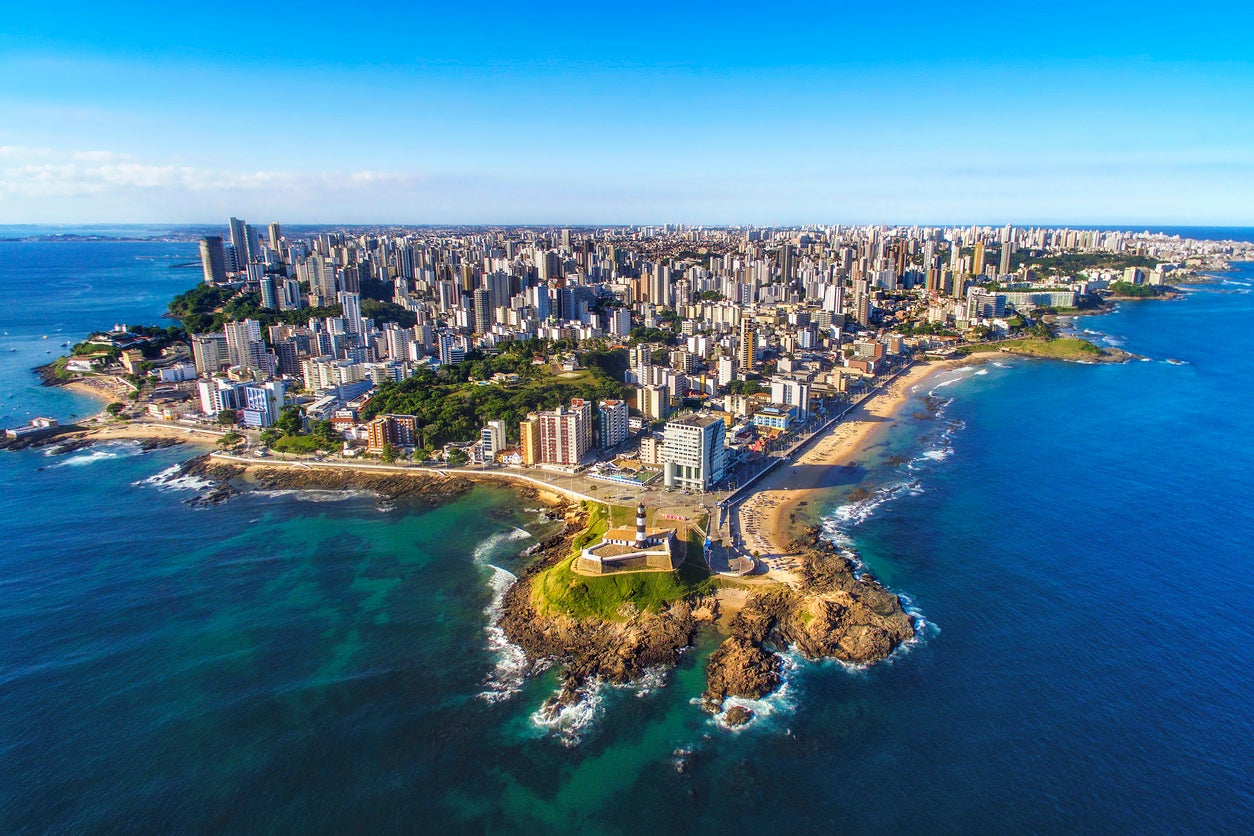
Sign up to Simon Calder’s free travel email for expert advice and money-saving discounts
Get simon calder’s travel email, thanks for signing up to the simon calder’s travel email, why go now.
While Carnival might be over in Brazil for another year, Salvador is the country’s musical and cultural centre; it’s where Brazilians come to party all year round. Jazz, African beats and the local axe music (which mixes samba with reggae) drift among the cobbled streets and tiny beach bars in Brazil’s most African city.
Get your bearings
Brazil’s third biggest city, Salvador in Bahia is more a collection of tiny seaside towns and villages that string along both sides of a peninsula, which separates the Bay of All Saints from the Atlantic Ocean. Each praia or beach has its own feel, from the fishing spots and famous sands of Barra in the south to the less touristy Bomfim in the north-west. Salvador was one of the first colonial cities in the Americas and one of Portugal’s biggest slave trade centres; the city is still infused with African culture. Pelourinho, or the Old Town, sits high above the rest of the city on the west side and is the biggest draw for tourists. Find Tourist Information in Pelourinho on Rua das Laranjeiras (1).
Take a view
On the west side of the city, Salvador is split into two levels, with the Old Town or Pelourinho sitting 100m above the marina. Take Brazil’s first lift, the Elevador Lacerda, up to the top to Ladeira da Praça (2), one of the Old Town’s many colonial squares. The neo-classical Palácio Rio Branco (3) (History Museum) sits to one side and the views out to sea are dazzling.
Take a hike
Pelourinho is Salvador’s cobbled colonial highlight. The Portuguese used African slaves to build enormous cathedrals, churches and mansions. Over the centuries African culture has mixed with Bahian to create a multi-faceted religious and cultural life that’s unique to Bahia. Walk down Praca de Se (4) to discover a modern sculpture of a fallen cross in a tiny square overlooking the ocean. Keep going and you’ll come into a large square where tracksuited groups practise capoeira and tourists stop for ice cream in the shade of the historic pastel-coloured buildings.
Head down one of the prettiest streets in Salvador, Cruzeiro de São Francisco (5), to the enormous Sao Francisco cathedral (6) at the end. Inside this lavishly decorated 18th-century church you’ll find an entire room carved from wood and coated in gold. It took African slaves 27 years to finish it. There’s also a traditional courtyard tiled with Lisbon’s famous azulejos, the blue and white tiles. The streets around here echo with drumming groups and musicians; Salvador is arguably Brazil’s beating cultural heart and free performances seem to bubble up out of nothing.
Lunch on the run
Only a few hundred metres away from the church is one of Pelourinho’s most famous spots, the Largo do Pelourinho (7), with its beautiful cobbled street dropping away down a steep hill. At the top you’ll find Teatro SENAC (8) ( sescbahia.com.br ), Salvador’s hospitality and culinary school’s buffet restaurant housed within an 18th-century mansion. Stop for hearty Bahian classics like moqueca (fish stew with coconut), which all come with or without the locals’ favourite, palm oil. You can also pick up a traditional cookbook from the shop below.
Window shopping
Mercado Modelo (9) sits on the seafront under the shadow of Pelourinho, up on the hill. Wander down the cobbled streets after lunch to this famous arts and crafts market found in a pastel yellow colonial warehouse. It’s open from 9am-7pm every day except Sundays when it shuts at 2pm. Pick up leather bags, lace and trinkets galore.
An aperitif
Hidden away on the top level of the Mercado Modelo is a bar with a large terrace that overlooks the Atlantic. It’s sufficiently badly signed to keep most tourists away and you can order rounds of Caipirinhas to toast the sunset for a few reals.
Dine with the locals
Amado (10) ( amadobahia.com.br ) is one of Salvador’s most modern restaurants. Sat on the shoreside, a short taxi ride from the Mercado Modelo, it has a romantic outside terrace that overlooks the Bahia marina. A fine dining menu offers up fabulous steaks and modern Brazilian starters (it closes early on a Sunday at 5pm).
Parasaoi Tropical (11) ( restauranteparaisotropical.com.br ) is an award-winning organic restaurant in a rustic looking house in Cabula that makes the most of Brazil’s bounty of nuts, fruits and fish. Get a garden table and try the traditional dessert, maturi pie – made with green cashew nuts, coconut and blackberries. It’s open from Tuesday to Saturday from midday to 10pm; on Sundays it closes at 5pm.
Out to brunch
Take in the Atlantic views from the roof of Fera Palace (12) ( ferapalacehotel.com.br ), an Art Deco hotel that opened in the 1930s and has recently been restored. It’s only a few minutes from Rua Chile – the historical centre’s main drag. The rooftop lounge is open from 10am every day.
A walk in the park
As Salvador is surrounded by sea, take a walk along the pretty promenade around Praia do Porto da Barra beach (13) – a white crescent of sand that’s safe for swimming. Hawkers sell everything from hats to ice cream and the beach is always packed with Bahians getting their daily dose of sun. You can go on from here further down the coast to the tip to discover the city’s famous lighthouse (14), which was built in 1501 ( museunauticodabahia.org.br ). It’s now a maritime museum that traces Portugal’s history in Brazil. Open every day except Tuesday, 9am-6pm.
Take a ride
Salvador’s bus system is busy but there are plenty of them and it’s a flat fee of $R3 (75p). You will need cash and some Portuguese as English isn’t widely spoken. Take the 0711 Campo Grande bus from Rua Marques de Caravelas (15) (a few minutes’ walk from the lighthouse) to Rua Da Graca (16) which is next to the Palacete das Artas.
Cultural afternoon
Start at Palacete das Artas (17) ( facebook.com/PalaceteDasArtes ), a small but lovely art museum installed in a 1912 mansion with a garden full of Rodin sculptures. It also has a modern space for contemporary art and a café that’s good for a pit-stop. Open from 2-7pm (weekends 1-7pm), closed on Mondays. From here you can stroll to the Solar Unhão (18) ( jamnomam.com.br ) or Museum of Modern Art down on All Saints Beach. This former sugar mill is open from 1-6pm every day except Mondays. It’s a perfect spot to stop and take in the sunset afterwards. The accompanying Sculpture Park clings to the cliffside as the Atlantic laps below.
The icing on the cake
You can’t go anywhere around Salvador without ending up on a stunning beach. Around an hour north of the city is Praia do Forte (19) which is home to Brazil’s biggest sea turtle conservation project. From September to March there are full moon tours where you can see turtles hatching on the beach.
Travel essentials
Cheapest time to fly
Getting there
TAP Portugal ( flytap.com ) flies from Gatwick to Salvador airport (20) via Lisbon. Bespoke Brazil ( bespokebrazil.com ) can arrange city and regional tours and airport pick-ups. Get into the city via a metered taxi or take a bus to Pelourinho which takes around an hour and costs R$3.00 (75p).
Staying there
Find the grand colonial Villa Bahia (21) (lavillabahia.com) right in the midst of the Old Town. There are only 17 rooms grouped around a quiet garden courtyard, with a plunge pool and wonderful terrace. Doubles from R$674 (£172), B&B.
Check availability
Fiesta Bahia Hotel (22) (fiestahotel.com.br) is a mid-range hotel near the city’s new business district. It’s a high rise built a couple of decades ago with a decent pool, free wi-fi and friendly staff. Doubles from R$582 (£147), B&B.
Laranjeiras Hostel (23) (laranjeirashostel.com.br) is a bright and breezy budget way to stay. It’s part cafe, part traveller hotspot with dorms and private rooms available. You’re slap bang in the Old Town and it’s a good place to connect with Salvador’s more alternative side. Private doubles from R$70 (£18), room only.
Join our commenting forum
Join thought-provoking conversations, follow other Independent readers and see their replies
Subscribe to Independent Premium to bookmark this article
Want to bookmark your favourite articles and stories to read or reference later? Start your Independent Premium subscription today.
New to The Independent?
Or if you would prefer:
Want an ad-free experience?
Hi {{indy.fullName}}
- My Independent Premium
- Account details
- Help centre
Fully customizable Argentina trips ideas
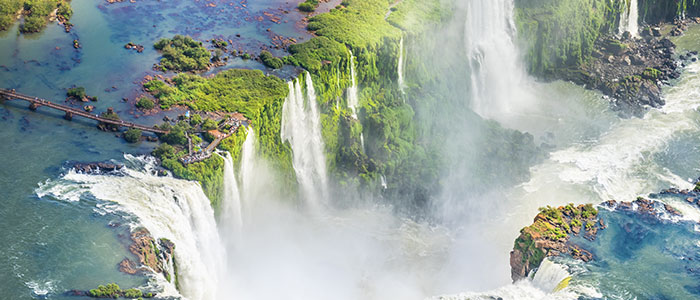
Tango & Falls 6 Days Buenos Aires, Puerto Iguazú
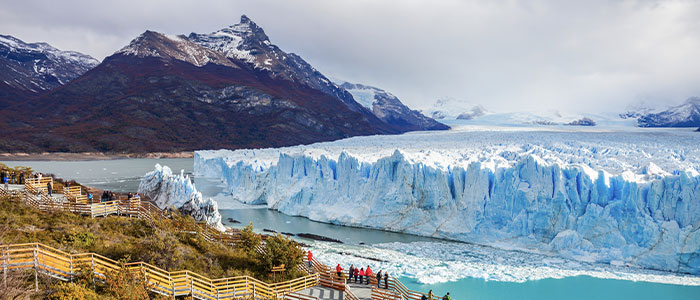
Argentine Treasures 7 Days Buenos Aires, Puerto Iguazú, El Calafate
Argentina destinations
Fully customizable brazil trips ideas.
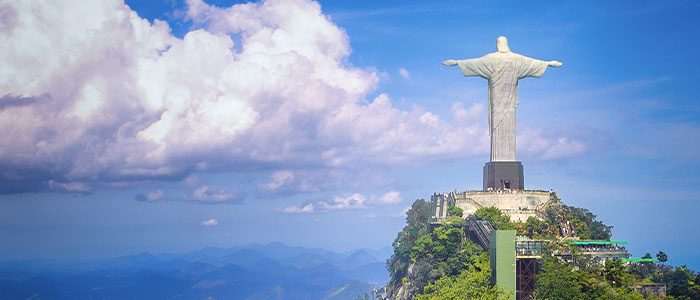
Samba & Falls 6 Days Rio de janeiro & Iguazu Falls
Samba, Falls & Tango 7 Days Rio de Janeiro, Puerto Uguazu, Buenos Aires
Brazil destinations
Fully customizable chile trips ideas.
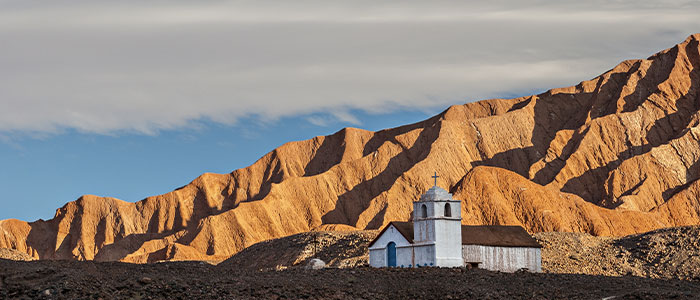
Urban Discovery & Natural Wonders 7 Days Santiago and San Pedro de Atacama
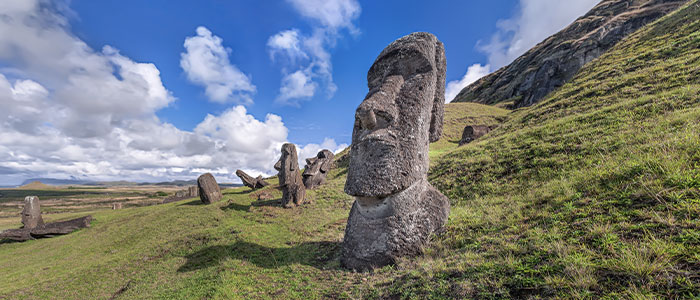
Enchanted Easter Island & Santiago 7 Days Santiago and Easter Island
Chile destinations
Fully customizable ecuador trips ideas.
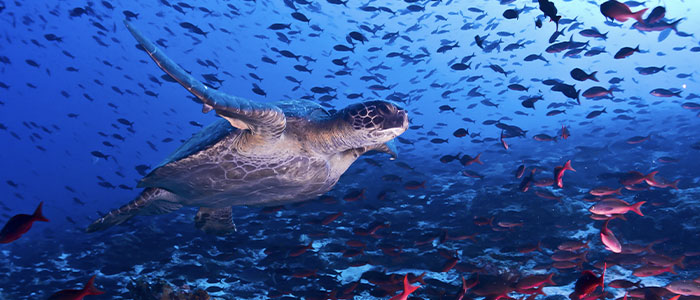
Inspiring Incas & Great Galapagos 11 Days Machu Piccu, Cusco, Sacred Valley, Galapagos Cruise
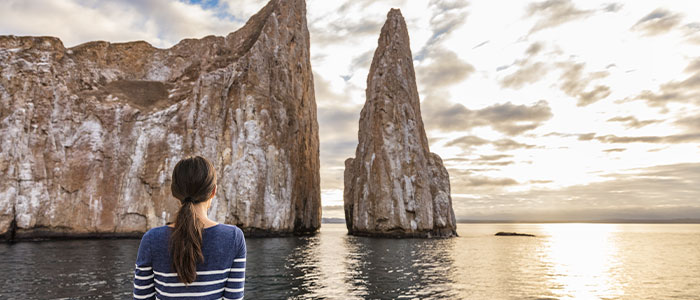
Galapagos Island Hopping Tour 6 Days Galapagos Islands
Ecuador destinations
Fully customizable patagonia trips ideas.

Capitals & Patagonia 12 Days Santiago, Torres del Paine, El Calafate & Buenos Aires
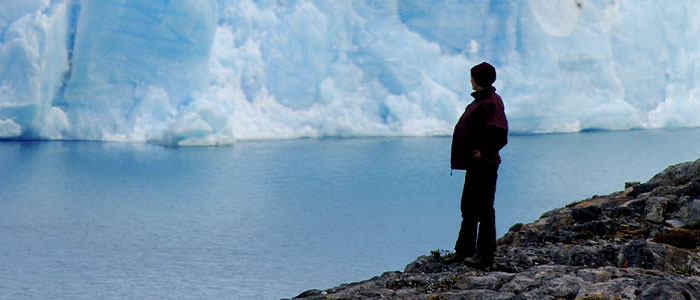
Best of Patagonia 10 Days El Calafate, El Chalten, Puerto Natales, Torres Del Paine
Fully customizable Antarctica trips ideas

Highlights of Antarctica 8 Days Cruise Antarctica

Crossing the Circle 15 Days Cruise to Cruise to the Antarctic Peninsula
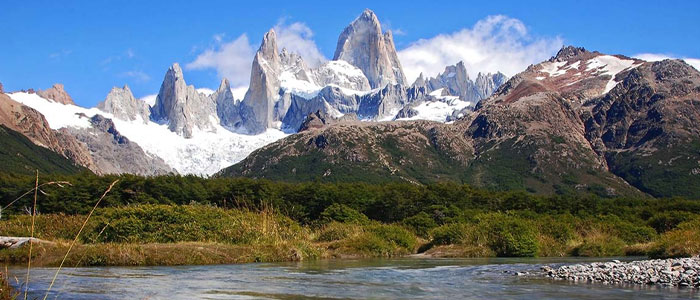
The Best Time to Visit Patagonia in Chile and Argentina
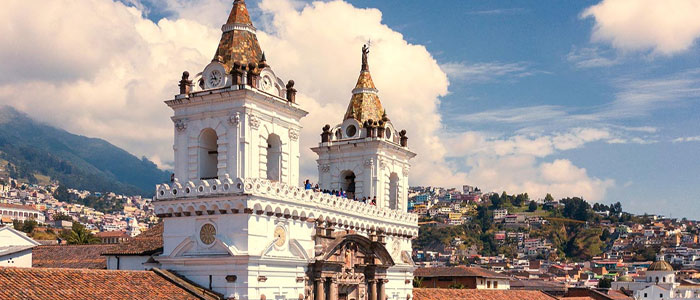
The 20 Best Places to Visit in Ecuador
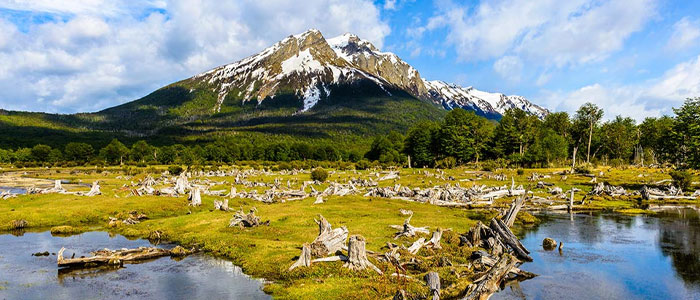
Tierra del Fuego National Park Travel Guide
Testimonials
More than 5,000 GREAT testimonials
Who we are, and why we love travel
Personalized Service
Handpicked hotels, 5000+ testimonials.
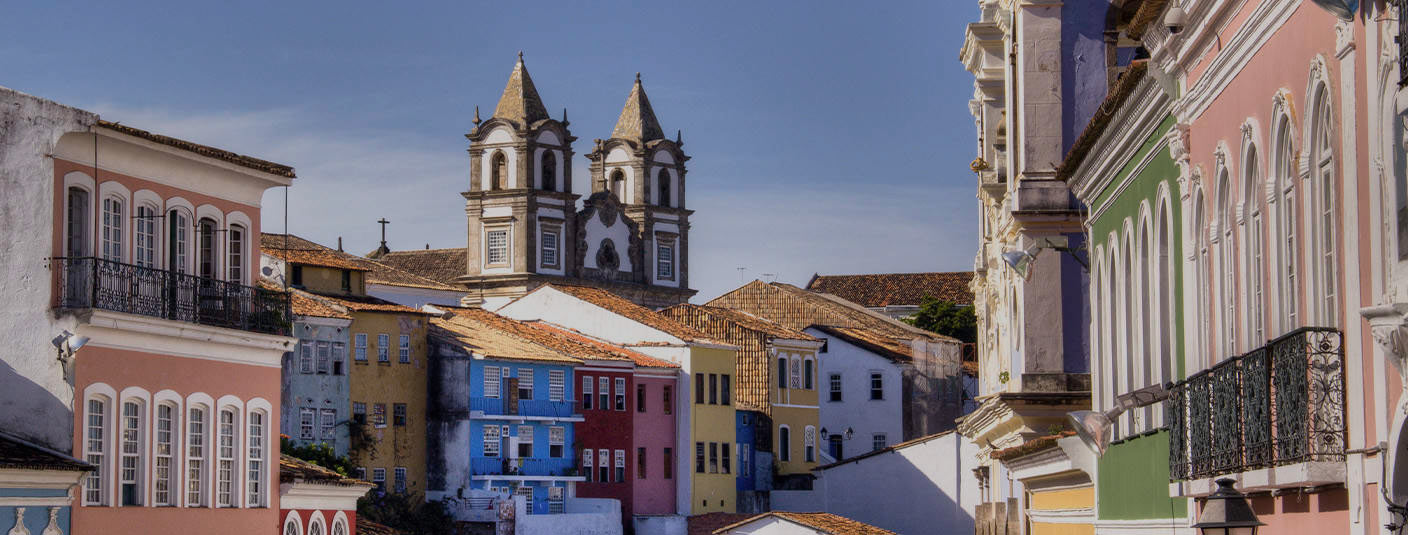
Salvador da Bahia Tours
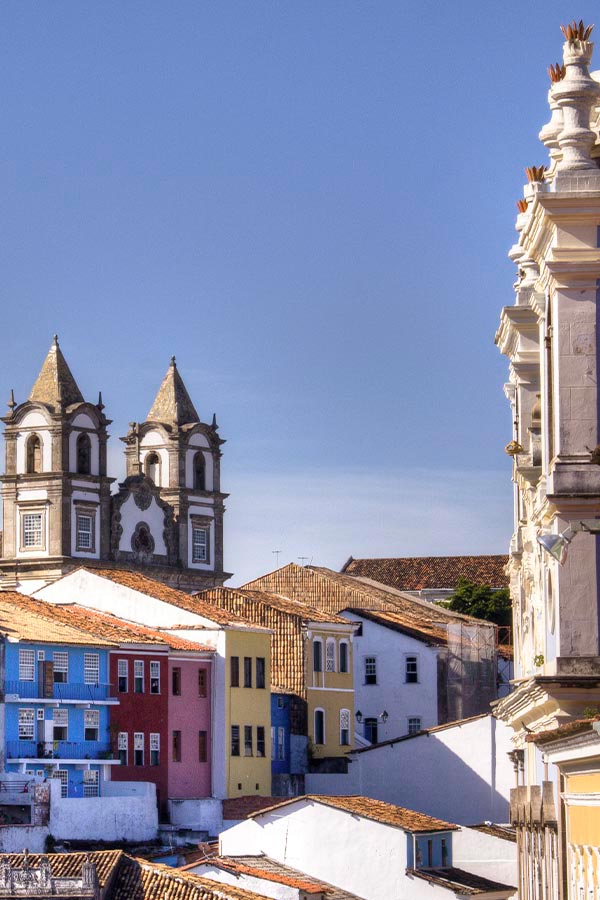
Tailor-made Itineraries by Local Experts
Discover Brazil’s “Land of Happiness” with our private and small group Salvador Bahia tours. The friendly and welcoming residents of Salvador da Bahia –known simply as ‘Salvador’ – are deservingly proud of their northeast capital city, blessed as it is with a historically-rich past, gorgeous beaches, and one of the best Carnival celebrations in the world. Salvador is also considered the Afro-Brazilian capital of the nation and with over 80% of the population claiming African ancestry it is no surprise how extensively African culture and traditions have integrated into local folklore and history. Contact us to start planning your trip to this historically and culturally rich Brazil destination.
Join small or private group tours.
Great hotels with superior attention.
Founded in 1998, look at our amazing testimonials.
Fully Customizable Tours
Let our team of expert travel advisors help build your dream trip to South America. Our fully customizable vacation packages allow you to hand-pick the destinations you wish to see at the exact pace you wish to see them. All of our offerings are also vetted firsthand by our team to ensure top quality and comfort. Contact one of our travel experts today to start planning your once-in-a-lifetime trip!
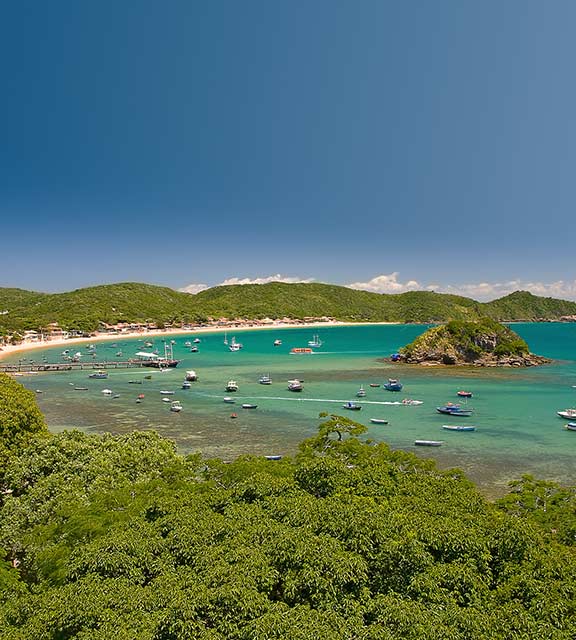
Discover Brazil
Rio de Janeiro, Buzios, Iguazu Falls, Salvador de Bahia & the Amazon 16 Days $ xxx -->
An expansive discovery of the Brazilian Amazon, the tropical coast, waterfalls, and historic relics.
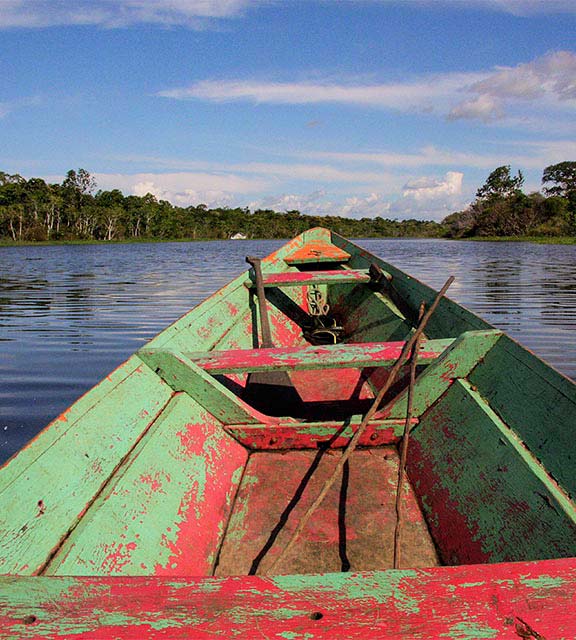
Rio, Capoeira & Amazon
Rio de Janeiro, Salvador da Bahia, Manaus 10 Days $ xxx -->
Discover the rich cultures of Rio and Salvador before an adventure to the Amazon with this exciting package.
What to Do in Salvador da Bahia
Explore one of Brazil’s most historically and culturally rich cities. Your Latin America For Less travel advisor can help you create the perfect itinerary tailored to your interests and preferences.
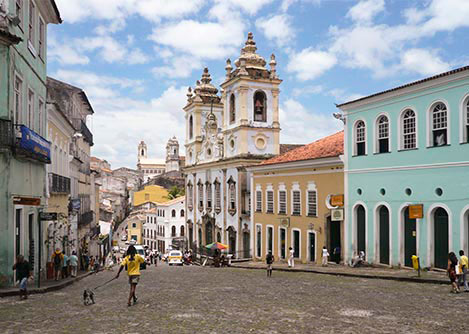
Explore the Historic Center
The historic center of Salvador is full of well-preserved colonial buildings dating back as far as the 17th century, which has earned it a designation as a UNESCO World Heritage site.
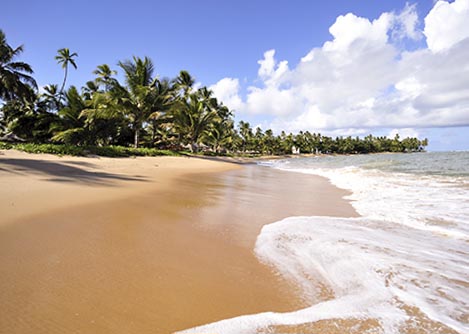
Visit the Beaches
Salvador offers some of the best beaches in the country, perfect for swimming, sailing, and snorkeling. With over 30 miles (50 km) of beaches stretching across the coastline, there are plenty of options to take in a little sun in this lovely city.
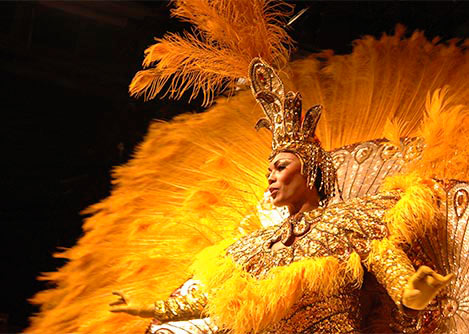
See Live Samba Music
Make sure to enjoy a night of live Samba music at one of the city’s various live music venues specializing in Brazil’s most famed genre of music. Salvador is one of the best places to see live Samba music in Brazil.
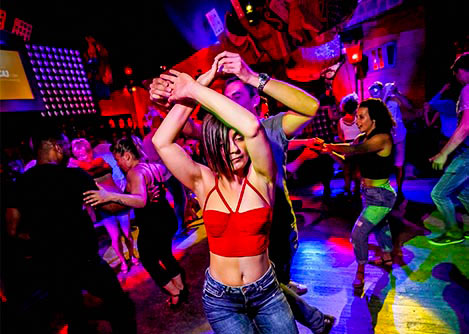
Enjoy the Nightlife
After nightfall, be sure to check out Salvador’s thriving music-scene at one of the city’s hip clubs where you can dance along to samba and Brazilian-inspired funk.
Customize Your Trip
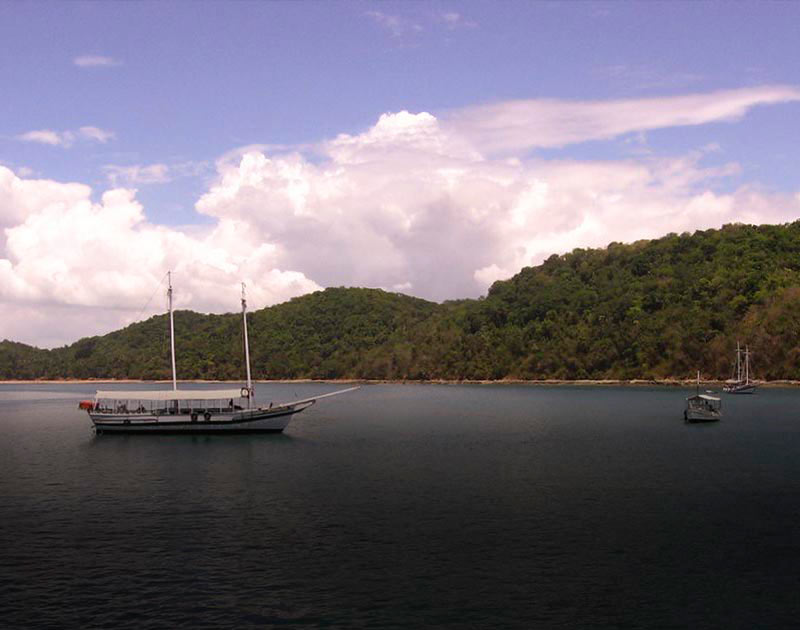
Adventure Tours
Ask your Latin America For Less travel advisor about how you can add some extra adventure to your personalized itinerary. Get your adrenaline pumping with hikes and multi-day treks, jungle expeditions, white water rafting trips, mountain biking tours and more. We are experts in planning personalized travel experiences in Latin America, so talk to one of our advisors today to start planning your adventure.
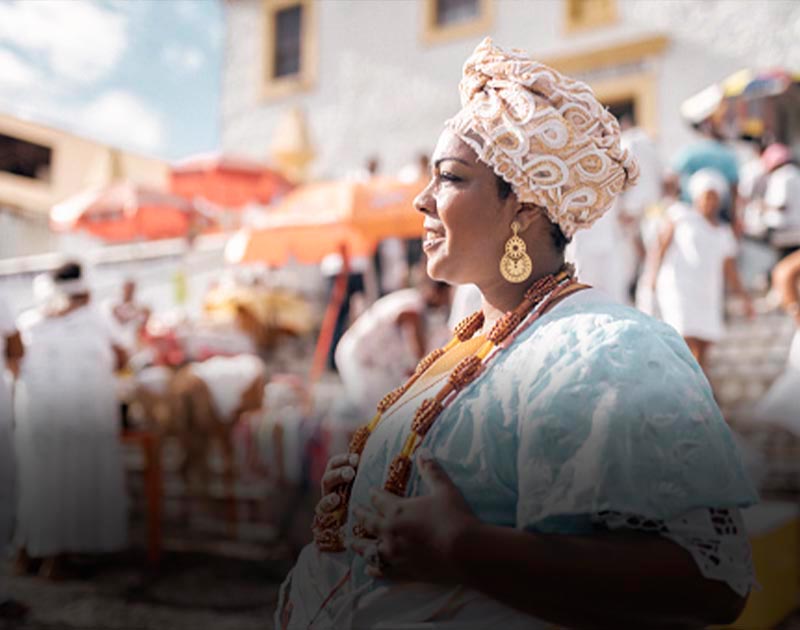
Cultural Tours
Ask your Latin America For Less travel advisor about adding cultural tours and experiences to your personalized itinerary. Discover the rich cultures of Latin America and learn about the unique customs and traditions maintained by its people. We are experts in planning personalized travel experiences in Latin America, so talk to one of our advisors today to start planning your cultural tour.
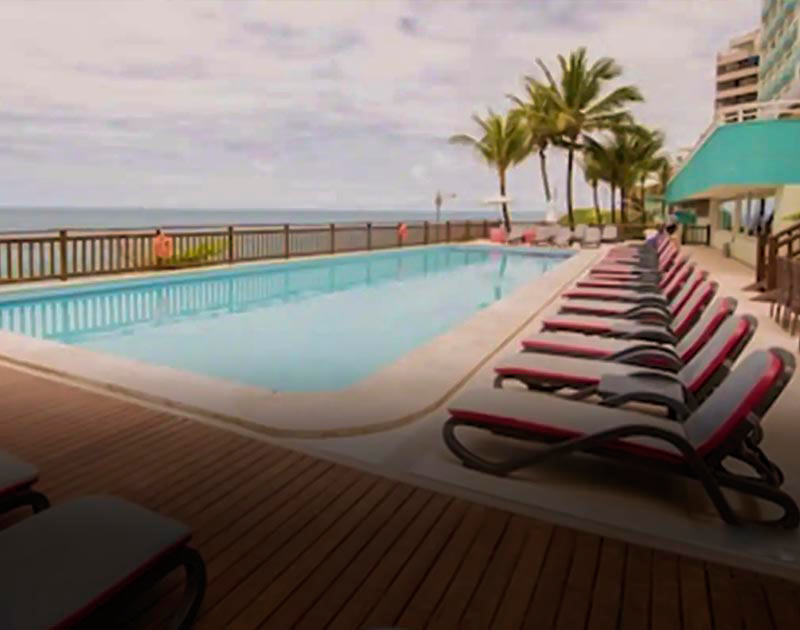
Spa & Wellness Tours
Ask your Latin America For Less travel advisor about how you can add spa & wellness tours to your personalized itinerary. Take advantage of a free day to enjoy some rest and relaxation at a resort, or visit a spa to unwind after a long day of exploring. We are experts in planning personalized travel experiences in Latin America, so talk to one of our advisors to start planning your spa & wellness tour.

Ask your Latin America For Less travel advisor about how you can add food tours and culinary experiences to your personalized itinerary. Discover the unique cuisines of Latin America and enjoy exclusive visits to some of the world’s top restaurants. We are experts in planning personalized travel experiences in Latin America, so talk to one of our travel advisors today to start planning your food tour.
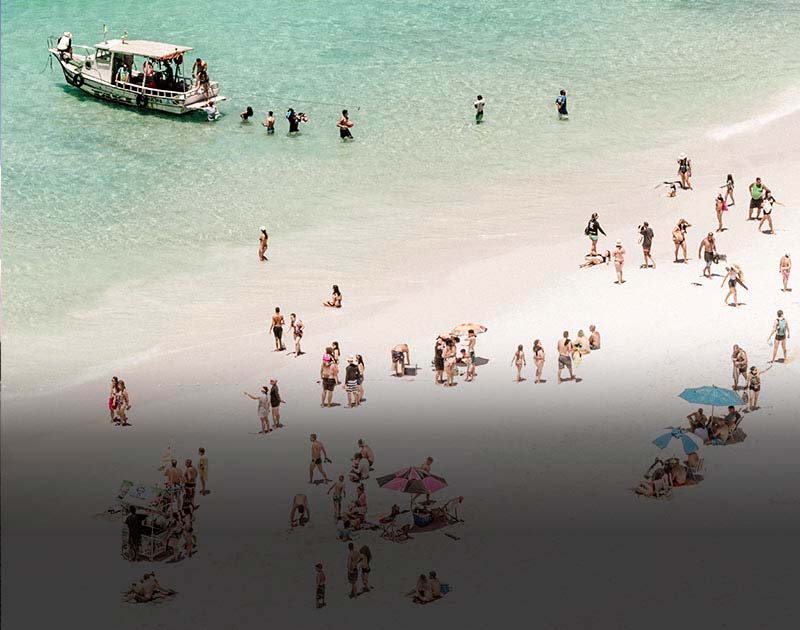
Family & Friend Tours
Ask your Latin America For Less travel advisor about how you can add family-friendly tours to your itinerary. Our team can help you build the perfect trip for your family, whether your group has small children, teenagers, senior citizens, or all of the above. We are experts in planning personalized travel experiences in Latin America, so talk to one of our travel advisors today to start planning your family tour.
Explore Brazil
With stunning beaches, lush tropical forests, fascinating history and unique culture, Brazil offers many attractive destinations for travelers. Discover some of the best places to visit in Brazil below.
Rio de Janeiro
Also known as “The Marvelous City,” Rio de Janeiro brims with color, sound, rhythm, and joy. This sparkling city boasts one of the most naturally spectacular settings.
Read more →
As Brazil’s largest city, São Paulo’s attraction lies in its diverse people and its vibrant culture. Senses are overwhelmed by the sheer size and cosmopolitan feel of the city.
Bonito is an eco-tourism Mecca blessed with caves, waterfalls, and crystal-clear rivers. It’s a haven for nature and adventure lovers with great snorkeling opportunities.
Sitting at the end of a long sandy peninsula, Rio’s most exclusive beach resort of Buzios offers surfing, snorkeling, windsurfing, diving, or just simple relaxation.
Florianopolis
Florianopolis, capital of Santa Catarina State, is a beautiful and bustling island city, and one of the few places in the world where antiquity and modernity unite in perfect harmony.
Iguazu Falls
The name Iguazu comes from the Guarani phrase for “big waters,” although this can only begin to describe the majesty and magnificence of these gigantic waterfalls.
Lying on the Negro River a short distance upstream from the mighty Amazon, Manaus is a former rubber-boom port that is today the main jumping-off point for excursions into the Amazon.
An 18th century gold-mining center, Ouro Preto is bursting with striking Baroque architecture and sacred art. It is the colonial jewel in the crown of Minas Gerais state.
Among the best places in South America to see wildlife, Pantanal is a vast natural ecological paradise where you’re almost certain to see jaguars, caimans, anacondas, exotic birds, and more.
Home to some of the world’s most spectacular Portuguese colonial architecture, Paraty is set on a shoreline of jutting peninsulas and secluded beaches.
Praia do Forte
Praia do Forte is a charming coastal town blessed with beautiful white sandy beaches, clear blue waters and tropical reefs. It’s a great place for turtle-watching from December to March.
Recife boasts dazzling stretches of white sandy beaches, while the nearby UNESCO World Heritage Site of Olinda is simply the largest and most beautiful site of colonial architecture in Brazil.
Salvador da Bahia Hotels
Discover the best places to stay in Salvador da Bahia with our top pick Salvador da Bahia hotels.
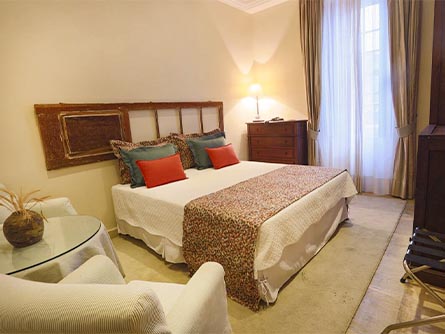
A Casa das Portas Velhas Sur
Rua da Palma 6, Salvador
A Casa das Portas Velhas features doors collected from the ruins of a 19th century manor which was restored to house this charming boutique hotel. Antique pieces adorn the walls and mirrors, and also serve as actual doors within the hotel, creating an atmosphere of classical antiquity and romanticism.
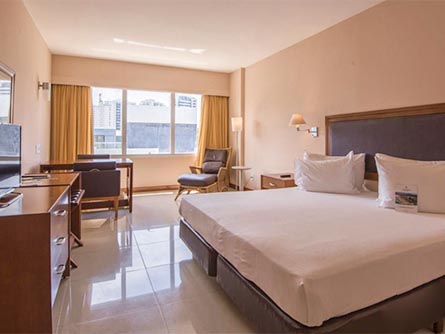
Vila Gale Bahia
Rua Morro Escravo Miguel 320, Ondina, Salvador
Vila Gale Bahia Hotel is located in the center of Ondina and within walking distance of shops and restaurants. The 200 rooms (including 24 suites) all have air-conditioning and en-suite bathrooms. With direct access to the beach, the hotel offers scenic views and a cozy atmosphere.
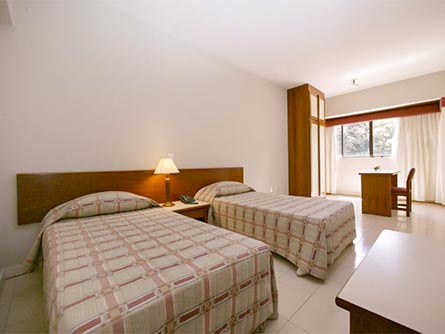
Porto Farol Apart Hotel
Rua Engenheiro Milton De Oliveira 134, Barra, Salvador
Located in one of the most charming and famous neighborhoods in the city next to the beaches of Porto and Barra, the Porto Farol Apart Hotel combines excellent services and ideal location. This lovely hotel features 39 apartments all equipped with their own kitchen and comfortable furniture.
Our trip was incredibly successful in three different countries: Chile, Brazil and Peru. And in every instance, the coordination of details and execution were impeccably accurate regardless of the country visited.
Colorado, USA
The Argentina and Brazil trip organized for us by Brazil for Less was great. The timing and amount of time for each place was very balanced and we were able to see a lot of things in a short amount of time.
We would like to thank you and your team for a most enjoyable vacation. Considering the many countries (Peru, Chile, Argentina, and Brazil) we visited, and the 14 flights we took, all went well. I will certainly recommend Brazil For Less to those who would like a stress free holiday in South America.
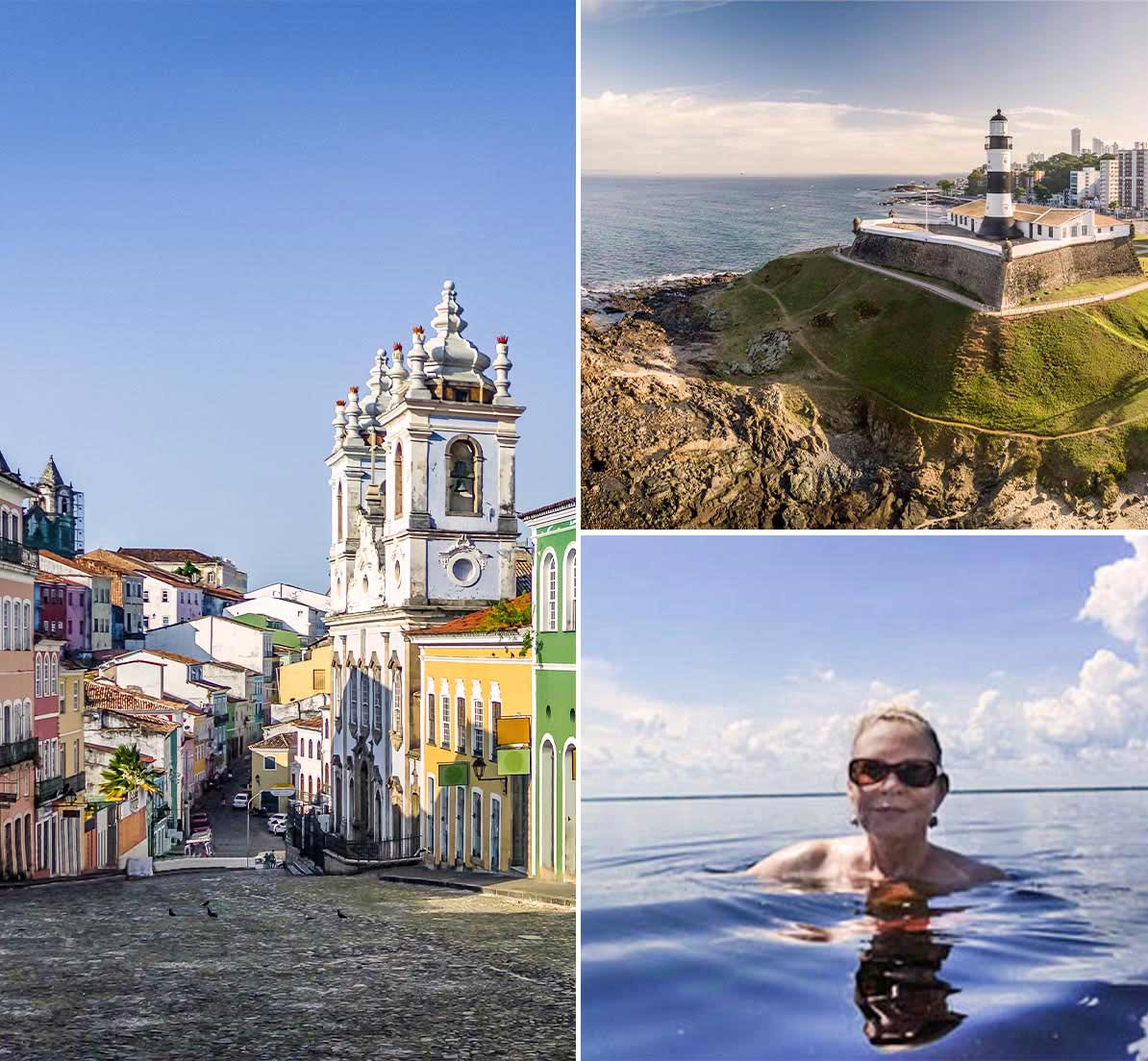
What are Machu Picchu’s operating hours?
Machu Picchu is open from 6:00 a.m.–5:30 p.m. every day including weekends and holidays.
Which Machu Picchu tour is best for adrenaline seekers?
The Machu Picchu ruins have two on-site hikes: Huayna Picchu Mountain and Machu Picchu Mountain. Both can be combined with a Machu Picchu tour and take 2–3 and 4–5 hours to complete, respectively. For even more adventure, you can hike over multiple days to Machu Picchu via the Inca Trail, Lares or Salkantay treks.
Where should I stay if I spend multiple days at Machu Picchu?
Machu Picchu hotel and hostel options are plentiful in Aguas Calientes, the town at the base of the Machu Picchu ruins. Our Top Pick hotels here are:
- 5-Star Inkaterra Machu Picchu Pueblo Hotel
- 4-Star El Mapi
- 3-Star Casa Andina Standard Machu Picchu
- 2-Star Waman Hotel
How many days do I need to tour Machu Picchu?
1–2 days. Two days and one night is the best amount of time to tour Machu Picchu at a leisurely pace: one day to arrive by train and another for the tour and return to Cusco. A whirlwind one-day Machu Picchu tour from Cusco is possible but it will be a long 16–17 hour day.
How long is a guided tour of Machu Picchu?
A guided tour of Machu Picchu is 2 hours long. The ruins operate on a one way circuit that leads to the exit of the ruins and re-entry is not allowed with a Machu Picchu general entrance ticket.
What will I see on a Machu Picchu tour?
A tour of Machu Picchu includes stops at the Guardhouse, agricultural zone, main gate, fountains, tower, temple zone, Temple of the Three Windows, astronomical observatory, Sacred Rock, Group of Three Doorways, royal enclosures, Temple of the Condor and storage area. You will also have views of the west agricultural zone and main square while walking through the ruins.
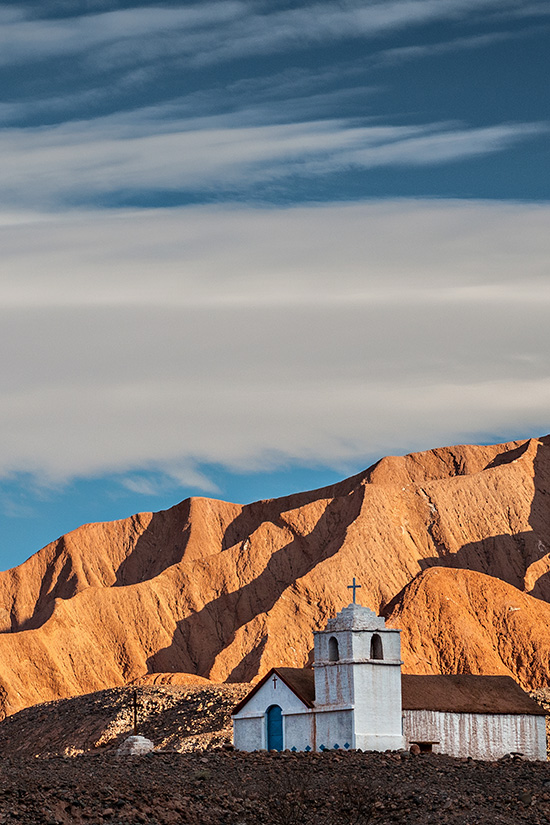
Not quite sure? Explore all our best selling packages
See All Packages
Book with confidence
We're flexible! Postpone your tour with zero cost up to 10 days prior to departure
(Optional. You may choose more than one)
TIP: Tell us the destinations you have in mind.
By submitting this form, you agree to receive recurring customer care text messages from Peru for Less at the number used when signing up. Msg frequency varies. Msg and data rates may apply. View Terms & Privacy .
We sell virtually all services available in Peru, Galapagos, Brazil, Argentina, Chile and Bolivia
The Best Time to Visit Salvador, Brazil for Weather, Safety, & Tourism
The best times to visit Salvador for ideal weather are
July 16th to September 16th
based on average temperature and humidity from NOAA (the National Oceanic and Atmospheric Administration). Read below for more weather and travel details.
Salvador Travel Guide
Temperature.
- Perceived Temperature
- Rain and snow
- Humidity and wind
- The busiest and least popular months
- Overall travel experience by time of year
Other Salvador Travel Info
Weather in salvador.
Average temperatures in Salvador vary very little. Considering humidity, temperatures feel hot for most of the year with a very low chance of rain throughout the year. The area is less temperate than some — in the 35th percentile for pleasant weather — compared to tourist destinations worldwide. Weeks with ideal weather are listed above . If you’re looking for the very warmest time to visit Salvador, the hottest months are March, February, and then January. See average monthly temperatures below. The warmest time of year is generally early March where highs are regularly around 87.1°F (30.6°C) with temperatures rarely dropping below 76.9°F (24.9°C) at night.
Salvador Temperatures (Fahrenheit)
Salvador temperatures (celsius), “feels-like” temperatures.
The way we experience weather isn’t all about temperature. Higher temperatures affect us much more at higher humidity, and colder temperatures feel piercing with high winds. Our perceived temperatures factor in humidity and wind chill to better represent how hot or cold the day feels to a person.
Salvador Perceived Temperature (F)
Salvador perceived temperature (c), average salvador temperatures by month.
Daily highs (averaged for the month) usually give the best indication of the weather. A significantly lower mean and low generally just means it gets colder at night.
Show Fahrenheit
Show celsius, precipitation (rain or snow).
If dry weather is what you’re after, the months with the lowest chance of significant precipitation in Salvador are January, March, and then December. Note that we define “significant precipitation” as .1 inches or more in this section. The lowest chance of rain or snow occurs around mid January. For example, on the week of January 15th there are no days of precipitation on average. By contrast, it’s most likely to rain or snow in mid August with an average of 2 days of significant precipitation the week of August 13th.
Chance of Precipitation
The graph below shows the % chance of rainy and snowy days in Salvador.
Snow on the Ground
The graph below shows the average snow on the ground in Salvador (in).
Average Rain and Snow by Month
Show inches, show centimeters, humidity and wind.
Salvador has some very humid months, and above average humidity throughout the year. The least humid month is August (68.8% relative humidity), and the most humid month is November (73%).
Wind in Salvador is usually moderate . The windiest month is October, followed by November and December. October’s average wind speed of around 9.4 knots (10.8 MPH or 17.4 KPH) is considered “a gentle breeze.” Maximum sustained winds (the highest speed for the day lasting more than a few moments) are at their highest in mid November where average top sustained speeds reach 15.7 knots, which is considered a moderate breeze.
Relative Humidity (%)
The graph below shows the average % humidity by month in Salvador.
The graph below shows wind speed (max and average) in knots.
Average Wind Speeds
Show wind speeds.
All wind speeds are in knots. 1 knot = 1.15 MPH or 1.85 KPH.
Show Relative Humidity by Month
Is it safe to travel to salvador.
Our best data indicates this area is somewhat safe. As of Dec 04, 2023 there are travel warnings for Brazil; exercise a high degree of caution. Check this page for any recent changes or regions to avoid: Travel Advice and Advisories . This advisory was last updated on Nov 24, 2023.
The Busiest and Least Crowded Months
The busiest month for tourism in Salvador, Brazil is January, followed by June and February. Prices for hotels and flights will be most expensive during these months, though you can save if you purchase well in advance. Tourists are unlikely to visit Salvador in December. Those willing to visit at these times will likely find it the least expensive month.
Estimated Tourism by Month
Most popular months to visit, overall salvador travel experience by season, fall (march through may).
Humidity and temperatures combine to make this season feel warm. Highs range from 87.1°F (30.6°C) and 83.2°F (28.4°C) with colder temperatures in the later months. Rain is rare with 1 to 4 days of significant precipitation per month. Fall is the second busiest for tourism, which makes it a good time for those looking for things to do.
Winter (June through August)
The middle-year months have very comfortable weather with high temperatures that are comfortable. These months see the most precipitation with 3 to 4 days of precipitation per month. June – August is fairly slow season for tourism in Salvador, so lodging and other accommodations may cost slightly less.
Spring (September through November)
Spring daily highs range from 85.1°F (29.5°C) and 81.3°F (27.4°C), which will feel very nice given the humidity and wind. It rains or snows a normal amount: approximately 1 days per month. Tourism is the slowest during these months due to the weather, so hotels may be affordably priced.
Summer (December through February)
Weather is perfect this time of year in Salvador to be enjoyable for warm weather travelers. The average high during this season is between 86.7°F (30.4°C) and 84.9°F (29.4°C). On average, it rains or snows a smalll amount: 1 to 2 times per month. These times of year are the busiest with tourists.
Best Times to Travel › Brazil › Salvador, Brazil
Similar Destinations
- Pelourinho, Brazil
- Santo Antonio, Brazil
- Ondina, Brazil
- Barra, Brazil
- Rio Vermelho, Brazil
- Caminho das Arvores, Brazil
- Amaralina, Brazil
- Pituba, Brazil
- Stiep, Brazil
- Armacao, Brazil
Popular Destinations
- Lisbon, Portugal
- Venice, Italy
- Gyeongju, South Korea
Update May 10, 2024
Information for u.s. citizens in the middle east.
- Travel Advisories |
- Contact Us |
- MyTravelGov |
Find U.S. Embassies & Consulates
Travel.state.gov, congressional liaison, special issuance agency, u.s. passports, international travel, intercountry adoption, international parental child abduction, records and authentications, popular links, travel advisories, mytravelgov, stay connected, legal resources, legal information, info for u.s. law enforcement, replace or certify documents.
Before You Go
Learn About Your Destination
While Abroad
Emergencies
Share this page:
Travel Advisory October 19, 2023
Brazil - level 2: exercise increased caution.
Reissued with updates to Country Summary.
Exercise increased caution in Brazil due to crime . Some areas have increased risk. Read the entire Travel Advisory.
Do not travel to:
- Any areas within 150 km/100 miles of Brazil’s land borders with Venezuela, Colombia, Peru, Bolivia, Guyana, Suriname, French Guiana, and Paraguay due to crime . (Note: This does not apply to the Foz do Iguacu National Park or Pantanal National Park.)
- Informal housing developments (commonly referred to in Brazil as favelas, vilas, comunidades, and/or conglomerados) at any time of day due to crime (see additional information below).
- Brasilia’s administrative regions (commonly known as “satellite cities”) of Ceilandia, Santa Maria, Sao Sebastiao, and Paranoa during non-daylight hours due to crime (see additional information below).
Country Summary: Violent crime, such as murder, armed robbery, and carjacking, is common in urban areas, day and night. Gang activity and organized crime is widespread. Assaults, including with sedatives and drugs placed in drinks, are common. U.S. government personnel are discouraged from using municipal buses in all parts of Brazil due to an elevated risk of robbery and assault at any time of day, and especially at night.
If you decide to travel to Brazil:
- Be aware of your surroundings.
- Do not physically resist any robbery attempt.
- Do not accept food or drinks from strangers.
- Use caution when walking or driving at night.
- Avoid going to bars or nightclubs alone.
- Avoid walking on beaches after dark.
- Do not display signs of wealth, such as wearing expensive watches or jewelry.
- Be extra vigilant when visiting banks or ATMs.
- Use caution at, or going to, major transportation centers or on public transportation, especially at night. Passengers face an elevated risk of robbery or assault using public, municipal bus transportation throughout Brazil.
- Use increased caution when hiking in isolated areas.
- Enroll in the Smart Traveler Enrollment Program (STEP) to receive Alerts and make it easier to locate you in an emergency.
- Follow the Department of State on Facebook and Twitter .
- Review the Country Security Report for Brazil.
- Prepare a contingency plan for emergency situations. Review the Traveler’s Checklist .
- Visit the CDC page for the latest Travel Health Information related to your travel.
International Borders – Level 4: Do Not Travel
U.S. government personnel are not permitted to travel to areas within 150 km/100 miles of the international land borders with Venezuela, Colombia, Peru, Bolivia, Guyana, Suriname, French Guiana, and Paraguay without advance approval from security officials due to crime. Travel to the Foz do Iguacu National Park and Pantanal National Park is permitted.
Visit our website for Travel to High-Risk Areas .
Informal Housing Developments (commonly known as “Favelas”) – Level 4: Do Not Travel
Do not travel to informal housing developments (commonly referred to in Brazil as favelas, vilas, comunidades, and/or conglomerados), even on a guided tour. Neither the tour companies nor the police can guarantee your safety when entering these communities. Even in these communities that the police or local governments deem safe, the situation can change quickly and without notice. While some informal housing developments have clear boundaries or gates, or even names such as “favela”, “vila”, “comunidade”, or “conglomerado”, other such developments may be less obvious, and may be identified by crowded quarters, poorer conditions, and/or irregular construction. In addition, exercise caution in areas surrounding these communities, as occasionally, inter-gang fighting and confrontations with police move beyond the confines of these communities. Except under limited circumstances and with advance approval, U.S. government personnel are not permitted to enter any informal housing developments in Brazil. Read the Safety and Security Section on the country information page and consult the maps on the Embassy’s website for further information regarding favelas.
Visit our website for Travel High-Risk Areas .
Brasilia’s Administrative Regions (commonly known as “Satellite Cities”) – Level 4: Do Not Travel
Without advance approval from security officials, U.S. government personnel are not permitted to travel to Brasilia’s Administrative Regions of Ceilandia, Santa Maria, Sao Sebastiao, and Paranoa between the hours of 6:00 p.m. and 6:00 a.m. (non-daylight hours) due to crime.
Embassy Messages
View Alerts and Messages Archive
Quick Facts
Must be valid on the date of entry
One page required for entry stamp
Yes, beginning April 10, 2025
None required, but see Health section
More than 10,000 BR must be declared to Customs
Embassies and Consulates
U.S. Embassy Brasilia SES 801- Avenida das Nacoes, Lote 03 70403-900 - Brasilia, DF Brazil Telephone: 011-55-61-3312-7000 Emergency After-Hours Telephone: 011-55-61-3312-7400 Fax: (61) 3312-7651 Email: [email protected]
Embassy Branch Office in Belo Horizonte Avenida do Contorno, 4520 / 2nd floor – Funcionários 30110-028 Belo Horizonte, MG – Brazil Telephone: +55 (31) 3338-4000 E-mail: [email protected] Emergency After-Hours Telephone: Please contact the U.S. Embassy in Brasilia
Consular Agency in Brasilia’s Consular District Manaus Consular Agency Edificio Atrium, Suite 306 Rua Franco de Sá, 310 69.079-210 Manaus, AM Brazil Telephone: 011-55-92-3611-3333 Emergency After-Hours Telephone: Please contact the U.S. Embassy in Brasilia
U.S. Consulate General Porto Alegre Avenida Assis Brasil, 1889 Passo d' Areia 91010-004 - Porto Alegre, RS Brazil Telephone: 011-55-51-3345-6000 Email: [email protected]
U.S. Consulate General Recife Rua Goncalves Maia, 163, Boa Vista 50070-125 - Recife, PE Brazil Telephone: 011-55-81-3416-3050 or 011-55-81-3416-3080 Emergency After-Hours Telephone: 011-55-81-3416-3060 or 011-55-81-9916-9470 Email: [email protected]
Consular Agency in Recife’s Consular District U.S. Consular Agency Fortaleza Avenida Santos Dumont 2828, Aldeota, Suite 708 60150-162- Fortaleza, CE Brazil Telephone: 011-55-85-3223-4902 Emergency After-Hours Telephone: Please contact the U.S. Consulate General in Recife
U.S. Consulate General Rio de Janeiro Avenida Presidente Wilson, 147, Castelo 20030-020, Rio de Janeiro, RJ Brazil Telephone: 011-55-213823-2000 Emergency After-Hours Telephone: 011-55-21-3823-2029 Email: [email protected]
Consular Agency in Rio de Janeiro’s Consular District U.S. Consular Agency Salvador da Bahia Avenida Tancredo Neves, 1632, Caminho das Arvores Salvador Trade Center-Torre Sul, Room 1401 41820-020 - Salvador, Bahia Brazil Telephone: 011-55-71-3113-2090/2091/2092 Emergency After-Hours Telephone: Please contact the U.S. Consulate General in Rio de Janeiro: (21) 3823-2029
U.S. Consulate General Sao Paulo Rua Henri Dunant, 500 Chacara Santo Antonio 04709-110 - Sao Paulo, SP Brazil Telephone: 011-55-11-3250-5000 Emergency After-Hours Telephone: 011-55-11-3250-5373 Email: [email protected]
Destination Description
See the Department of State’s Fact Sheet on Brazil for information on U.S.-Brazil relations.
Entry, Exit and Visa Requirements
There are no COVID-related entry requirements for U.S. citizens.
Effective midnight on April 10, 2025 , a visa will be required for U.S. citizens to travel to Brazil, regardless of the purpose of travel. For more information about visa requirements, visit the Brazilian government-authorized website, https://brazil.vfsevisa.com
You will need:
- A valid U.S. passport.
- A valid Brazilian visa or e-visa, beginning April 10, 2025 for tourists and currently for all other types of travel.
- Visit the Brazilian government-authorized website to obtain your e-visa: https://brazil.vfsevisa.com
Find a Brazilian consulate abroad .
Brazilian law requires any minor who is a Brazilian citizen (even dual nationals who are both U.S. and Brazilian citizens) to have permission from each parent to travel within Brazil or exit the country. When a minor travels with both parents, no written authorization is needed. When the minor travels with only one parent or without either parent, s/he must have two original written authorization letters from each absent parent and carry a copy* of the child’s birth certificate or have an annotation in his/her Brazilian passport authorizing travel alone or with only one parent. Brazilian citizen minors without authorization letters and a birth certificate* or an annotated Brazilian passport likely will not be allowed by authorities to pass through immigration or to board a flight departing Brazil.
The U.S. Embassy and its consulates cannot intervene in Brazilian immigration matters or request that this requirement be waived for U.S. citizen travelers.
Written Authorization Letter: If the absent parent is in Brazil, written authorization letters must be in Portuguese and notarized by a Brazilian notary. If the absent parent is in the United States or elsewhere outside of Brazil, the authorization must be done at the nearest Brazilian Embassy or Consulate using the form provided by that office. Again, please note that Brazilian law requires two original authorizations for each absent parent. This is important, because Federal Police may request and retain one authorization upon the minor’s entry into Brazil. Authorities may then request the second original document upon the minor’s departure. Authorizations written in English or executed before a U.S. (or any non-Brazilian) notary public are not accepted by the Brazilian Federal Police. Similarly, birth certificates issued outside of Brazil that are not apostilled * and translated by a certified translator may not be accepted.
Brazilian Passport Annotation: In lieu of carrying authorization letters, parents of dual U.S.-Brazilian citizen minors may instead request an annotation be placed in the minor’s Brazilian passport authorizing the minor to travel with only one parent, or to travel alone or with a third party. This annotation replaces the requirement for written authorization letters until the passport expires. Parents residing in Brazil should contact the Brazilian Federal Police for details on obtaining an annotated passport. Parents residing abroad should contact the nearest Brazilian Embassy or Consulate. The annotated Brazilian passport must not be expired and must be carried along with the minor’s U.S. passport at all times for Brazilian Federal Police to accept it in lieu of an authorization letter. There is no comparable annotation available in U.S. passports.
Children who are not dual citizens of Brazil: Please note that, while Brazilian law related to travel authorization does not explicitly apply to non-citizens of Brazil, Federal Police have, at times, delayed the travel of non-Brazilian minors who lack appropriate authorization from both parents. For this reason, we recommend that families of non-Brazilian minors who may travel through Brazil without one or both parents execute written authorizations (following the instructions in the preceding paragraph) in advance of travel and ensure that the minor, or the minor’s traveling companion, carries the original or notarized copy** of the minor’s birth certificate.
An exemplar of the form used by Brazilian authorities to document parental permission for minors to travel without one or both parents may be found here.
*There is a useful pamphlet published by the Hague Conference called “ The ABCs of Apostilles .” The Brazilian competent authority that issues apostilles is the Conselho Nacional de Justiça .
**If the birth certificate was issued in Brazil, copies must be notarized by a Brazilian notary. If issued outside of Brazil, copies must be apostilled and translated by a certified translator into Portuguese.
HIV/AIDS Restrictions: The U.S. Department of State is unaware of any HIV/AIDS entry restrictions for visitors to or foreign residents of Brazil.
Find information on dual nationality , prevention of international child abduction , and customs regulations on our websites.
Safety and Security
Crime: The violent crime rate is high in most Brazilian urban centers. Public transportation, hotel sectors, and tourist areas report high crime rates, but these incidents can happen anywhere and at any time. Be aware of your surroundings.
- Informal housing developments in Brazil (commonly referred to in Brazil as favelas, vilas, comunidades, and/or satellite cities), even on a guided tour, at any time of day due to crime. Neither the tour companies nor the police can guarantee your safety when entering these areas. Even in favelas that the police or local governments deem safe, the situation can change quickly and without notice. In addition, exercise caution in areas surrounding favelas, as occasionally, inter-gang fighting and confrontations with police move beyond the confines of these communities.
- Brasilia’s administrative regions (commonly known as “satellite cities”) of Ceilandia, Santa Maria, Sao Sebastiao, and Paranoa during non-daylight hours due to crime.
- Any areas within 150 km of Brazil’s land borders with Venezuela, Colombia, Peru, Bolivia, Guyana, Suriname, French Guiana, and Paraguay due to crime. (Note: This does not apply to the Foz do Iguacu National Park or Pantanal National Park.)
- Consider avoiding the use of public, municipal buses in Brazil at any time of day, and especially at night. Crime trends indicate an elevated risk of robbery or assault on public bus systems throughout Brazil. The U.S. government recommends against personnel using public, municipal buses in all parts of Brazil.
- Avoid going to bars or nightclubs alone and avoid leaving with strangers.
- Before going on a date with someone you met on a dating app, tell a loved one who you are meeting, where you are going, and the details of the dating application account.
- Be wary about inviting individuals to your residence. If inviting a new acquaintance to your residence, speak to your door attendant in advance about your invited guest.
- Trust your instincts – if something does not feel right or if you suddenly feel ill, walk away from the situation.
- If you believe you may have been drugged, seek immediate medical attention. Some people can have life-threatening reactions to these drugs. After that, report the crime to local police and contact us at the numbers listed below.
- Traveling Outside Metropolitan Areas After Dark: Travelers are encouraged to organize their trips so that they can travel during daylight hours. Road conditions throughout Brazil can vary widely, and travelers must exercise caution due to debris in the road, horse-drawn carriages, unmarked speed bumps, and other infrastructure deficiencies.
- Armed hold-ups of pedestrians and motorists can happen, including at or near public beaches. Personal belongings, left unattended even for a moment, are often taken. If you are robbed, hand over your personal belongings without resisting. Resisting will increase your risk of injury.
- Carjackings and hold-ups can occur at any time of the day or night, especially at intersections and in tunnels. Some robberies involve individuals robbed at gunpoint and taken to make purchases or to withdraw as much money as possible from one or more ATMs.
- Crime on public transportation occurs. Registered taxis have red license plates and openly display company information and phone numbers.
- Credit card fraud and ATM scams are common in Brazil. Work closely with your financial institutions to monitor accounts and keep your credit card in view while it is scanned at a point of sale.
- Avoid using ATMs in unfamiliar, secluded, or lightly protected areas. Be aware that criminals often target ATMs and businesses in the early hours of the morning when there are fewer witnesses and law enforcement response times may be delayed. If you opt to use an ATM, select those that are located inside of secure facilities, such as an airport, hospital, bank, or government building.
- Avoid openly displaying your cell phone. When using a ride share service or taxi, wait for its arrival in a secure area.
- Avoid large groups or events where crowds have gathered. Public events of any nature, including concerts and sporting events, can unexpectedly turn violent.
- Travel to any areas within 150 km of the international borders with Venezuela, Colombia, Peru, Bolivia, Guyana, Suriname, French Guiana, and Paraguay, except in limited circumstances with the appropriate U.S. Department of State approvals. Individuals with ties to illegal criminal networks operate along Brazilian borders. Travel to the Foz do Iguaçu National Park and Pantanal National Park is permitted.
- Enter any informal housing developments in Brazil (commonly referred to in Brazil as favelas, vilas, comunidades, and/or satellite cities), except in limited circumstances with the appropriate approvals.
- Enter Brasilia’s administrative regions (commonly known as “satellite cities”) of Ceilandia, Santa Maria, Sao Sebastiao, and Paranoa during non-daylight hours.
To reduce the chance of becoming the victim of a crime, in addition to the above recommendations, please review the below precautions:
- Limit the personal belongings you carry with you. Carry your money in your front pockets and limit the number of credit cards you carry. Make copies of all of your personal documents – including your credit cards, license, passport, etc. – and keep them in a safe place. This will be helpful if you lose your documents.
- Do not carry or wear valuable items that will attract the attention of thieves. If you need to wear expensive jewelry or carry a camera, conceal it until you arrive at your destination.
- Be aware of the street environment and avoid contact with those who may be looking for robbery targets. Seek a safer location. Go into a store, bank, or simply cross the street.
- Do not walk on beaches after dark. Assaults are common.
- Use increased caution when hiking in isolated areas, particularly near popular tourist locations in the city of Rio de Janeiro.
Demonstrations and strikes are common in urban areas, may occur unexpectedly, disrupt transportation, and may escalate into violence.
- Even demonstrations intended to be peaceful can turn confrontational and possibly become violent.
- Avoid areas around protests and demonstrations.
- Check local media for updates and traffic advisories.
- Check the website of the Embassy or Consulate nearest you for current information on demonstrations.
International Financial Scams: See the Department of State and the FBI pages for information.
Victims of Crime:
U.S. citizen victims of crime should contact the local authorities to file a Brazilian police report before departing Brazil. In most instances, you can report crimes to the tourist or civil police. U.S. citizens should also inform the nearest U.S. Embassy or Consulate, but local authorities are responsible for investigating and prosecuting the crime.
- Police number - 190
- the U.S. Embassy at 011-55-61-3312-7000
- the U.S. Consulate General in Porto Alegre at 011-55-51-3345-6000
- the U.S. Consulate General in Recife at 011-55-81-3416-3050 or 011-55-81-3416-3080
- the U.S. Consulate General in Rio de Janeiro at 011-55-21-3823-2000
- the U.S. Consulate General in Sao Paulo at 011-55-11-3250-5000
See our webpage on help for U.S. victims of crime overseas .
- Replace a lost or stolen passport
- Contact relatives or friends with your written consent
- Help you find appropriate medical care
- Assist you in reporting a crime to the police
- Provide an emergency loan for repatriation to the United States and/or limited medical support in cases of destitution
- Help you find accommodation and arrange flights home
- Provide information on victims' compensation programs in the U.S .
- Provide a list of local lawyers who speak English
The local equivalent to the “911” emergency line in Brazil is divided among four services:
- 190 - Policia (Police)
- 191 - Policia Rodoviaria (on interstate roads)
- 192 - Ambulancia (Ambulance)
- 193 - Bombeiros (Fire Department)
Victims of Domestic Violence or Sexual Assault: Contact the nearest Embassy or Consulate for assistance after contacting local authorities.
Tourism: The tourism industry is unevenly regulated, and safety inspections for equipment and facilities are inconsistent. Inquire with property management about the presence and functionality of safety equipment, such as fire alarms and carbon monoxide detectors. Hazardous areas/activities are normally identified with appropriate signage in major urban centers but may not be in other locations. Tourism industry staff may not be trained or certified either by the host government or by recognized authorities in the field. In the event of an injury, appropriate and timely medical treatment is consistently available only in or near major cities. First responders can face delays accessing areas outside of major cities to quickly provide urgent medical treatment. U.S. citizens are encouraged to purchase medical evacuation insurance. See our webpage for more information on insurance providers for overseas coverage
Local Laws & Special Circumstances
Criminal Penalties: You are subject to local laws. If you violate local laws, even unknowingly, you may be expelled, arrested, or imprisoned. Individuals establishing a business or practicing a profession that requires additional permits or licensing should seek information from the competent local authorities, prior to practicing or operating a business.
Furthermore, some laws are also prosecutable in the United States, regardless of local law. For examples, see our website on crimes against minors abroad and the Department of Justice website.
Arrest Notification: If you are arrested or detained, ask police or prison officials to notify the U.S. Embassy or Consulate immediately. See our webpage for further information.
Firearms: Brazil forbids importing, exporting, and possessing firearms without prior authorization of the Brazilian Government. U.S. citizens are subject to arrest and prosecution in Brazil for possession of unauthorized firearms or firearm components anywhere in the country, including airports. This prohibition extends to spent shell casings or ammunition, even if inside luggage during transit, regardless of whether those items were legally purchased in the United States or elsewhere.
Counterfeit and Pirated Goods: Although counterfeit and pirated goods are prevalent in many countries, they may still be illegal according to local laws. You may also pay fines or have to give them up if you bring them back to the United States. See the U.S. Department of Justice website for more information.
Water Hazards: Many of Brazil’s beaches have very dangerous riptides, even if the water looks safe. Ocean currents and waves are unpredictable, even in popular beaches frequented by tourists. Shark attacks are reported in the waters of some beaches in northeastern Brazil, particularly near Recife. Always observe posted warnings and never swim while under the influence of alcohol. Follow local authorities’ guidance and refrain from swimming alone in areas marked with red warning signs or at beaches where there are no municipal lifeguards or first responder services.
Electricity Blackouts: Power failures in large urban centers are common and sometimes followed by increased crime. Most tourist hotels are equipped with generators, minimizing the impact of a blackout, but you should remain cautious.
Natural Disasters: Flooding and mudslides occur throughout the country and can be fatal. Monitor news and weather reports and adhere to municipal advisories before traveling to areas prone to flooding or landslides. Many of Brazil’s larger cities have frequent heavy rainstorms that cause flash flooding and can disrupt traffic.
Customs Restrictions : Contact the Brazilian Embassy in Washington, D.C. or one of Brazil's consulates in the United States for specific information regarding import and export regulations. Please also refer to our information on customs regulations .
- Brazilian customs authorities may enforce strict regulations concerning temporarily importing or exporting items such as firearms, antiquities, mineral samples, tropical plants, wildlife, medications, and business and communication equipment.
- In the Amazon region, there is special scrutiny of exporting biological material. People raising, growing, or exporting biological materials without permits can be charged with “biopiracy.”
Faith-Based Travelers: See our following webpages for details:
- Faith-Based Travel Information
- International Religious Freedom Report – see country reports
- Human Rights Report – see country reports
- Hajj Fact Sheet for Travelers
- Best Practices for Volunteering Abroad
LGBTI Travelers: Brazil does not have legal restrictions on same-sex marriage, relations, or events coordinated by LGBTI organizations. However, according to the 2019 Human Rights Report, violence against lesbian, gay, bisexual, transgender, and intersex (LGBTI) individuals was a serious concern, with local NGOs reporting 297 LGBTI persons were victims of hate killings. See our LGBTI Travel Information page and section 6 of our Human Rights report for further details.
Travelers Who Require Accessibility Assistance: Brazilian law prohibits discrimination against persons with physical and mental disabilities in employment, education, and access to health care. However, accessibility to public transportation and the ability to accommodate the needs of physically disabled persons are limited in most areas.
Students: See our Students Abroad page and FBI travel tips .
Women Travelers: See our travel tips for Women Travelers .
COVID-19 Testing: Brazil is a very large, diverse country with varying medical resources, both private and public, throughout the country. Many private labs perform COVID-19 testing at various prices, typically between $20 and $100. PCR, serology-based antibody tests, and antigen tests are available. Turn-around time varies widely depending upon location. Please verify turn-around time with your chosen lab before taking the test. Express results within 2-4 hours are available in many locations at an increased fee, including in the Guarulhos International Airport in São Paulo and Galeão International Airport in Rio de Janeiro. Testing is available in the private sector without a doctor’s prescription, but a prescription may be required for insurance payment.
In the public healthcare system, each Brazilian state has its own COVID-19 testing plan. We recommend that you contact local/state authorities for more information. Typically, a COVID-19 test is ordered by an emergency room physician and then sent to a public lab. Turnaround time is much slower and can take up to seven days, but tests are generally free. Information on testing sites and procedures is available through the official app of the Ministry of Health.
COVID-19 Vaccines: The COVID-19 vaccine is available for U.S. citizens to receive in Brazil once they register with the public Unified Health System (SUS) . According to the Ministry of Health, available vaccines include AstraZeneca/Oxford (Fiocruz), CoronaVac (Butantan), Janssen (Johnson & Johnson), and Pfizer (BioNTech). For more information on local availability of COVID-19 vaccines, please see the Brazilian Ministry of Health’s website and also contact local health authorities .
For emergency services in Brazil, dial 192.
Ambulance services are not present throughout the country or are unreliable in most areas except in state capitals and other large cities.
We do not pay medical bills. Be aware that U.S. Medicare/Medicaid does not apply overseas. Most hospitals and doctors overseas do not accept U.S. health insurance.
Medical Insurance: Make sure your health insurance plan provides coverage overseas. Most care providers overseas only accept cash payments. See our webpage for more information on overseas insurance coverage. Visit the U.S. Centers for Disease Control and Prevention for more information on type of insurance you should consider before you travel overseas.
We strongly recommend supplemental insurance to cover medical evacuation.
If traveling with prescription medication, check with the Government of Brazil to ensure the medication is legal in Brazil. Always carry your prescription medication in original packaging, along with your doctor’s prescription.
Vaccinations: Be up-to-date on all vaccinations recommended by the U.S. Centers for Disease Control and Prevention.
Though the yellow fever vaccine is not required to enter Brazil, travelers wishing to be vaccinated should consider receiving it prior to travel, as local supplies are limited. Please note that the yellow fever vaccine should be administered ten days prior to travel for it to be effective.
Also note that, while yellow fever vaccine is not required to enter Brazil, some neighboring countries (French Guiana, Suriname, Guyana, Bolivia, and Paraguay) do require travelers with recent entries in Brazil to show proof of yellow fever vaccination.
All travelers to the country are advised to carry documentation, such as a vaccination card, that they have been appropriately vaccinated for yellow fever.
The following diseases are prevalent in Brazil:
- Chikungunya
- Leishmaniasis
- Travelers' diarrhea
- Tuberculosis
- Schistosomiasis
In recent years, outbreaks of these diseases have also been detected in certain areas of Brazil:
- Yellow fever
Elective Surgery : Although Brazil has many elective/cosmetic surgery facilities that are on par with those found in the United States, the quality of care varies widely. If you plan to undergo surgery in Brazil, make sure that emergency medical facilities are available and professionals are accredited and qualified. Some “boutique” plastic surgery operations offer luxurious facilities but are not hospitals and are unable to handle emergencies.
Visit the U.S. Centers for Disease Control and Prevention website for information on Medical Tourism, the risks of medical tourism, and what you can do to prepare before traveling to Brazil.
Non-traditional Medicine: Several U.S. citizens have died while seeking medical care from non-traditional “healers” and practitioners in Brazil. Ensure you have access to licensed emergency medical facilities if seeking such services.
Further health information:
- World Health Organization
- U.S. Centers for Disease Control and Prevention (CDC)
Travel and Transportation
Public Transportation: Consider avoiding the use of public, municipal buses in Brazil at any time of day, and especially at night. Crime trends indicate an elevated risk of robbery or assault on public bus systems throughout Brazil. The U.S. government recommends against personnel using public, municipal buses in all parts of Brazil.
Public buses are one of the main modes of inter-city road travel. Buses can range (depending on route and price) from luxurious and well-maintained to basic and mechanically unsound. Bus hijacking can occur at random.
Road Conditions and Safety: Driving on Brazil's roads poses significant risks. Poor driving skills, bad roads, and high-density traffic make road travel more hazardous than in the United States. Road maintenance is inadequate in many areas and some long-distance roads through the Amazon forest are impassable much of the year due to flooding.
Apart from toll roads, which generally have their own services, roadside assistance is available only sporadically and informally through local mechanics. The fastest way to summon assistance in an emergency anywhere in the country is to dial 193, a universal number staffed by local fire departments. This service is in Portuguese only.
Traffic Laws: Travelers planning on staying for more than 180 days should obtain an Inter-American Driving Permit to carry with their valid U.S. license if they plan to drive in Brazil. Such permits can be obtained through AAA or other sources. Please note:
- Everyone in the vehicle must wear a seatbelt. Brazilian federal law requires child seats for all children under the age of 7 ½. From age 7 ½ years to 10, children must only ride in the back seat.
- Drivers must yield the right of way to cars on their right. Compliance with stop signs is rarely enforced, so many motorists treat them as yield signs. It is common for drivers to turn or cross one or more lanes of traffic without warning.
- Drivers often flash their lights or wave their hand out the window to signal other drivers to slow down.
- Pedestrian crossings are only observed in some places, such as Brasilia.
- Drivers must have their daytime running lights on during the day and headlights on at night on Federal Highways.
- Under Brazil’s Lei Seca (“Dry Law”), you cannot operate a vehicle with any measurable blood-alcohol level. Checkpoints are often set up in urban areas, and randomly chosen drivers are required to perform a breathalyzer test. Those in violation are subject to legal penalties and having their vehicle impounded.
See our Road Safety page for more information. Visit the website of Brazil’s national tourist office and national authority responsible for road safety .
Aviation Safety Oversight: The U.S. Federal Aviation Administration (FAA) has assessed the government of Brazil’s Civil Aviation Authority as being in compliance with International Civil Aviation Organization (ICAO) aviation safety standards for oversight of Brazil’s air carrier operations. Further information may be found on the FAA’s safety assessment page .
Maritime Travel: Mariners planning travel to Brazil should also check for U.S. maritime advisories and alerts . Information may also be posted to the U.S. Coast Guard homeport website , and the NGA broadcast warnings .
For additional travel information
- Enroll in the Smart Traveler Enrollment Program (STEP) to receive security messages and make it easier to locate you in an emergency.
- Call us in Washington, D.C. at 1-888-407-4747 (toll-free in the United States and Canada) or 1-202-501-4444 (from all other countries) from 8:00 a.m. to 8:00 p.m., Eastern Standard Time, Monday through Friday (except U.S. federal holidays).
- See the State Department’s travel website for the Worldwide Caution and Travel Advisories .
- Follow us on Twitter and Facebook .
- See traveling safely abroad for useful travel tips.
Brazil was cited in the State Department’s 2022 Annual Report to Congress on International Child Abduction for demonstrating a pattern of non-compliance with respect to international parental child abduction. Review information about International Parental Child Abduction in Brazil . For additional IPCA-related information, please see the International Child Abduction Prevention and Return Act ( ICAPRA ) report.
Travel Advisory Levels
Assistance for u.s. citizens, learn about your destination, enroll in step.

Subscribe to get up-to-date safety and security information and help us reach you in an emergency abroad.
Recommended Web Browsers: Microsoft Edge or Google Chrome.
Make two copies of all of your travel documents in case of emergency, and leave one with a trusted friend or relative.
Afghanistan
Antigua and Barbuda
Bonaire, Sint Eustatius, and Saba
Bosnia and Herzegovina
British Virgin Islands
Burkina Faso
Burma (Myanmar)
Cayman Islands
Central African Republic
Cote d Ivoire
Curaçao
Czech Republic
Democratic Republic of the Congo
Dominican Republic
El Salvador
Equatorial Guinea
Eswatini (Swaziland)
Falkland Islands
France (includes Monaco)
French Guiana
French Polynesia
French West Indies
Guadeloupe, Martinique, Saint Martin, and Saint Barthélemy (French West Indies)
Guinea-Bissau
Isle of Man
Israel, The West Bank and Gaza
Liechtenstein
Marshall Islands
Netherlands
New Caledonia
New Zealand
North Korea (Democratic People's Republic of Korea)
Papua New Guinea
Philippines
Republic of North Macedonia
Republic of the Congo
Saint Kitts and Nevis
Saint Lucia
Saint Vincent and the Grenadines
Sao Tome and Principe
Saudi Arabia
Sierra Leone
Sint Maarten
Solomon Islands
South Africa
South Korea
South Sudan
Switzerland
The Bahamas
Timor-Leste
Trinidad and Tobago
Turkmenistan
Turks and Caicos Islands
United Arab Emirates
United Kingdom
Vatican City (Holy See)
External Link
You are about to leave travel.state.gov for an external website that is not maintained by the U.S. Department of State.
Links to external websites are provided as a convenience and should not be construed as an endorsement by the U.S. Department of State of the views or products contained therein. If you wish to remain on travel.state.gov, click the "cancel" message.
You are about to visit:
Salvador and around
Book your individual trip , stress-free with local travel experts
- roughguides.com
- South America
- salvador-around
- Travel guide
- Itineraries
- Local Experts
- Travel Advice
- Accommodation
Plan your tailor-made trip with a local expert
Book securely with money-back guarantee
Travel stress-free with local assistance and 24/7 support
Just wanted to say that it was incredible. Trip Provider was also incredibly good, and really made their best effort to solve any problems. We were very im...
Second only to Rio in the magnificence of its natural setting, on the mouth of the enormous bay of Todos os Santos (All Saints), SALVADOR is one of that select band of cities that has an electric feel from the moment you arrive. The modern cloud-scraping skyline has a distinct beauty of its own, poised as it is on an undulating headland at the mouth of a deep-blue ocean bay.
ACM and the restoration of Pelourinho
Salvador’s festivals, around salvador, comida baiana: dishes and ingredients, the churches of são francisco.
Fantastic swimming beaches, the largest collection of colonial architecture in Latin America, and a vibrant modern culture – perhaps the richest living cultural mix in the country, with its multitide of Afro-Caribbean bands and performers – all combine to help make Salvador the most popular destination in the Northeast, even if it considers itself distinct from the rest of this region.
Tailor-made travel itineraries for Brazil, created by local experts

9 days / from 2042 USD
Brazilian Beaches: Copacabana, Botafogo and more
Begin at Foz do Iguaçu, where you will stand in awe of the huge Iguaçu Falls. Next up, we'll head to the lively city of Rio de Janeiro, home of the legendary Copacabana, Botafogo and Flamengo beaches, and of course, Sugar Loaf Mountain and the iconic Christ the Redeemer statue.

10 days / from 1700 USD
Blissful Brazil
Welcome to a lavish journey that marries adventure with style, featuring stays in carefully chosen four-star hotels. This reinvigorating trip will have you sightseeing in São Paulo, gazing at the spectacular Foz do Iguaçu falls and relaxing on Rio's finest beaches before you know it.

10 days / from 2683 USD
Breathtaking Brazil: Rio, Beaches and Waterfalls
Explore the lively city of Rio de Janeiro, home to Ipanema and Copacabana beaches; experience the stunning Foz do Iguaçu National Park and see the world’s largest waterfalls system; immerse yourself in cultural Salvador, the magnificent former capital of Portugal’s New World colony.
The Pelourinho district is now an attractive and much visited area, but it wasn’t always this way. In the early 1990s the area was virtually derelict, with many of the colonial buildings falling to pieces and tourism in decline. The neighborhood’s makeover is thanks to Bahia’s most famous – and controversial – politician, Antônio Carlos Magalhães. Widely disliked elsewhere in Brazil as an unreconstructed representative of the country’s landed elite, the silver-haired ACM (as he’s known) is popular in Bahia because of his tireless campaigns on behalf of his home state; you’ll see his picture hanging up in many of the city’s bars. Pelourinho’s revival, which he undertook as state governor, was certainly impressive. Some of the most important colonial architecture has been restored to its original glory, the pastel pinks and blues creating a wonderfully gaudy effect. Critics point out many local residents had to be moved out and complain the area has become dominated by tourism. There is some truth to this, but you’ll still see plenty of locals enjoying themselves alongside the tourists, and the economy is clearly thriving; on the whole, it’s hard to argue that Pelourinho was better off as a decaying shadow of its former self. Furthermore, you only have to wander fifty metres off the beaten Pelhourinho path to find yourself in dark and sometimes dodgy backstreets.
The two main popular festivals of the year, besides Carnaval, take place either in or near the Igreja do Bonfim. On New Year’s Day the Procissão no Mar, the “Sea Procession”, sees statues of the seafarers’ protectors, Nosso Senhor dos Navegantes and Nossa Senhora da Conceição, carried in a decorated nineteenth-century boat across the bay from the old harbour to the church of Boa Viagem, on the shore down from Bonfim. The boat leaves at around 9am from Praça Cairú, next to the Mercado Modelo in Cidade Baixa, and hundreds of schooners and fishing boats wait to join the procession as the statues’ boat passes: you can buy a place on the phalanx of boats that leaves with the statues, but the crowds are thick and if you want to go by sea you should get there early. On the shores of Boa Viagem, thousands wait to greet the holy images, after which there’s a packed Mass in the church, and then Nossa Senhora da Conçeicão is taken back by land in another procession to her church near the foot of the Lacerda elevator. The celebrations around both churches go on for hours, with thousands drinking and dancing the night away. The spectacle, with the bay as an enormous backdrop, is impressive enough – participating in it is exhilarating.
Soon afterwards, on the second Thursday of January, comes the Lavagem do Bonfim, “the washing of Bonfim”, second only to Carnaval in scale. Hundreds of baianas, women in the traditional all-white costume of turban, lace blouse and a billowing long skirt, gather in front of the Igreja de Nossa Senhora da Conceição, and a procession follows them the 12km along the seafront to the Igreja do Bonfim, with tens of thousands more lining the route; the pace is slow, and there is no shortage of beer and music while you wait. At the church, everyone sets to scrubbing the square spotless, cleaning the church and decorating the exterior with flowers and strings of coloured lights. That evening, and every evening until Sunday, raucous celebrations go on into the wee hours, and the square is crowded with people. If you have the stamina, the focus switches on Monday to Ribeira, the headland beyond Bonfim, for a completely secular preview of Carnaval; you can freshen up after dancing in the hot sun by swimming at the excellent beaches.
Salvador looks onto the Baía de Todos os Santos, a bay ringed with beaches and dotted with tropical islands. To the northeast of the city a string of fishing villages lies along a beautiful coastline – in short, there’s no lack of places to explore.
The secret of Bahian cooking is twofold: a rich seafood base, and the abundance of traditional West African ingredients like palm oil, nuts, coconut and ferociously strong peppers. Many ingredients and dishes have African names. Most famous of all is vatapá, a bright yellow porridge of palm oil, coconut, shrimp and garlic, which looks vaguely unappetizing but is delicious. Other dishes to look out for are moqueca, seafood cooked in the inevitable palm-oil-based sauce; caruru, with many of the same ingredients as vatapá but with the vital addition of loads of okra; and acarajé, deep-fried bean cake stuffed with vatapá, salad and (optional) hot pepper. Bahian cuisine also has good desserts, less stickily sweet than elsewhere: quindim is a delicious small cake of coconut flavoured with vanilla, which often comes with a prune in the middle.
Some of the best food is also the cheapest, and even gourmets could do a lot worse than start with the street-corner baianas, women in traditional white dress. Be careful of the pimenta, the very hot pepper sauce, which newcomers should treat with respect, taking only a few drops. The baianas serve quindim, vatapá, slabs of maize pudding wrapped in banana leaves, fried bananas dusted with icing sugar, and fried sticks of sweet batter covered with sugar and cinnamon – all absolutely wonderful.
Candomblé, a popular Afro-Brazilian religious cult, permeates Salvador. Its followers often dress in white and worship together in ecstatic dance rituals accompanied by lots of drumming and singing, or otherwise communicate with and make offerings to the Orixás spirits – personal protectors, guides and go-betweens for people and their creator-god Olorum.
A candomblé cult house, or terreiro, is headed by a mãe do santo (woman) or pai do santo (man), who directs the operations of dozens of novices and initiates. The usual object is to persuade the spirits to descend into the bodies of worshippers, which is achieved by sacrifices (animals are killed outside public view and usually during the day), offerings of food and drink, and above all by drumming, dancing and the invocations of the mãe or pai do santo. In a central dance area, devotees dance for hours to induce the trance that allows the spirits to enter them. Witnessing a possession can be quite frightening: sometimes people whoop and shudder, their eyes roll up, and they whirl around the floor, bouncing off the walls while other cult members try to make sure they come to no harm. The mãe or pai do santo then calms them, blows tobacco smoke over them, identifies the spirit, gives them the insignia of the deity – a pipe or a candle, for example – and lets them dance on. Each deity has its own songs, animals, colours, qualities, powers and holy day; there are different types of candomblé, as well as other related Afro-Brazilian religions like umbanda.
Many travel agencies offer tours of the city that include a visit to a terreiro, but no self-respecting cult house would allow itself to be used in this way – those which do are to be avoided. The best alternative is to go to the main Bahiatursa office, which has a list of less commercialized terreiros, all fairly far out in the suburbs and best reached by taxi. Make sure the terreiro is open first; they only have ceremonies on certain days sacred to one of the pantheon of gods and goddesses, and you just have to hope you’re lucky – though fortunately there’s no shortage of deities.
If you go to a terreiro, there are certain rules you must observe. A terreiro should be respected and treated for the church it is. Clothes should be smart and modest: long trousers and a clean shirt for men, non-revealing blouse and trousers or long skirt for women. The dancing area is a sacred space and no matter how infectious you find the rhythms you should do no more than stand or sit around its edges. Don’t take photographs without asking permission from the mãe or pai do santo first, or you will give offence. You may find people coming round offering drinks from jars, or items of food: it’s impolite to refuse, but watch what everyone else does first – sometimes food is not for eating but for throwing over dancers, and the story of the gringos who ate the popcorn intended as a sacred offering to the spirits is guaranteed to bring a smile to any Brazilian face.
Having steadfastly resisted commercialization, Carnaval in Salvador has remained a street event of mass participation. The main hubs of activity are Cidade Alta, especially the area around Praça Castro Alves – which turns into a seething mass of people that, once joined, is almost impossible to get out of – and, in recent years, Porto da Barra, equally crowded and just as enjoyable. The other focal point of Carnaval is the northern beaches, especially around the hotels in Rio Vermelho and Ondina, but here it’s more touristy and lacks the energy of the centre. This is an expensive and very hectic time to stay in Salvador; all accommodation more than doubles in price and with added costs like paying to join a bloco or participate in a camarote (a venue with good views over the carnaval route and an organized party thrown in for the duration), you are likely to be spending in excess of R$500–600 a day.
From December onwards Carnaval groups hold public rehearsals and dances all over the city. The most famous are Grupo Cultural Oludum, who rehearse on Sunday nights from 6.30pm onwards in the Largo do Pelourinho itself and on Tuesdays from 7.30pm in the Teatro Miguel Santana on Rua Gregório de Mattos. On Friday night, it’s the turn of Ara Ketu, who start their show at 7pm in Rua Chile, while Ilê Aiyê rehearse on Saturdays from 8pm near the fort of Santo Antônio Além do Carmo. These rehearsals get very crowded, so be careful with your belongings. One of the oldest and best loved of the afoxés is Filhos de Gandhi (“Sons of Gandhi”), founded in the 1940s, who have a clubhouse in Rua Gregório de Mattos, near Largo do Pelourinho, easily recognized by the large papier-mâché white elephant in the hall.
Information about Carnaval is published in special supplements in the local papers on Thursday and Saturday. Again, w www.bahia-online.net is great for information on and contacts for Carnaval. Bahiatursa offices also have schedules, route maps, and sometimes sell tickets for the Campo Grande grandstands. Bear in mind all-black blocos may be black culture groups who won’t appreciate being joined by non-black Brazilians, let alone gringos, so look to see who’s dancing before leaping in.
Terreiro de Jesus has more than its fair share of churches; there are two more fine sixteenth-century examples on the square itself. Outshining them both, however, on nearby Largo do Cruzeiro de São Francisco (an extension of Terreiro de Jesus sometimes known as Praça Anchieta), are the superb, carved stone facades of two ornate Baroque buildings, set in a single, large complex dedicated to St Francis: the Igreja de São Francisco and the Igreja da Ordem Terceira de São Francisco. Of the two the latter has the edge: it’s covered with a wild profusion of saints, virgins, angels and abstract patterns. Remarkably, the facade was hidden for 150 years, until in 1936 a painter knocked off a chunk of plaster by mistake and revealed the original frontage, Brazil’s only example of high-relief facade carved in ashlar (square-cut stones). It took nine years of careful chipping before the facade was returned to its original glory, and today the whole church is a strong contender for the most beautiful single building in the city. Its reliquary, or ossuário, is extraordinary; the entire room is redecorated in 1940s Art Deco style, one of the most unusual examples you’re ever likely to come across. From here, there’s a door onto a pleasant garden at the back.
To get into the complex, you have to go via the Igreja de São Francisco (the entrance is by a door to the right of the main doors). The small cloister in this church is decorated with one of the finest single pieces of azulejo (decorative glazed tiling) work in Brazil. Running the entire length of the cloister, a tiled wall tells the story of the marriage of the son of the king of Portugal to an Austrian princess; beginning with the panel to the right of the church entrance, which shows the princess being ferried ashore to the reception committee, it continues with the procession of the happy couple in carriages through Lisbon, passing under a series of commemorative arches set up by the city guilds, whose names you can still just read, including “The Royal Company of Bakers” and “The Worshipful Company of Sweetmakers”. The vigour and realism of the incidental detail in the street scenes is remarkable: beggars and cripples display their wounds, dogs skulk, children play in the gutter; and the panoramic view of Lisbon it displays is an important historical record of how the city looked before the calamitous earthquake of 1755.
Discover more places in Brazil

- Travel Guide Morocco
- Travel Guide Namibia
- Travel Guide South Africa
- Travel Guide China
- Travel Guide India
- Travel Guide Indonesia
- Travel Guide Japan
- Travel Guide Laos
- Travel Guide Malaysia
- Travel Guide Myanmar (Burma)
- Travel Guide Nepal
- Travel Guide Philippines
- Travel Guide Singapore
- Travel Guide South Korea
- Travel Guide Sri Lanka
- Travel Guide Taiwan
- Travel Guide Thailand
- Travel Guide Australia
- Travel Guide Fiji
- Travel Guide New Zealand
- Travel Guide Belize
- Costa Rica Travel Guide
- Travel Guide Cuba
- Travel Guide Guatemala
- Travel Guide Honduras
- Travel Guide Jamaica
- Travel Guide Nicaragua
- Travel Guide Panama
- Travel Guide Puerto Rico
- Travel Guide Trinidad and Tobago
- Travel Guide Albania
- Travel Guide Austria
- Travel Guide Belgium
- Travel Guide Bosnia-Herzegovina
- Travel Guide Bulgaria
- Travel Guide Cyprus
- Travel Guide Czechia (Czech Republic)
- Travel Guide Denmark
- Travel Guide England
- Travel Guide Estonia
- Travel Guide Finland
- Travel Guide France
- Travel Guide Germany
- Travel Guide Greece
- Travel Guide Hungary
- Iceland Travel Guide
The Rough Guides to Brazil and related travel guides
In-depth, easy-to-use travel guides filled with expert advice.

Find even more inspiration here

Planning your own trip? Prepare for your trip
Use Rough Guides' trusted partners for great rates
written by Rough Guides Editors
updated 26.04.2021
Ready to travel and discover Brazil?
Get support from our local experts for stress-free planning & worry-free travels.
- Where to stay
- Travel advice

10 Best Places To Visit In Brazil, From São Paulo To Iguazu
B razil is the largest country in South America by land area, so it comes as no surprise that exploring this vast destination requires covering significant ground. Most people are familiar with Rio de Janeiro, which is famous for housing one of the Seven Wonders of the New World, Christ the Redeemer.
But beyond Rio de Janeiro is a rich combination of islands, wetlands, nature, and bustling cities waiting to be discovered. These are 10 of the best places to visit in Brazil from Iguazu falls all the way to the city of São Paulo.
Iguazu Falls
Iguazu Falls (Foz do Iguaçu) are one of the seven new natural wonders of the world and a UNESCO World Heritage Site . Straddling the border of Brazil in the state of Paraná and Argentina in the province Misiones. Iguazu Falls is a magnificent collection of over 275 waterfalls.
80% of the falls are on the Argentina side and only 20% are on the Brazilian side, so it’s worthwhile to cross over into Argentina while visiting this destination.
Travelers can also make a quick day trip to Ciudad del Este in Paraguay to do some shopping from Iguazu Falls.
Pantanal Wetlands
The Pantanal wetlands in Brazil are a nature photographer’s dream destination. Home to the largest tropical wetland area in the world, Pantanal is primarily in the Brazilian state of Mato Grosso do Sul .
Jaguars hunt caiman in the Pantanal, so taking a guided tour of the region for a couple of days of attempting to spot these majestic creatures in their natural habitat is a popular thing to do.
São Paulo city is the capital of the Brazilian state of the same name and is one of the most populous cities in the entire world. As an industrial hub and cultural center for the country, it’s a must-visit stop on any tour of Brazil.
- Shopping at Mercado Municipal and visiting the São Paulo Art Museum are just a couple of the things to do here.
Related: Don't Break The Bank: Here Are the Top 10 Most Affordable Hotels In Brazil
Rio De Janeiro
Rio de Janeiro is a coastal city in Brazil that is famous for its stunning coastline where it's easy to spend a full week . Areas like Copacabana and Ipanema beaches attract visitors from around the world.
The top attraction in Rio de Janeiro is Christ the Redeemer, an Art Deco statue of Jesus Christ that was designed by a French sculptor named Paul Landowski. The statute was built by a Brazilian engineer named Heitor da Silva Cost. Standing at the base of the statute offers an awe-inspiring view of the city and coastline below.
Plan a visit to Rio de Janeiro in February for a chance to experience Carnaval , the biggest street party of the year.
Fernando De Noronha
Fernando de Noronha is an archipelago off the northeast coast of Brazil. Its largest island has a protected national marine park and ecological sanctuary which, on their own, are worth the visit. The rugged beaches and crystal blue waters are popular for swimming, scuba diving, and spotting wildlife like sea turtles and dolphins.
Related: 10 Dishes You Must Try In Rio De Janeiro, Brazil
The Amazon rainforest is an expansive biome that stretches across various countries in South America including Brazil, Peru, Bolivia, Ecuador, Venezuela, Guyana, Colombia, and Suriname.
When in Brazil, travelers can go to the city of Manaus in the state of Amazonas to begin their Amazonian adventure.
Most people might not realize that the city of Brasília is the capital of Brazil. It became the federal capital in 1960 and clean, sleek-looking city thanks to its white and modern architectural design. Strolling around Pontão do Lago Sul and visiting the Cathedral of Brasília are a couple of the top things to do here.
The largest city in the state of Paraná, and also its capital, Curitiba is a cultural hub and has many venues for performing arts events. It’s most famous for its Ópera de Arame - Vale da Música (in English, the Wire Opera) which is a performance venue capable of hosting more than 2,000 people.
Other attractions in the city include the scenic Botanical Garden of Curitiba and the Museu Oscar Niemeyer (celebrating the Brazilian architect).
Related: 10 Tips For Visiting Copacabana Beach, Brazil
Florianópolis
Florianópolis is the capital of Santa Catarina state in southern Brazil. The majority of the state is an island off the south coast of mainland Brazil, and the island is where Florianópolis is located.
For a beach destination, this is one of the best cities in the country to visit. Joaquina Beach and Jurerê are two of the must-visit spots.
Salvador is located in the northeastern Brazilian state of Bahia and is recognizable for its beautiful Portuguese colonial architecture. However, within the city, there is a rich Brazilian culture and a historic city center with cobblestone walkways and colorful homes.
Top things to do include visiting the Igreja e Convento de São Francisco (a historic church), the Elevador Lacerda (a unique elevator connecting the upper and lower city), and Itaipava Fonte Nova Arena (a sports stadium).
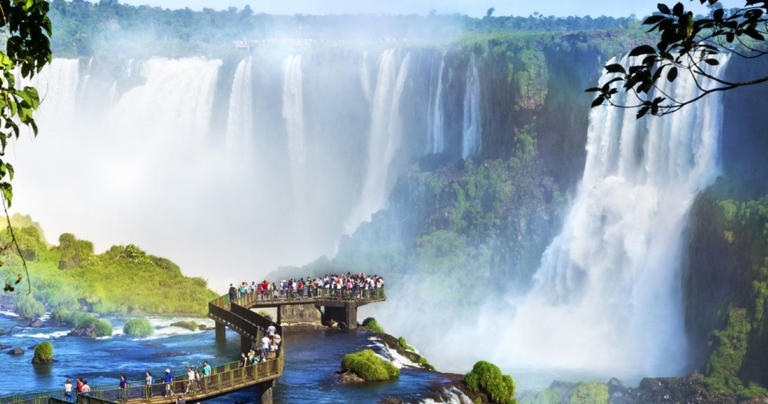

IMAGES
VIDEO
COMMENTS
6) Visit museums in Salvador. 7) Enjoy the benefits of Salvador's best neighborhoods. 8) Volunteer in Salvador - Brazil. 9) Immerse yourself in Salvador's culture. 10) Get to know the region's markets. 11) Observe the artistic works of Salvador. 12) Experience Salvador Carnaval.
Brazil, South America. Salvador da Bahia has an energy and unadorned beauty that few cities can match. Once Portugal's colonial capital, today Salvador is the pulsating heart of the country's Afro-Brazilian community. Festivals happen frequently, with drum corps pounding out rhythms against the backdrop of historic buildings almost daily.
Salvador Brazil: Quick travel tips before you go. 🛫 Airport: The closest airport to downtown, and the main state one, is International Salvador Airport, the code being SSA. 🤑 Currency: Like everywhere else in the country, the main currency here is the Brazilian Real, shown by the R$ symbol.
From 9pm-6am and all day Sundays and on public holidays, the metered rate goes from '1' to '2'. This means your fare will automatically increase by 25%. If you're outside those times, make sure the meter is set to '1' so you're not paying extra. Salvador is a large city, so catching taxis can become expensive.
10) 12 p.m. T-shirt formal. A half-hour up the coast on the ocean side is the artsy Itapuã neighborhood, best known as the former home of Vinicius de Moraes, the famed poet and bossa nova ...
6. Praia do Porto da Barra. 4,035. Beaches. Porto da Barra is one of the few points of land in Brazil that face west over the Atlantic Ocean (due to its unique geography near the entrance to the Bay of All Saints). Because of this, Porto da Barra Sundown Show features sunsets which are both spectacularly beautiful and endearing because of the ...
The inside guide to Salvador, the cradle of Brazil's Afro-Brazilian heritage. Explore the Brazilian city and discover vibrant flavours, martial arts and an African heritage that lives on in ...
I wanted to know your thoughts for travel to Salvador (and other parts of Brazil) this November, 2020, in light of COVID-19. Any feedback/insight would be much appreciated! Thank you. A. Hassan. September 26, 2020 at 3:56 am . Reply. Jen Santos says: Hi Anser, indeed, Brazil is open to tourists. I can't speak for the rest of the country, but ...
Salvador, Brazil has a tropical climate including rainforests and lush vegetation. A 100-m cliff runs along the entire bayshore, dividing the city into Cidade Alta, up on the cliff, ... Bus travel in and out of Salvador can take a lot more time than expected. Count on an average speed of 50-60 km/h when planning your itinerary. By boat [edit]
Salvador. A 17th-century stone fortification that's administered by the Navy. Discover the best attractions in Salvador including Igreja NS do Bonfim, Pelourinho, and Museu Náutico da Bahia.
6. Hit the Beach. Capital of joy, axé, acarajé, and full of history, Salvador is home to some of the best beaches in Bahia. So, if you are enjoying a vacation in Salvador, reserve a few days to hit a few Brazilian beaches. After all, sunbathing is one of the best things to do in Brazil.
Salvador Brazil looks amazing and is now getting added to my travel bucket list! My family and I appreciate your fantastic food recommendations, like the ones I posted in my Bali Itinerary, Vietnam Itinerary, and Bangkok Itinerary (and soon to be published, Thailand Itinerary!)
Elevador Lacerda. Salvador is a city on two levels. To connect the high and low parts of the city, a lift was built in 1873. The now Art Deco Lacerda Elevator bridges an 85-metre escarpment, taking the public up and down in thirty seconds, hundreds of times a day and giving breathtaking views of the bay and the city.
As one of Brazil's UNESCO world heritage sites, the old colonial neighborhood of Pelourinho has become one of the best places in Brazil to learn about Afro-Brazilian heritage here in Brazil. You will find that Pelourinho is located within the upper city. 💡 Smart Travel Tip In Salvador use Uber for getting around.
Get information on Salvador and the Bahia Coast Travel Guide - Expert Picks for your Vacation hotels, restaurants, entertainment, shopping, sightseeing, and activities. Read the Fodor's reviews ...
The closest airport to the city of Salvador is Salvador-Deputado Luís Eduardo Magalhães International Airport, which is at best 30 minutes by car from the Pelourinho area. However, Salvador sits on a peninsula, so traffic can get congested at times. Be aware and plan your travel time accordingly so you can enjoy more of this amazing city.
TAP Portugal flies from Gatwick to Salvador airport (20) via Lisbon. Bespoke Brazil (bespokebrazil.com) can arrange city and regional tours and airport pick-ups. Get into the city via a metered ...
Take a day trip to Arembepe Beach. To experience the best of Bahia, you've got to get out of town. Head to the small coastal town of Arembepe, about 27mi (45km) north of Salvador. There's a small hippie village located close to the city center, where the peace-and-love generation still sell crafts and locally grown produce.
Trip Length. 3-5 Days. 6-8 Days. 9-11 Days. 12-15 Days. 16+ Days. Undecided. Next 1/2. Explore one of Brazil's most historically-rich and beautiful cities with these fully-customizable Salvador Bahia tours and vacation packages.
Marisa Megan shares her tips on how to stay safe while exploring Salvador, Brazil. Salvador is the home of Baiano culture, beautiful beaches and colorful buildings. If you're planning a trip to Brazil, make sure you leave a few days to explore this wonderful city and the places that surround it. However, Salvador is not considered to be a ...
Weather is perfect this time of year in Salvador to be enjoyable for warm weather travelers. The average high during this season is between 86.7°F (30.4°C) and 84.9°F (29.4°C). On average, it rains or snows a smalll amount: 1 to 2 times per month. These times of year are the busiest with tourists. Best Times to Travel› Brazil › Salvador ...
Salvador Trade Center-Torre Sul, Room 1401 41820-020 - Salvador, Bahia Brazil ... 2025, a visa will be required for U.S. citizens to travel to Brazil, regardless of the purpose of travel. For more information about visa requirements, visit the Brazilian government-authorized website, https://brazil.vfsevisa.com.
Salvador and around - plan your visit with Rough Guides and get travel tips, recommendations and advice for where to go and what to do. New! ... The Rough Guides to Brazil and related travel guides. In-depth, easy-to-use travel guides filled with expert advice. Buy US$28.99. Buy US$34.99. Buy US$34.99. Buy US$29.99.
Receive up to 40% off available accommodation bookings in the US including AK, HI, Puerto Rico, and US Virgin Islands and bookings for international travel. Discount is applied to price of room before taxes and any fees, including additional fees collected by the property at check-in. Reservations can only be made up to eleven months in advance ...
But beyond Rio de Janeiro is a rich combination of islands, wetlands, nature, and bustling cities waiting to be discovered. These are 10 of the best places to visit in Brazil from Iguazu falls all ...